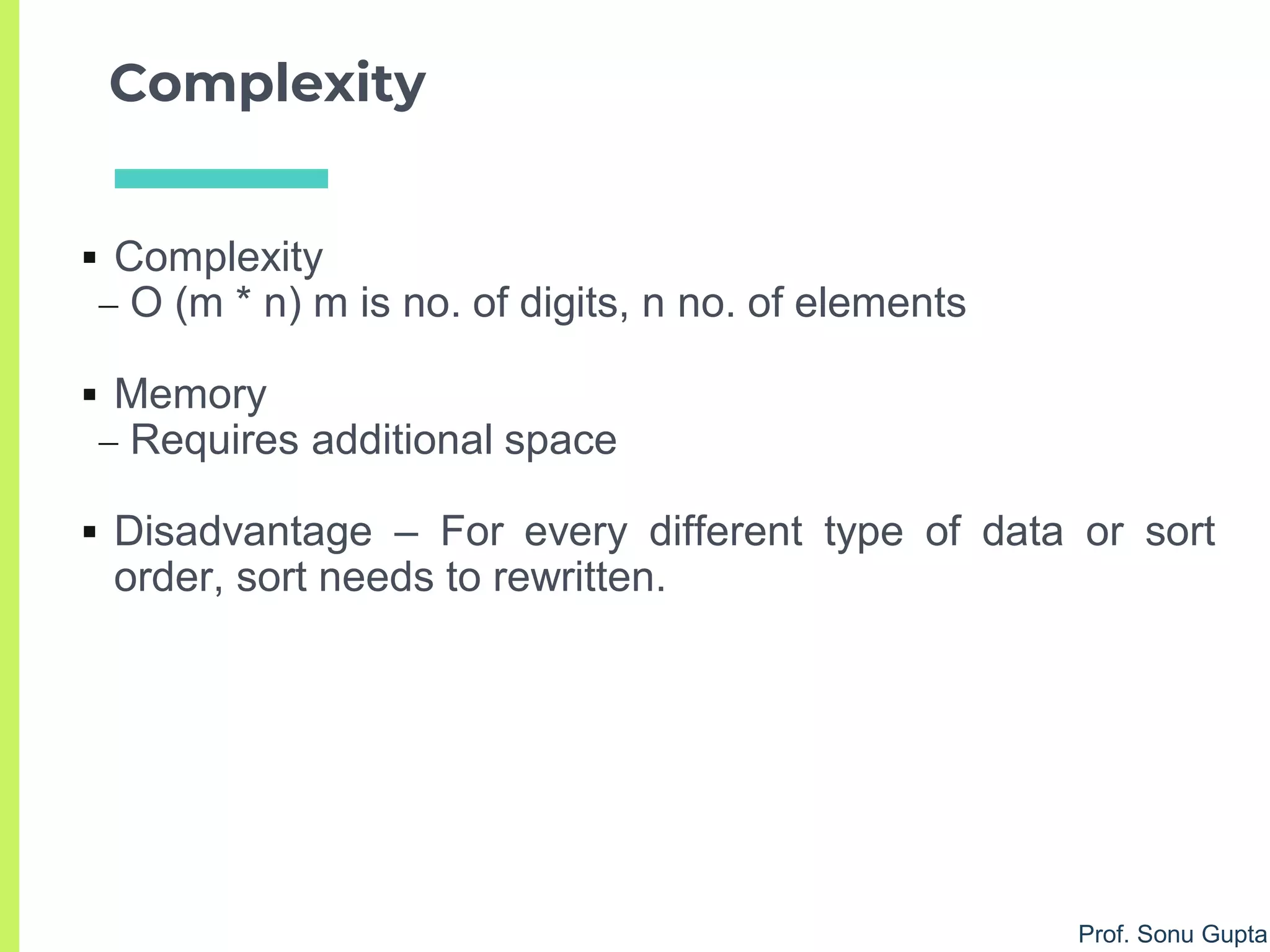The document discusses various sorting algorithms, including bubble sort, selection sort, and insertion sort, outlining their mechanisms, complexities, and key concepts such as sort stability and order. It includes algorithms for both basic and optimized bubble sort, along with examples demonstrating how to sort given arrays. Additionally, it touches upon shell sort and its approach to diminishing increments for effective sorting.

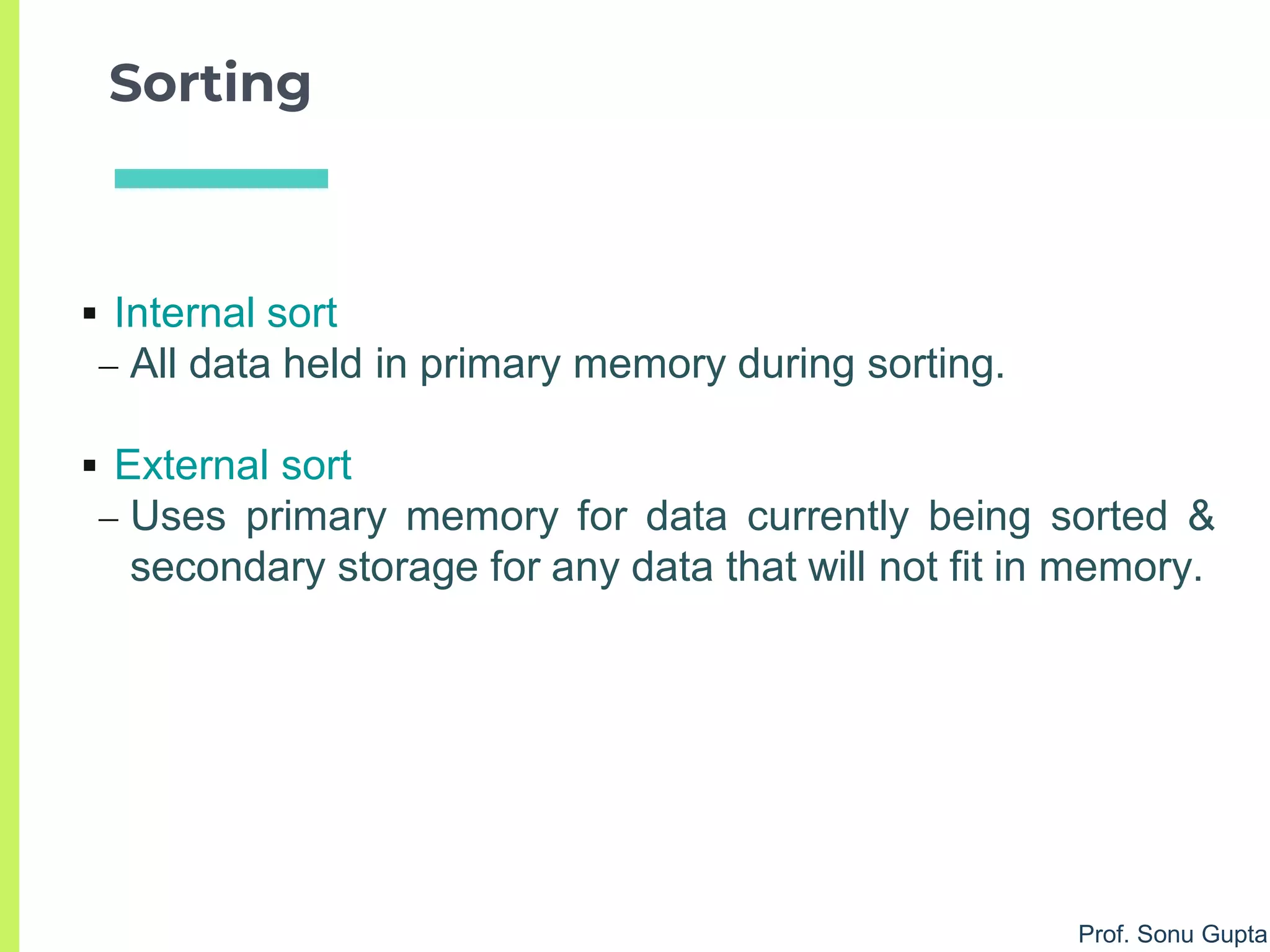
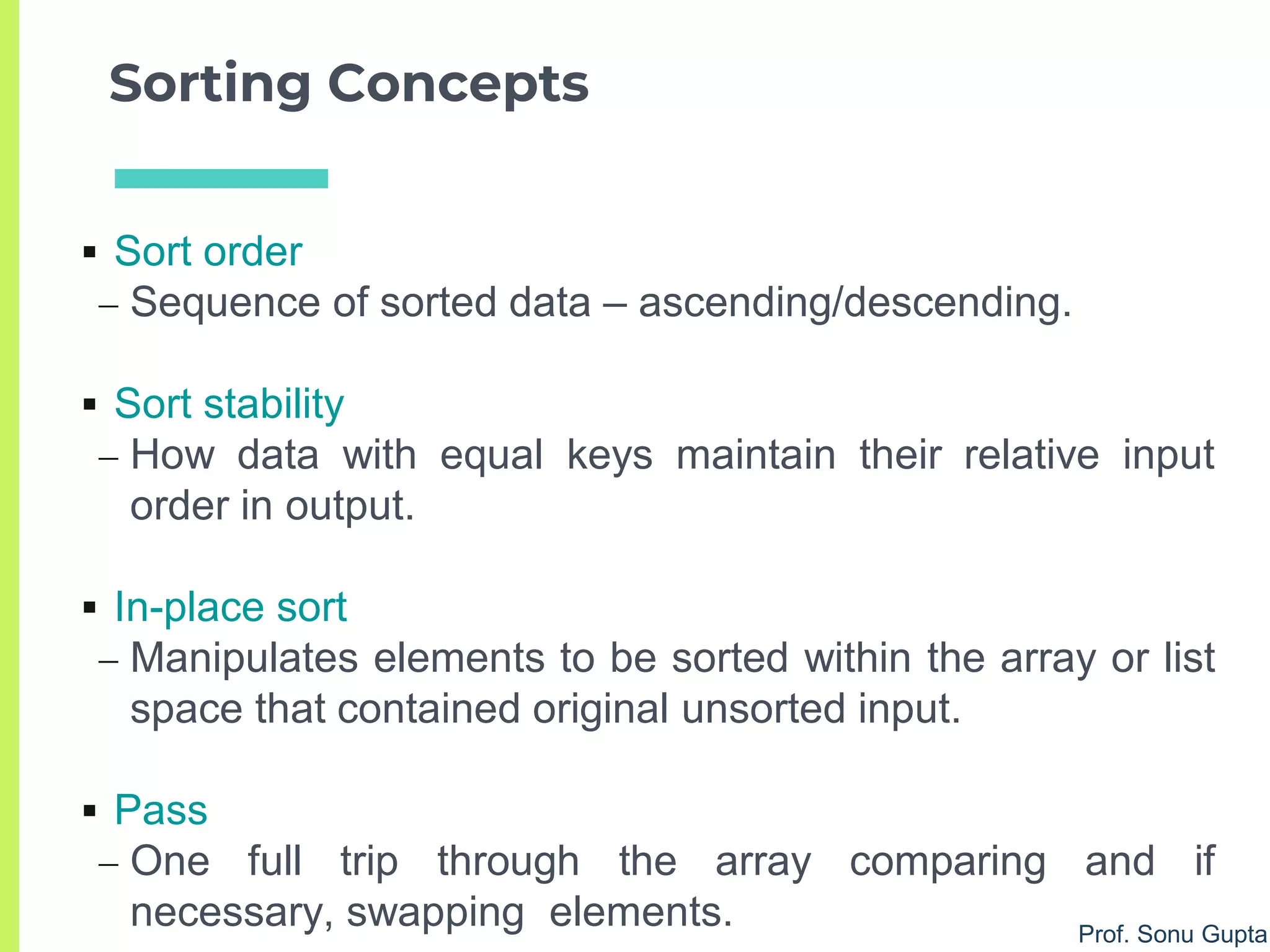
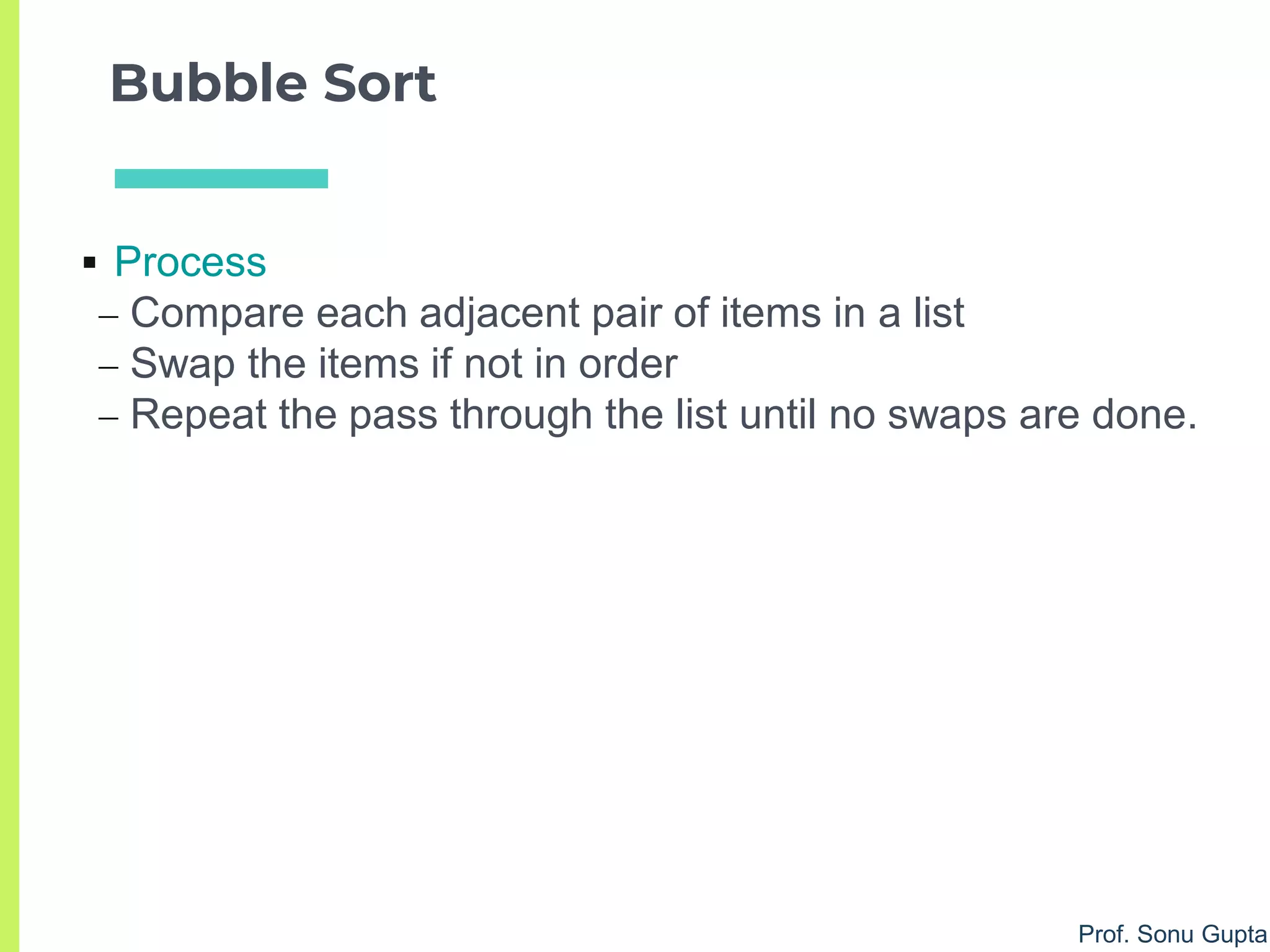
![Prof. Sonu Gupta
0
10
20
30
40
50
60
70
[1] [2] [3] [4] [5] [6]
0
10
20
30
40
50
60
70
[1] [2] [3] [4] [5] [6]
Swap?
0
10
20
30
40
50
60
70
[1] [2] [3] [4] [5] [6]
Yes!
0
10
20
30
40
50
60
70
[1] [2] [3] [4] [5] [6]
Swap?](https://image.slidesharecdn.com/2sorting-190122084642/75/Sorting-algorithms-5-2048.jpg)
![Prof. Sonu Gupta
0
10
20
30
40
50
60
70
[1] [2] [3] [4] [5] [6]Swap?
0
10
20
30
40
50
60
70
[1] [2] [3] [4] [5] [6]
Swap?
0
10
20
30
40
50
60
70
[1] [2] [3] [4] [5] [6]
Yes! 0
10
20
30
40
50
60
70
[1] [2] [3] [4] [5] [6]
Swap?](https://image.slidesharecdn.com/2sorting-190122084642/75/Sorting-algorithms-6-2048.jpg)
![Prof. Sonu GuptaProcess Continues…….
0
10
20
30
40
50
60
70
[1] [2] [3] [4] [5] [6]
Yes!
I pass gets over….now
repeat again
0
10
20
30
40
50
60
70
[1] [2] [3] [4] [5] [6]
Swap?
0
10
20
30
40
50
60
70
[1] [2] [3] [4] [5] [6]
Swap?
Yes](https://image.slidesharecdn.com/2sorting-190122084642/75/Sorting-algorithms-7-2048.jpg)
![Prof. Sonu Gupta
Bubble Sort
Algorithm bubble (a, n)
Pre: Unsorted array ‘a’ of length ‘n’.
Post: Sorted array in ascending order of length n
1. for i = 1 to (n - 1) do //n-1 passes
1. for j = 0 to n - 2 do //n-1 comparison in every pass
1. if ( a[j] > a[j+1] ) //out of order
1. temp=a[j]
2. a[j]=a[j+1]
3. a[j+1]=temp](https://image.slidesharecdn.com/2sorting-190122084642/75/Sorting-algorithms-8-2048.jpg)
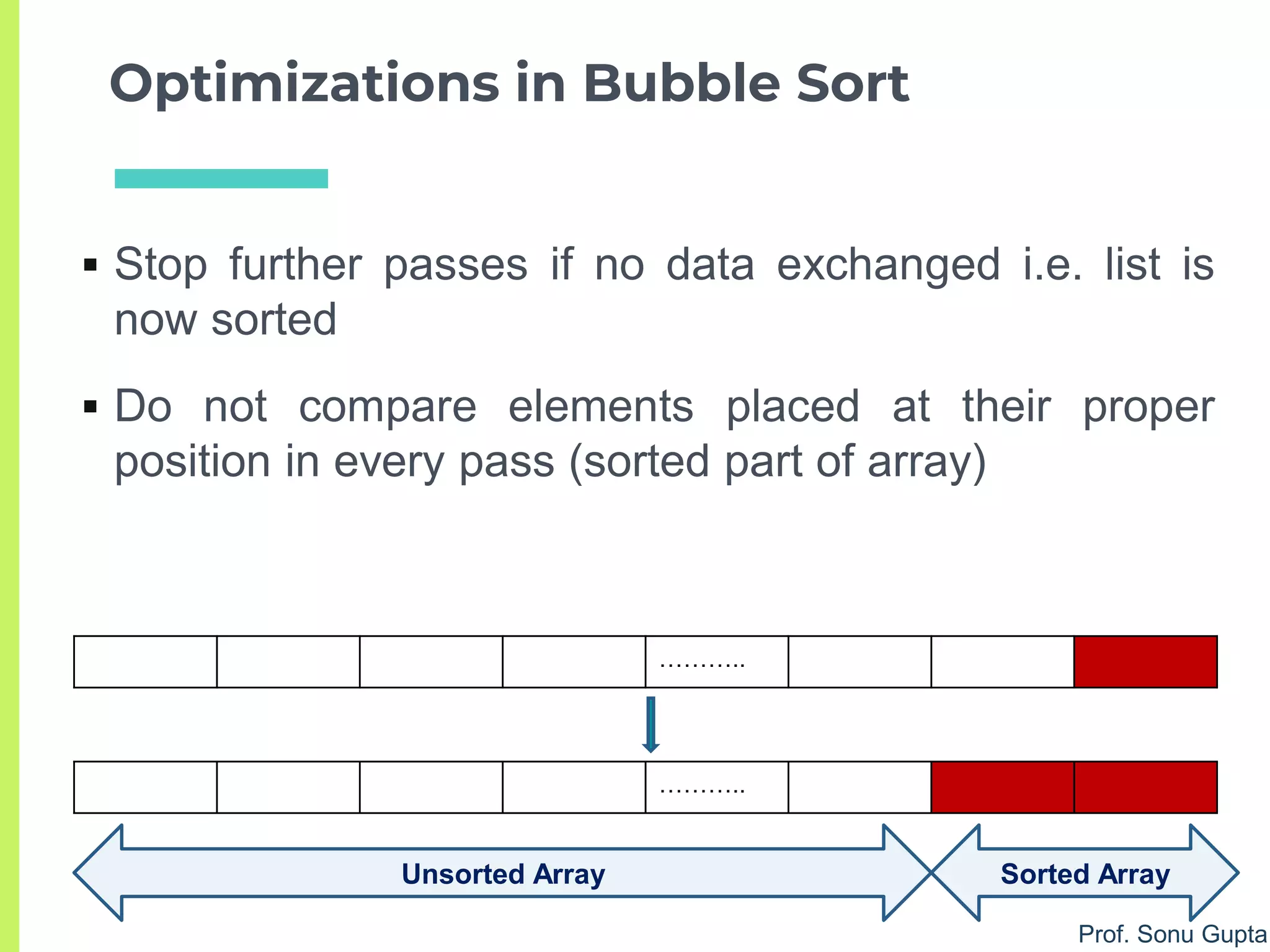
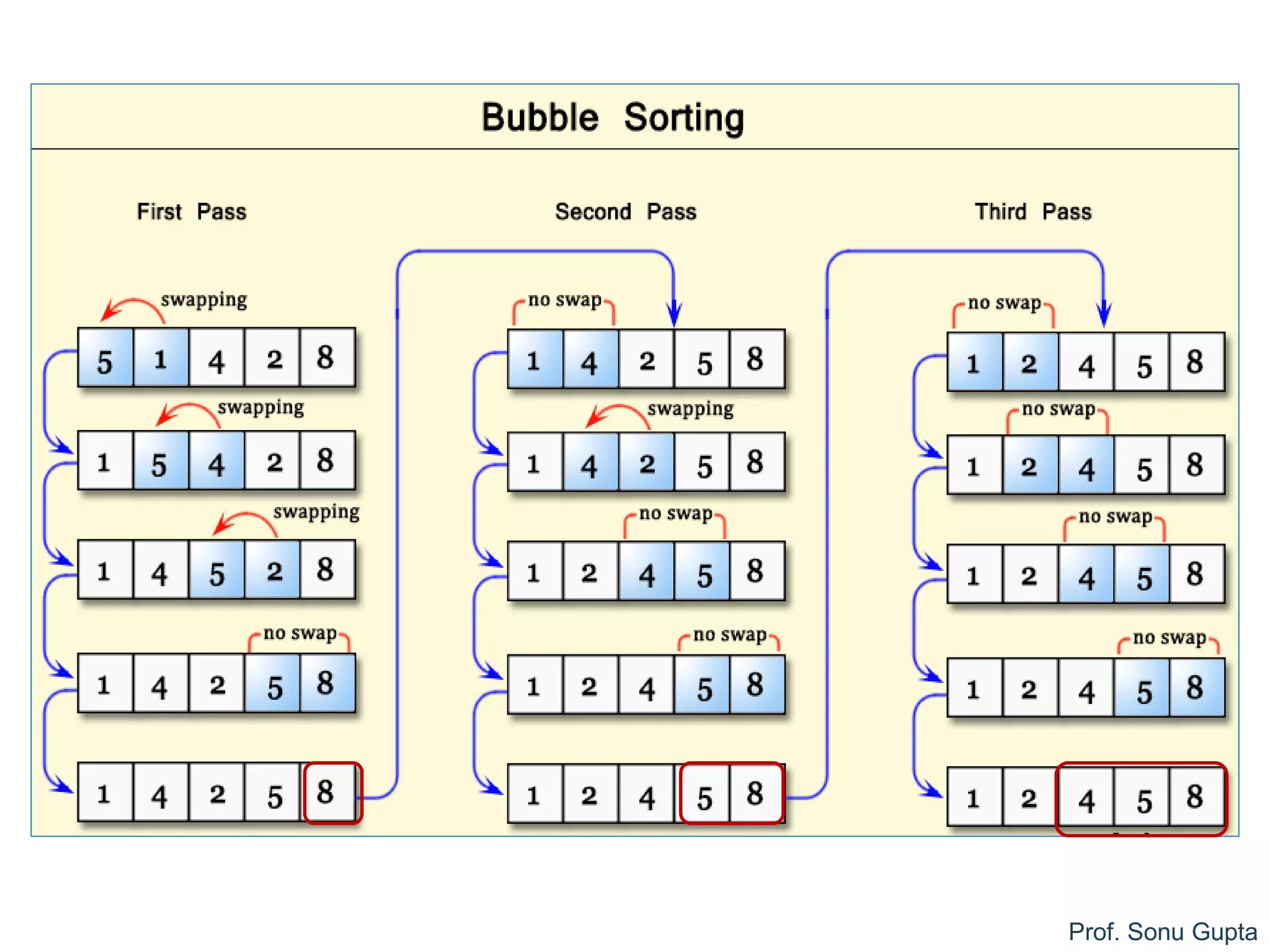
![Prof. Sonu Gupta
Bubble Sort - Optimized
Algorithm bubble (a, n)
Pre: Unsorted array ‘a’ of length ‘n’.
Post: Sorted array in ascending order of length n
1. for i = 1 to (n – 1) do // n-1 passes
1. test = 0
2. for j = 0 to ((n-1) – i ) do //don’t compare sorted data
1. if ( a[j] > a[j+1] )
1. temp=a[j]
2. a[j]=a[j+1]
3. a[j+1]=temp
4. test = 1 / / exchange happened
3. if (test = 0) // no exchange - list is now sorted
1. return](https://image.slidesharecdn.com/2sorting-190122084642/75/Sorting-algorithms-11-2048.jpg)
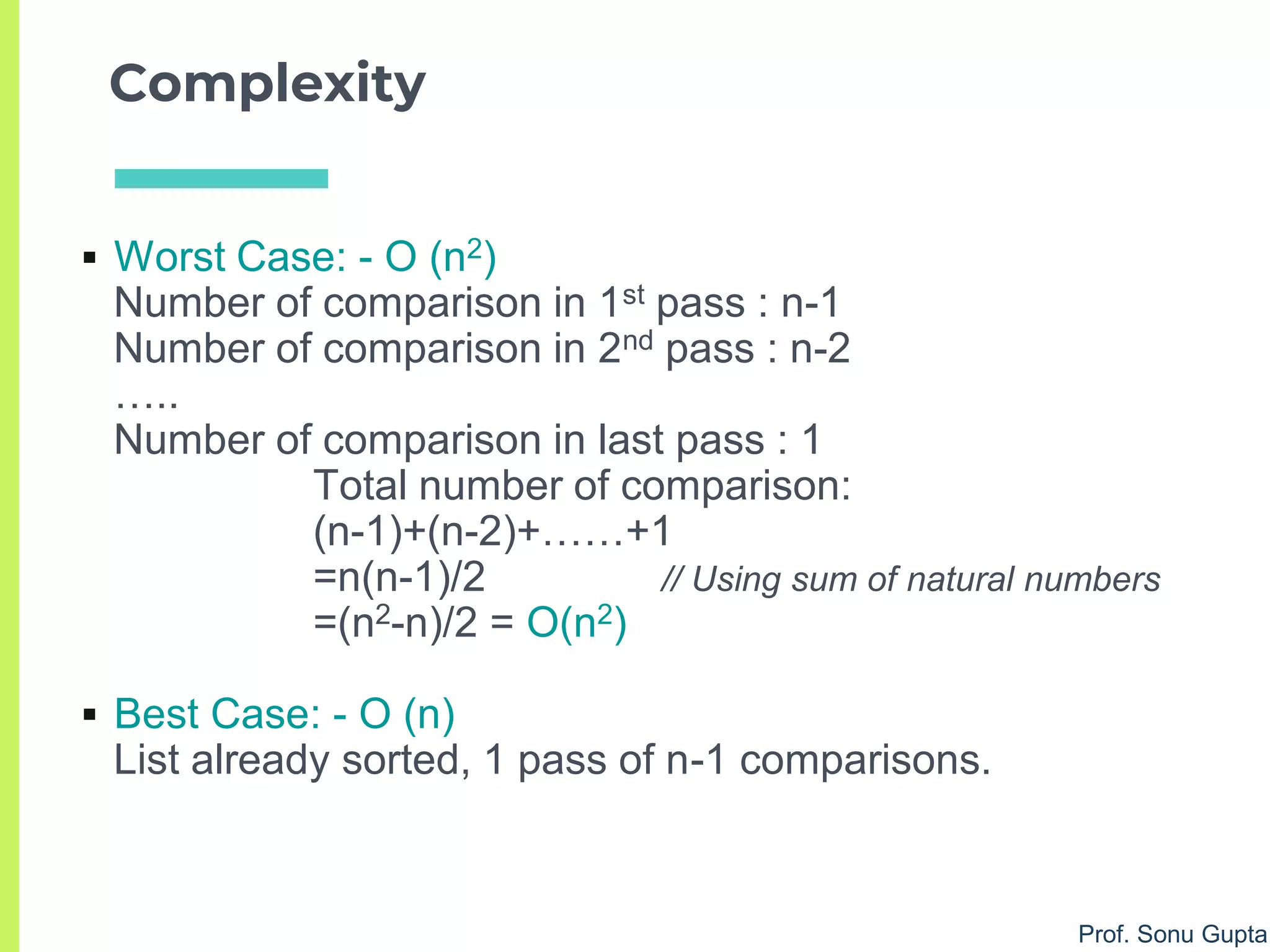
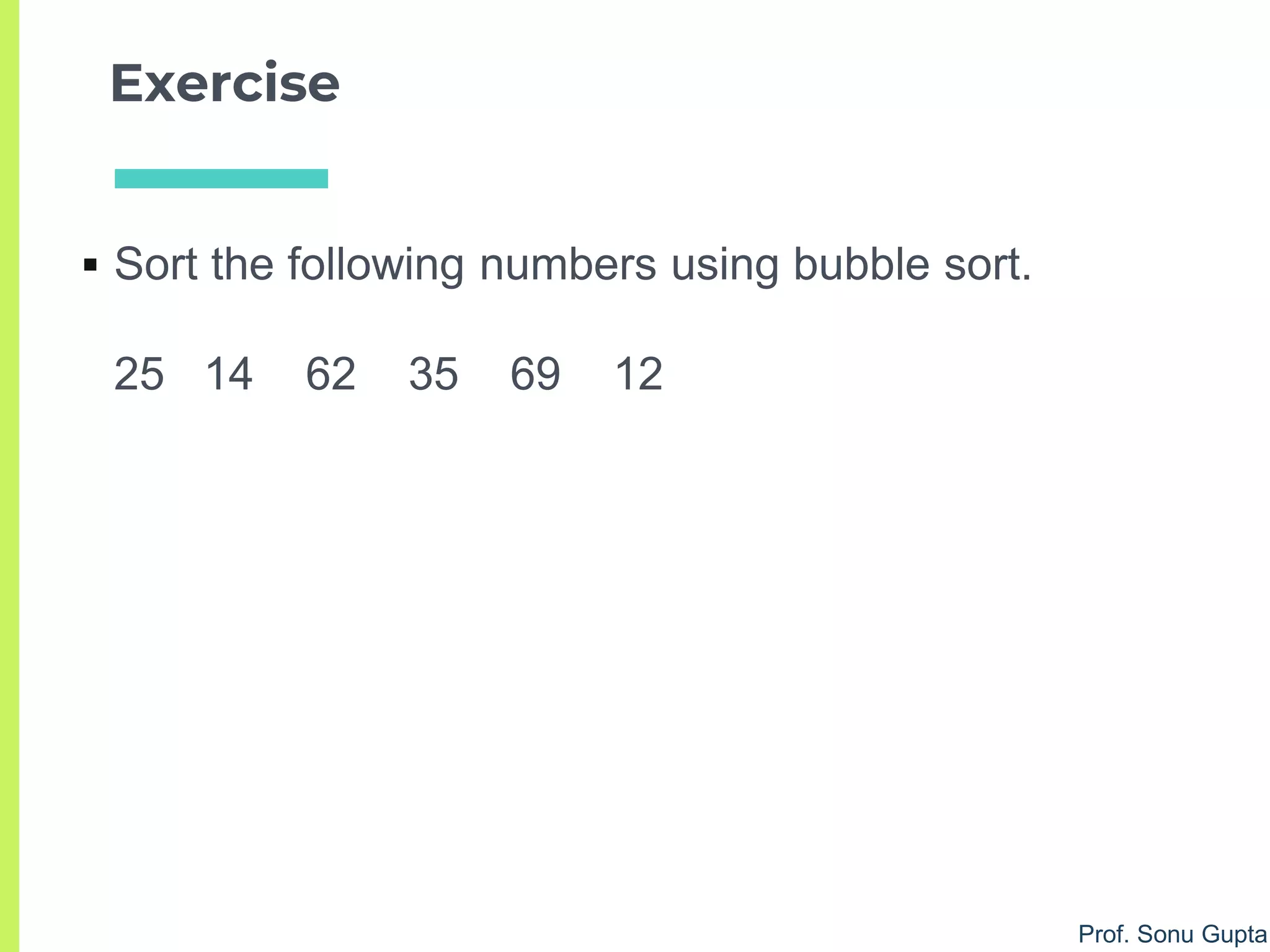
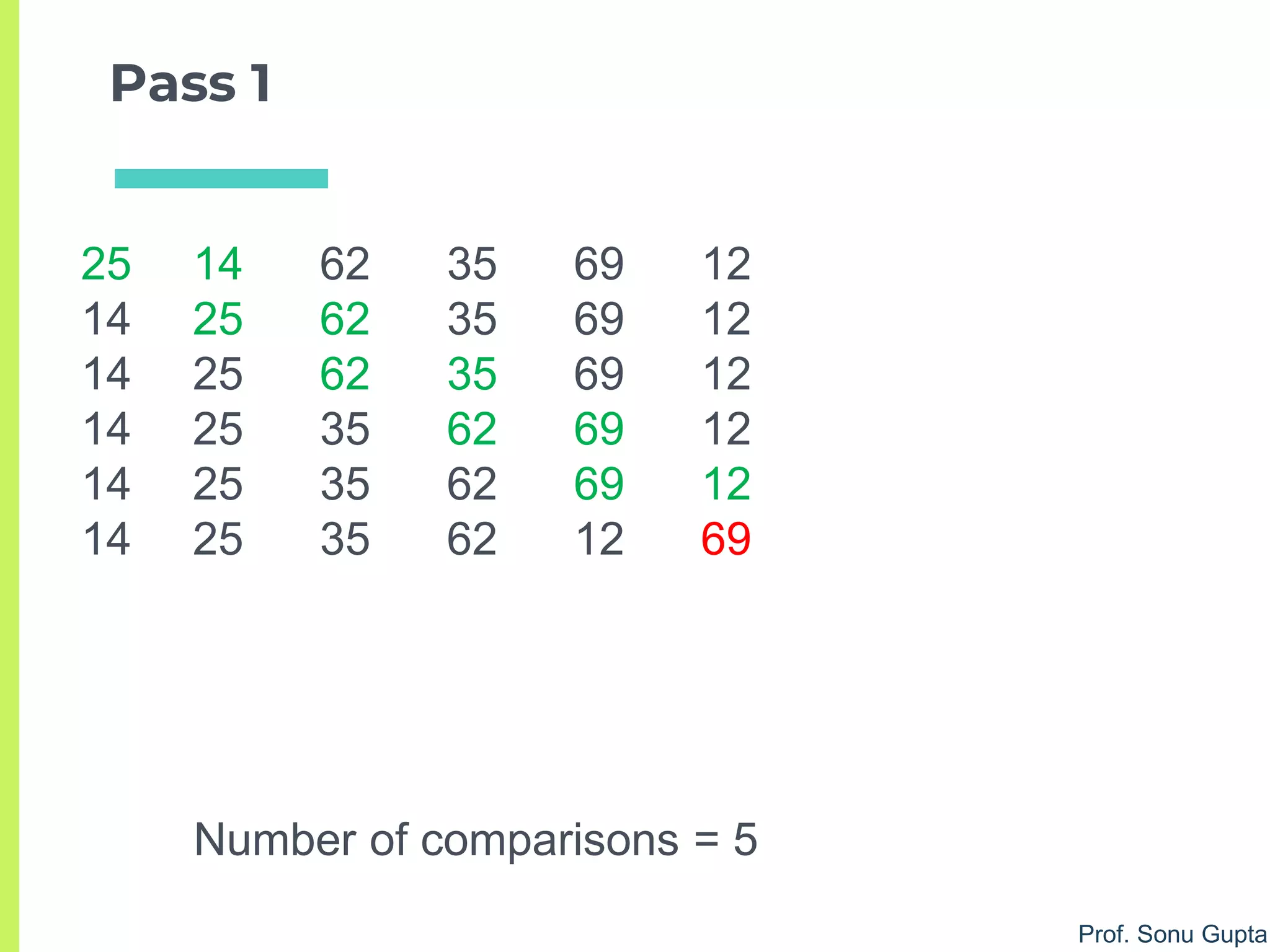
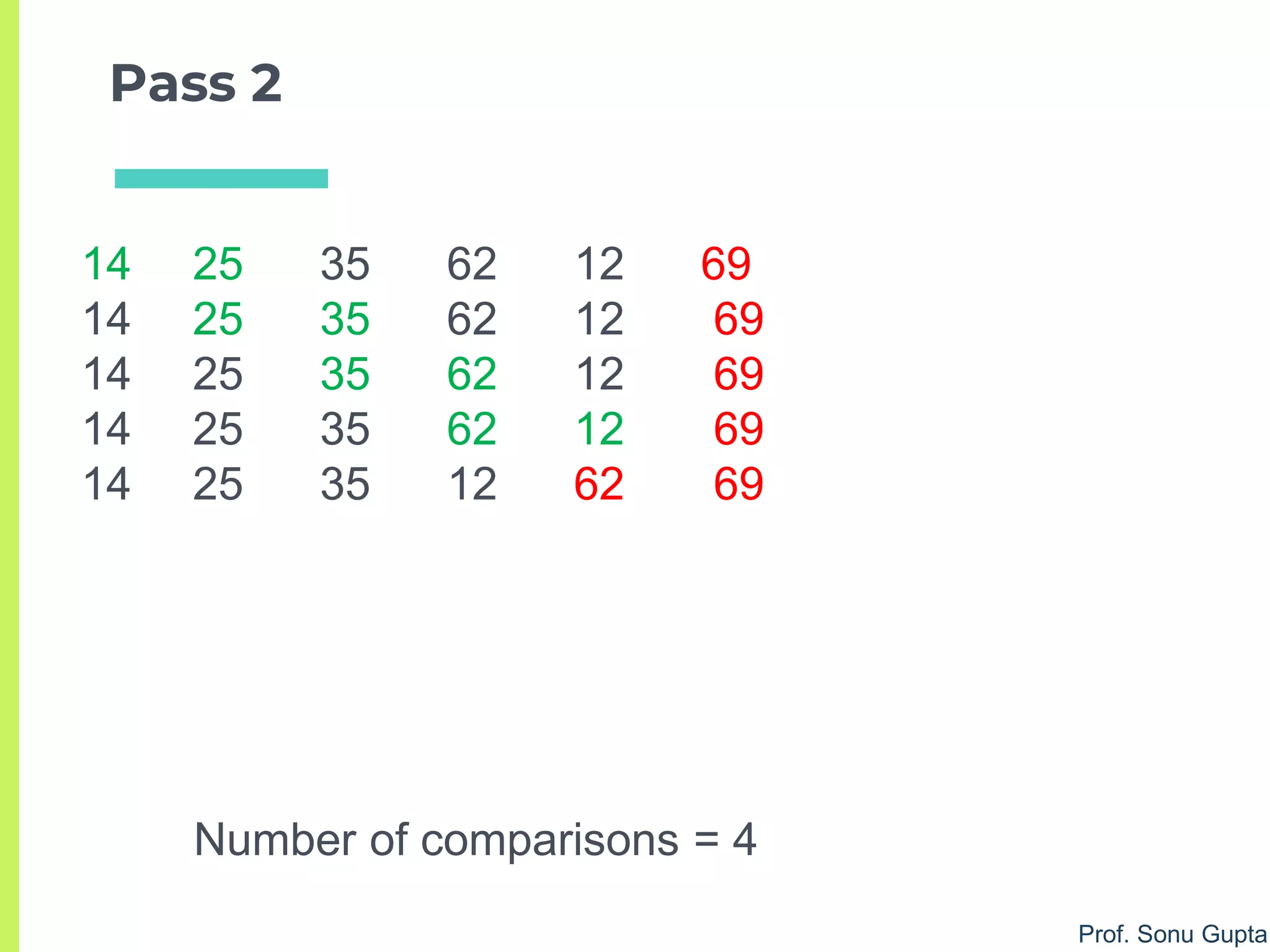
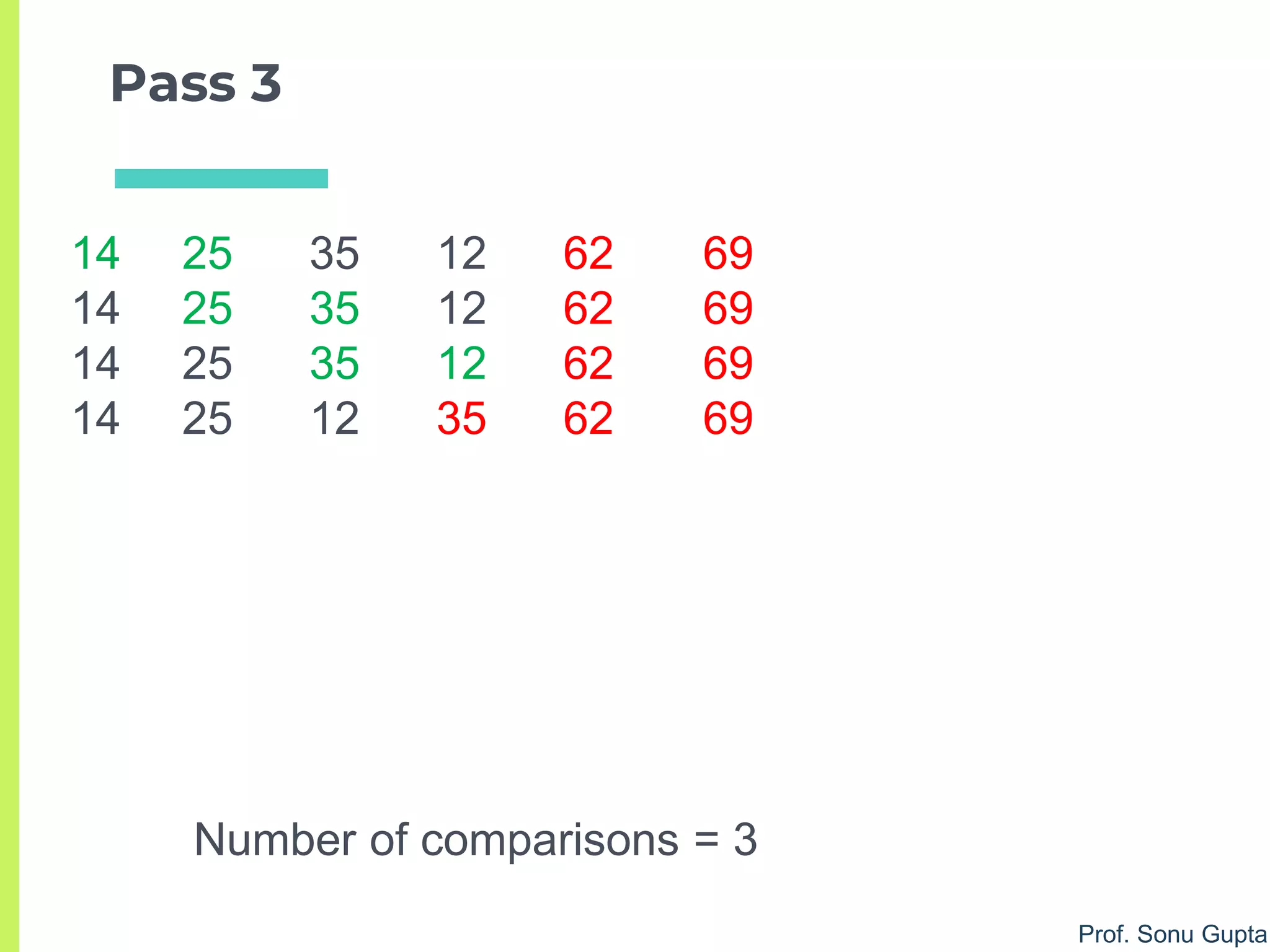
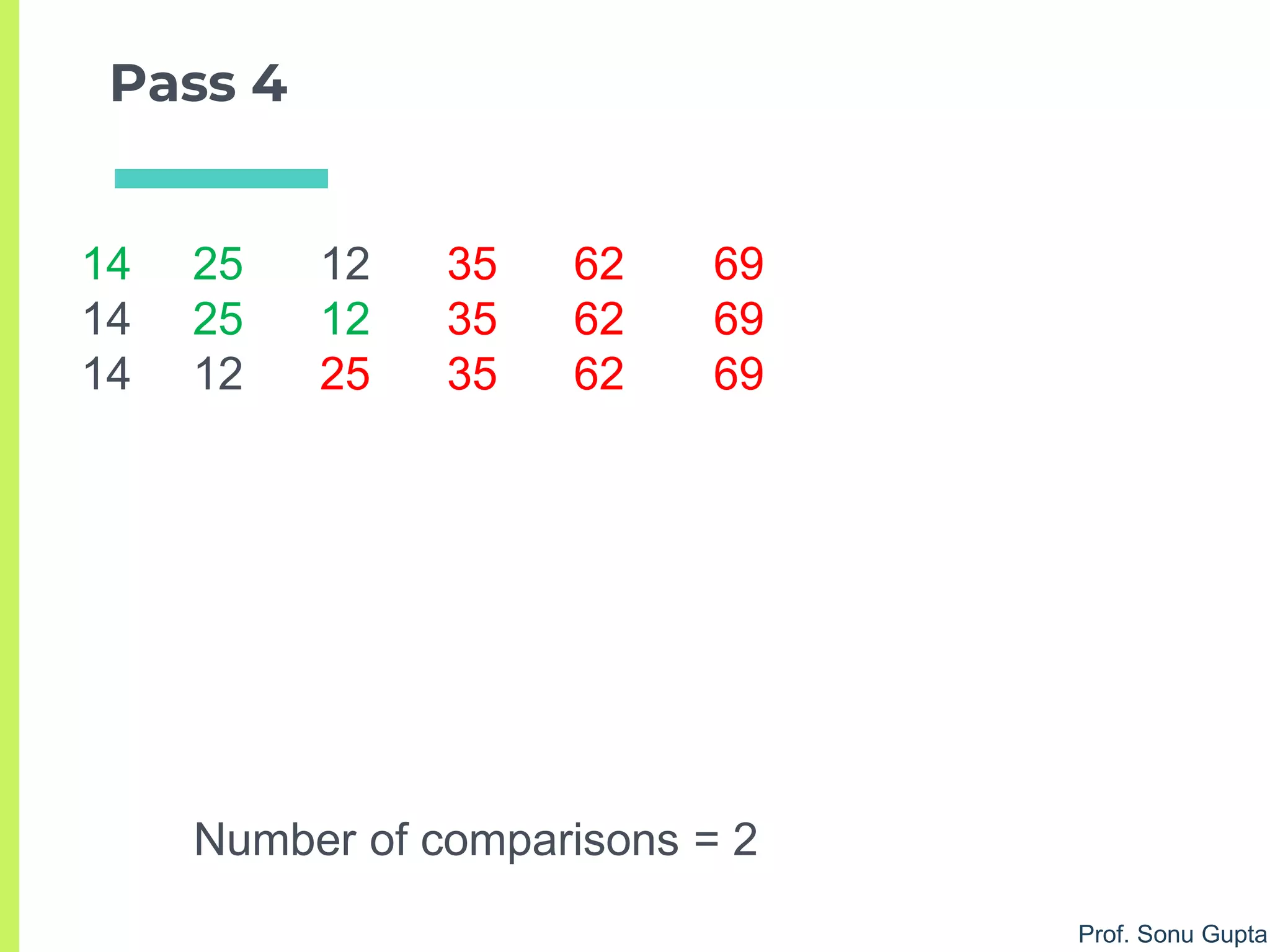
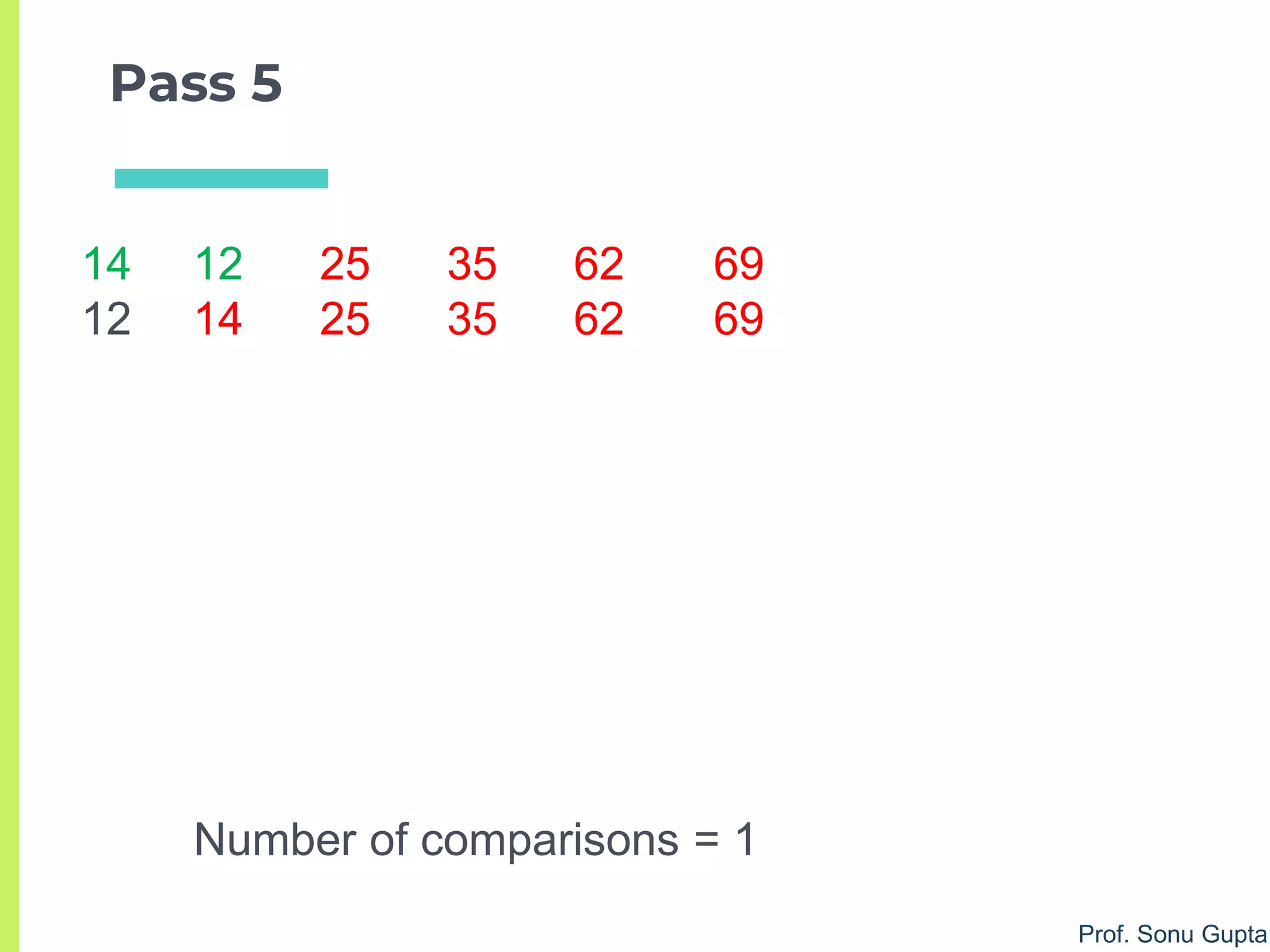
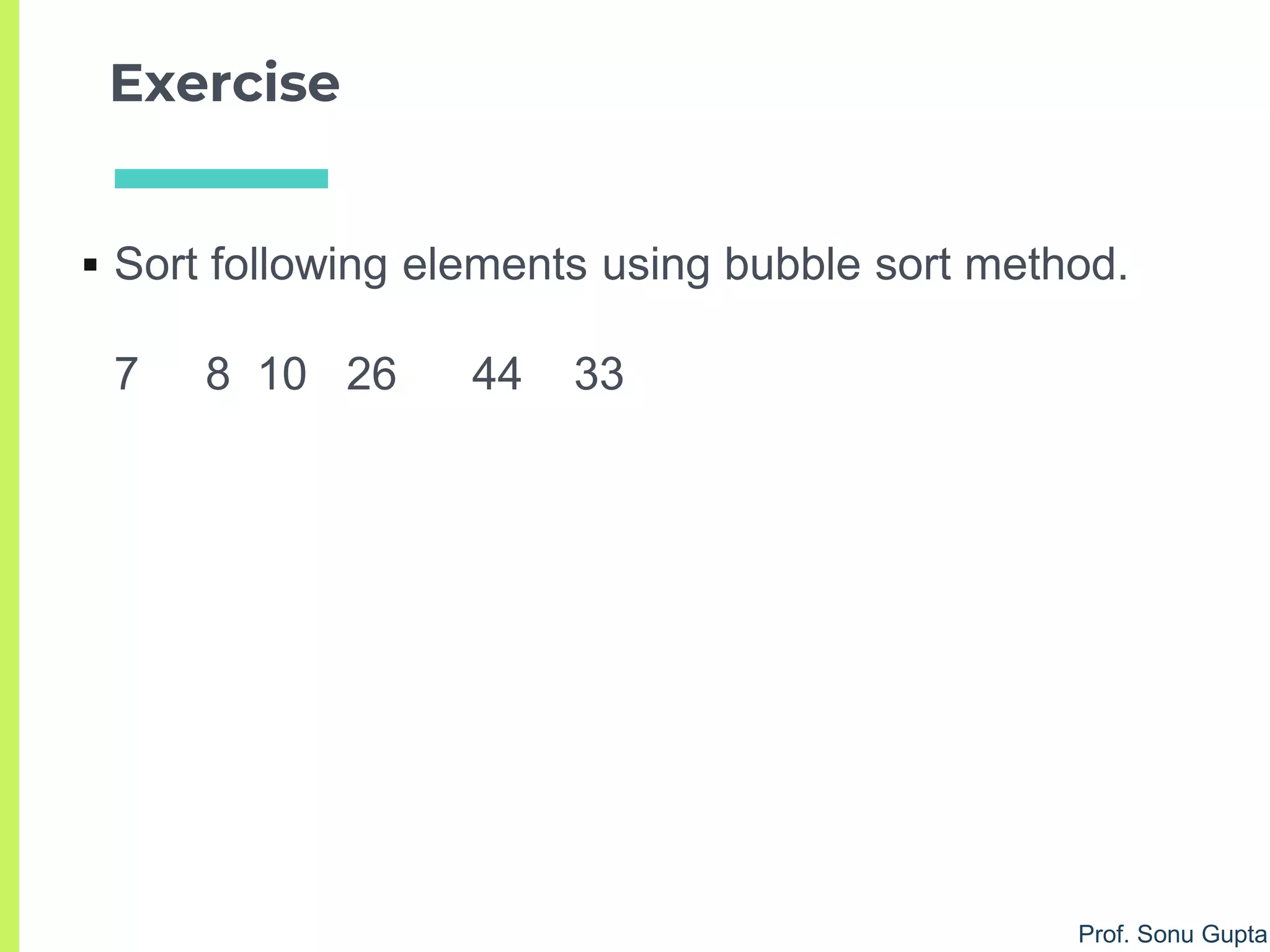
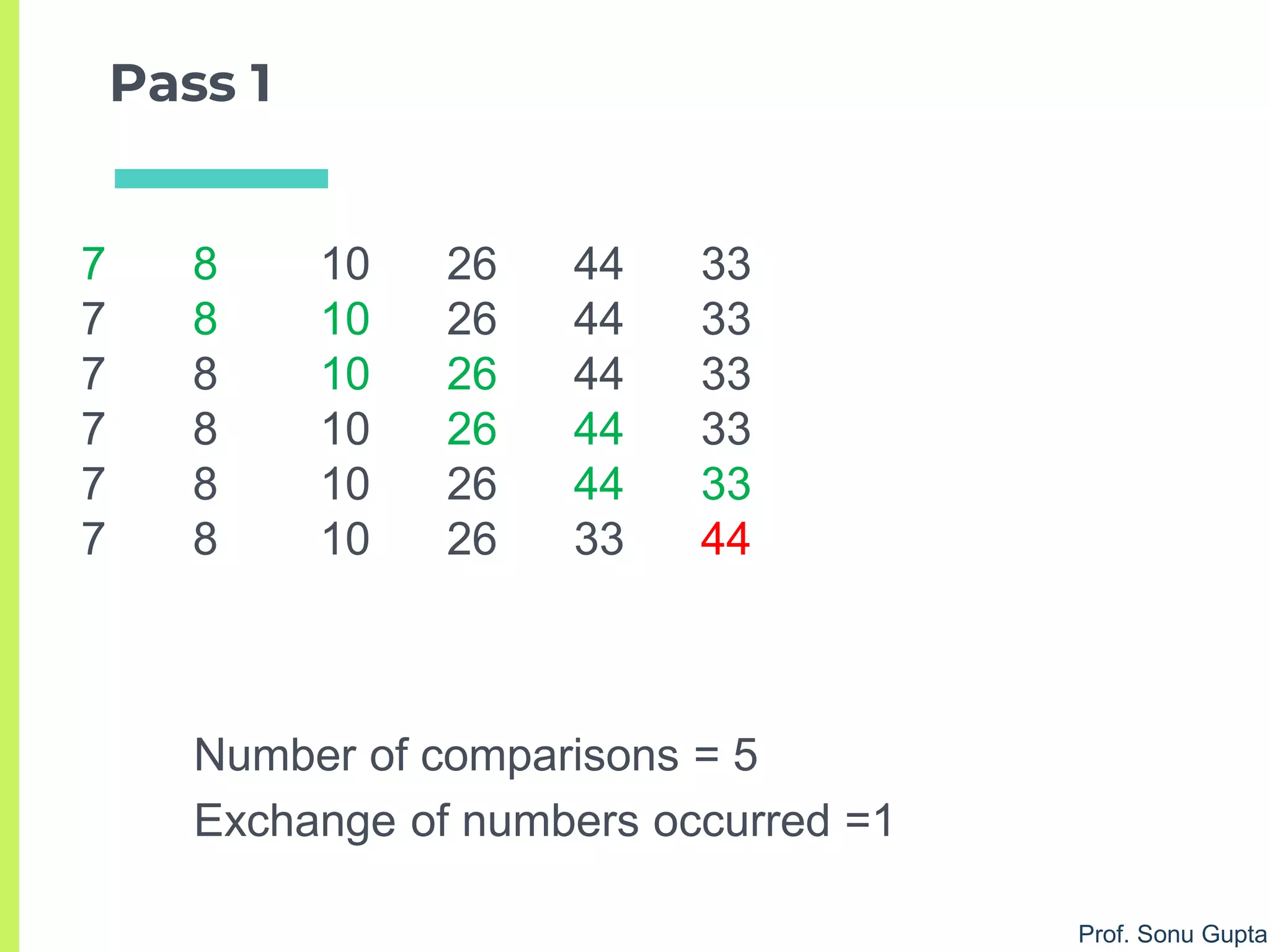
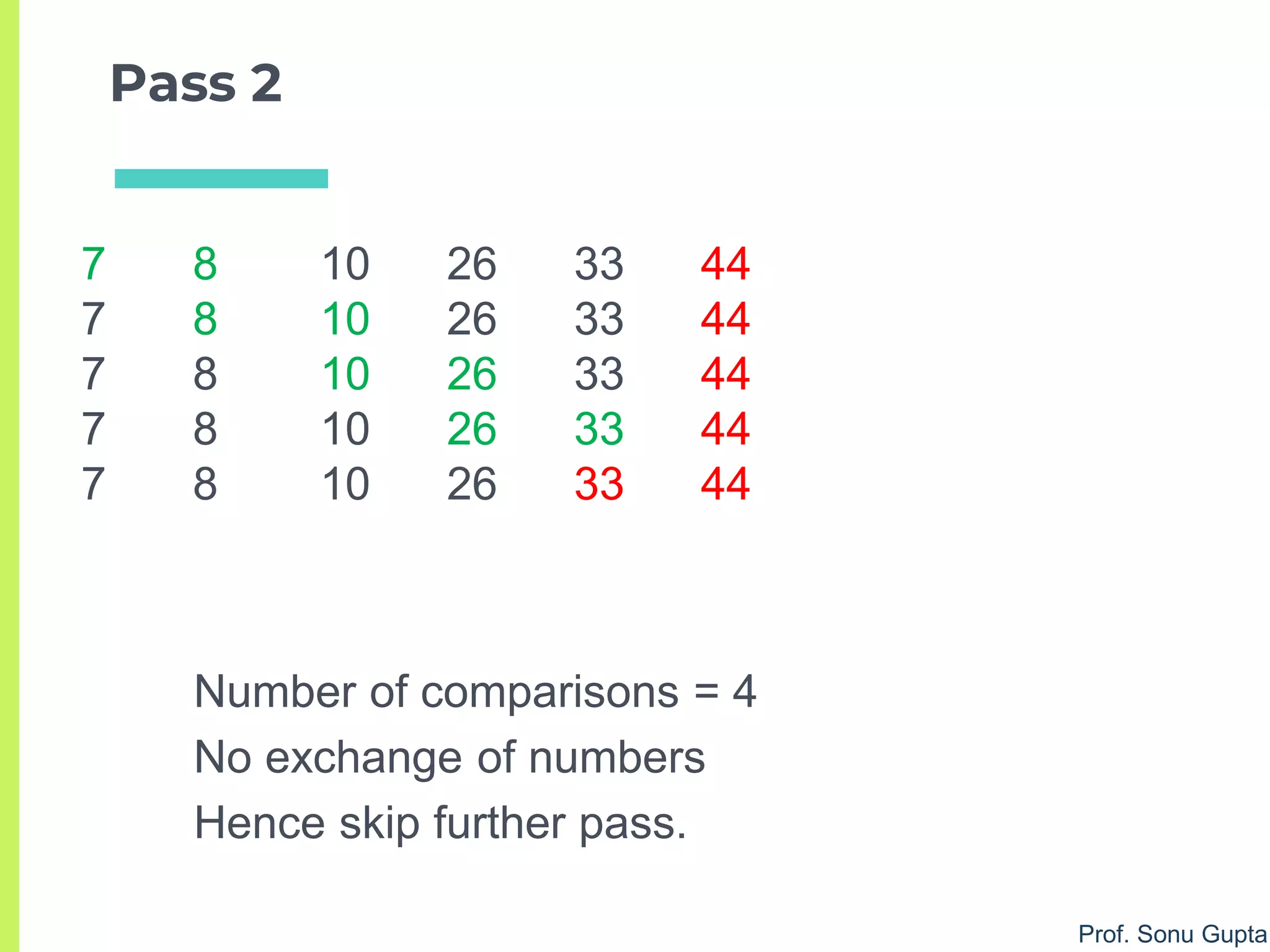
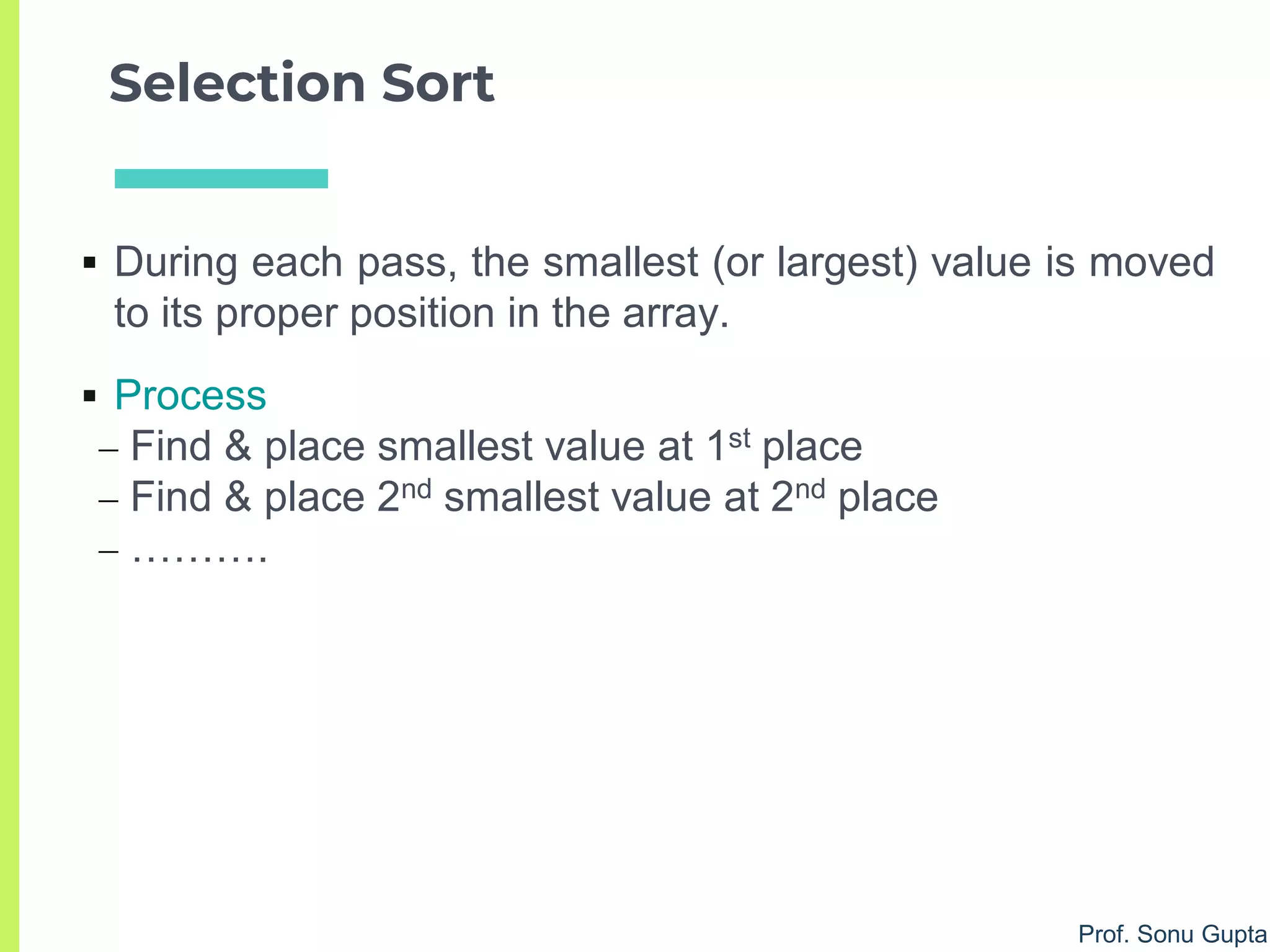
![Prof. Sonu Gupta
0
10
20
30
40
50
60
70
[1] [2] [3] [4] [5] [6]
0
10
20
30
40
50
60
70
[1] [2] [3] [4] [5] [6]
0
10
20
30
40
50
60
70
[1] [2] [3] [4] [5] [6]
0
10
20
30
40
50
60
70
[1] [2] [3] [4] [5] [6]
I pass gets over
0
10
20
30
40
50
60
70
[1] [2] [3] [4] [5] [6]
0
10
20
30
40
50
60
70
[1] [2] [3] [4] [5] [6]
Sorted side Unsorted side](https://image.slidesharecdn.com/2sorting-190122084642/75/Sorting-algorithms-23-2048.jpg)
![Prof. Sonu Gupta
0
10
20
30
40
50
60
70
[1] [2] [3] [4] [5] [6]
0
10
20
30
40
50
60
70
[1] [2] [3] [4] [5] [6]
Sorted side Unsorted side
0
10
20
30
40
50
60
70
[1] [2] [3] [4] [5] [6]
0
10
20
30
40
50
60
70
[1] [2] [3] [4] [5] [6]
Sorted side Unsorted side
0
10
20
30
40
50
60
70
[1] [2] [3] [4] [5] [6]
0
10
20
30
40
50
60
70
[1] [2] [3] [4] [5] [6]
Sorted side Unsorted side
Smallest
from
unsorted
0
10
20
30
40
50
60
70
[1] [2] [3] [4] [5] [6]
0
10
20
30
40
50
60
70
[1] [2] [3] [4] [5] [6]
Sorted side Unsorted side](https://image.slidesharecdn.com/2sorting-190122084642/75/Sorting-algorithms-24-2048.jpg)
![Prof. Sonu Gupta
0
10
20
30
40
50
60
70
[1] [2] [3] [4] [5] [6]
0
10
20
30
40
50
60
70
[1] [2] [3] [4] [5] [6]
Sorted side Unsorted side
Process Continues…….](https://image.slidesharecdn.com/2sorting-190122084642/75/Sorting-algorithms-25-2048.jpg)
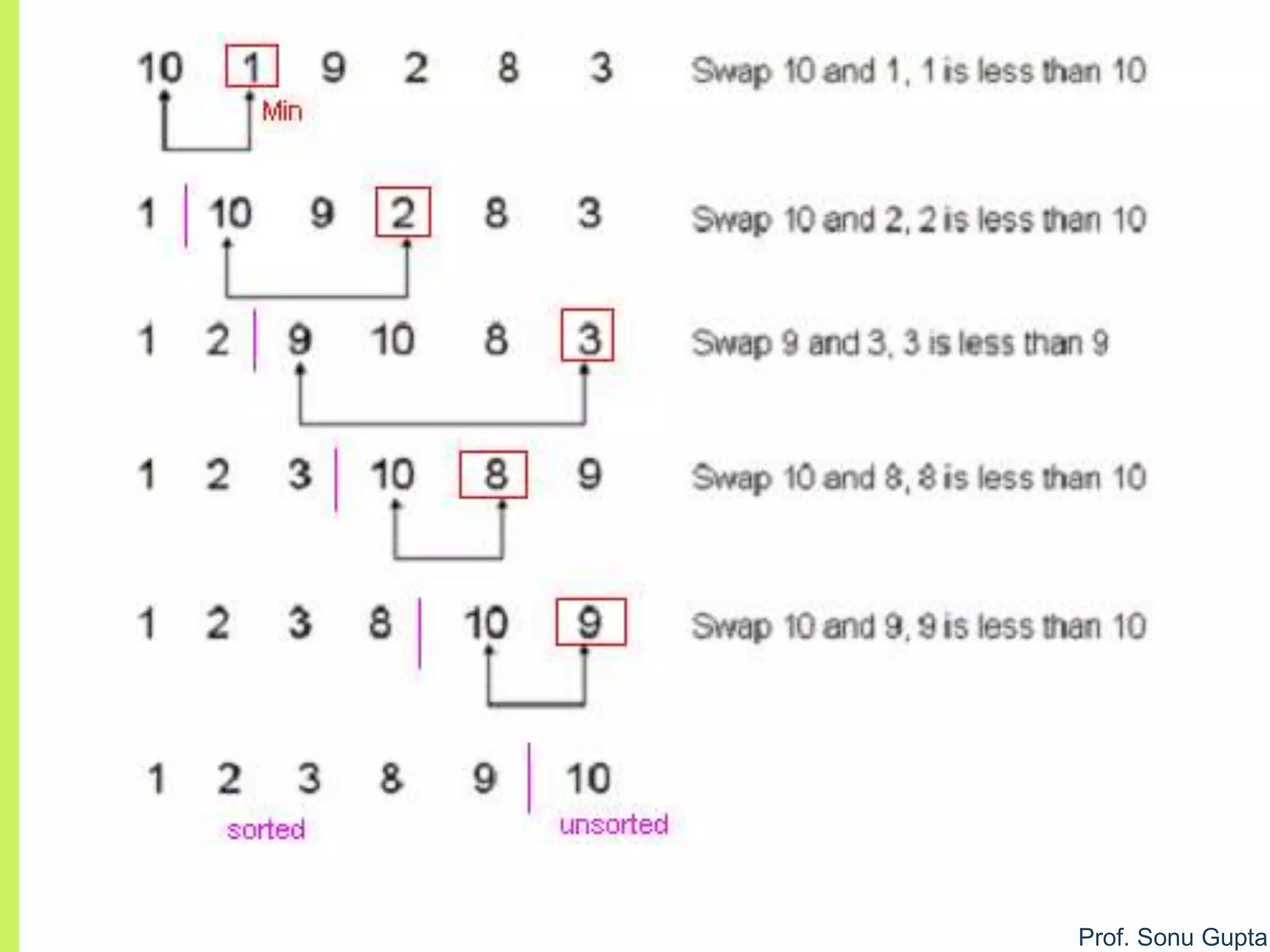
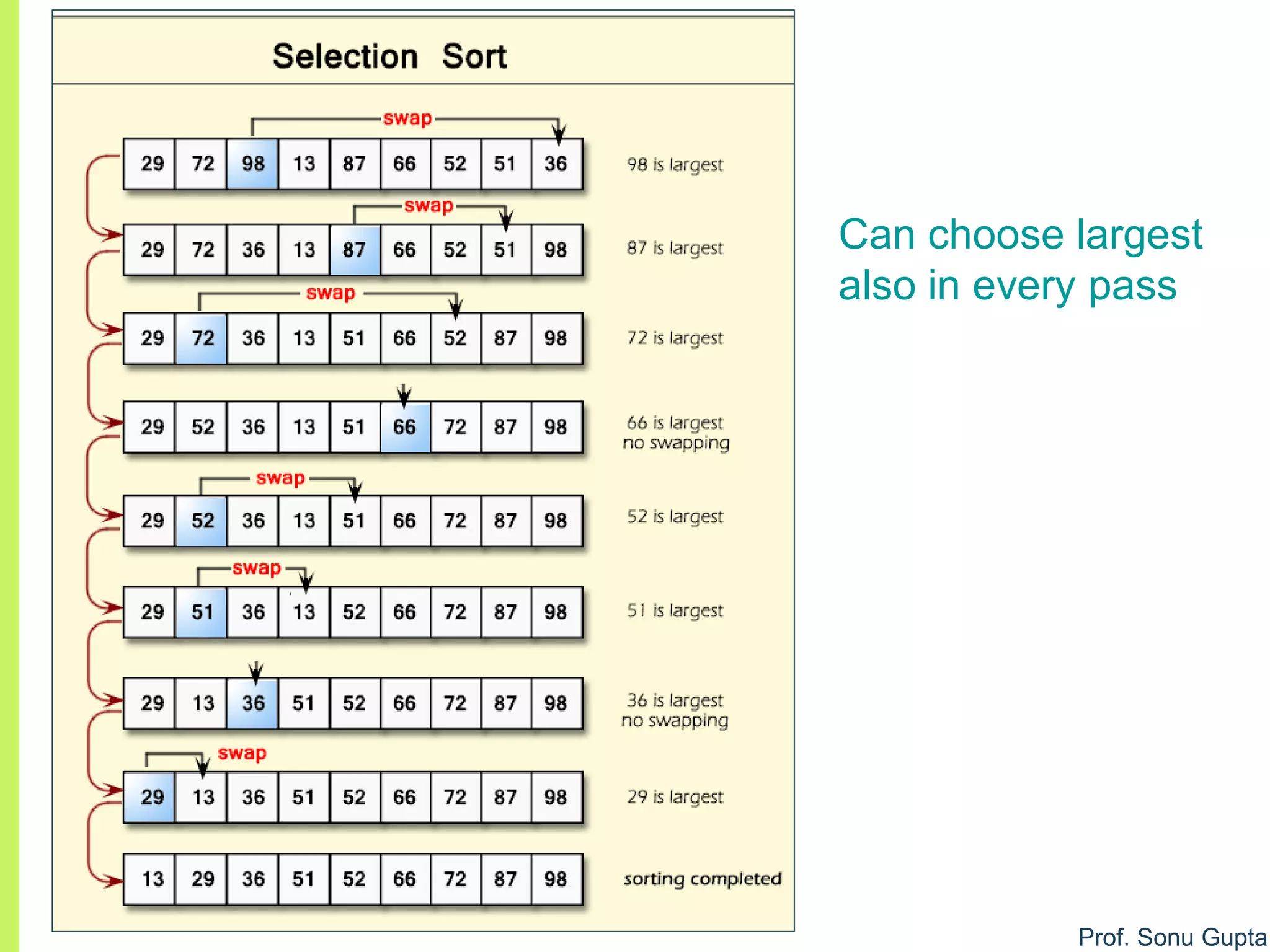
![Prof. Sonu Gupta
Selection Sort
Algorithm selection (a, length)
Pre: Unsorted array ‘a’ of length ‘n’.
Post: Sorted list in ascending order of length n
1. for i = 0 to (n -2) do // n-1 passes
1. min_index=i
2. for j = (i+1) to (n -1) do
1. if ( a[min_index] > a[j] )
1. min_index = j
3. if (min_index < > i) // place ith smallest element at ith place
1. temp= a[i]
2. a[i]=a[min_index]
3. a[min_index]=temp](https://image.slidesharecdn.com/2sorting-190122084642/75/Sorting-algorithms-28-2048.jpg)
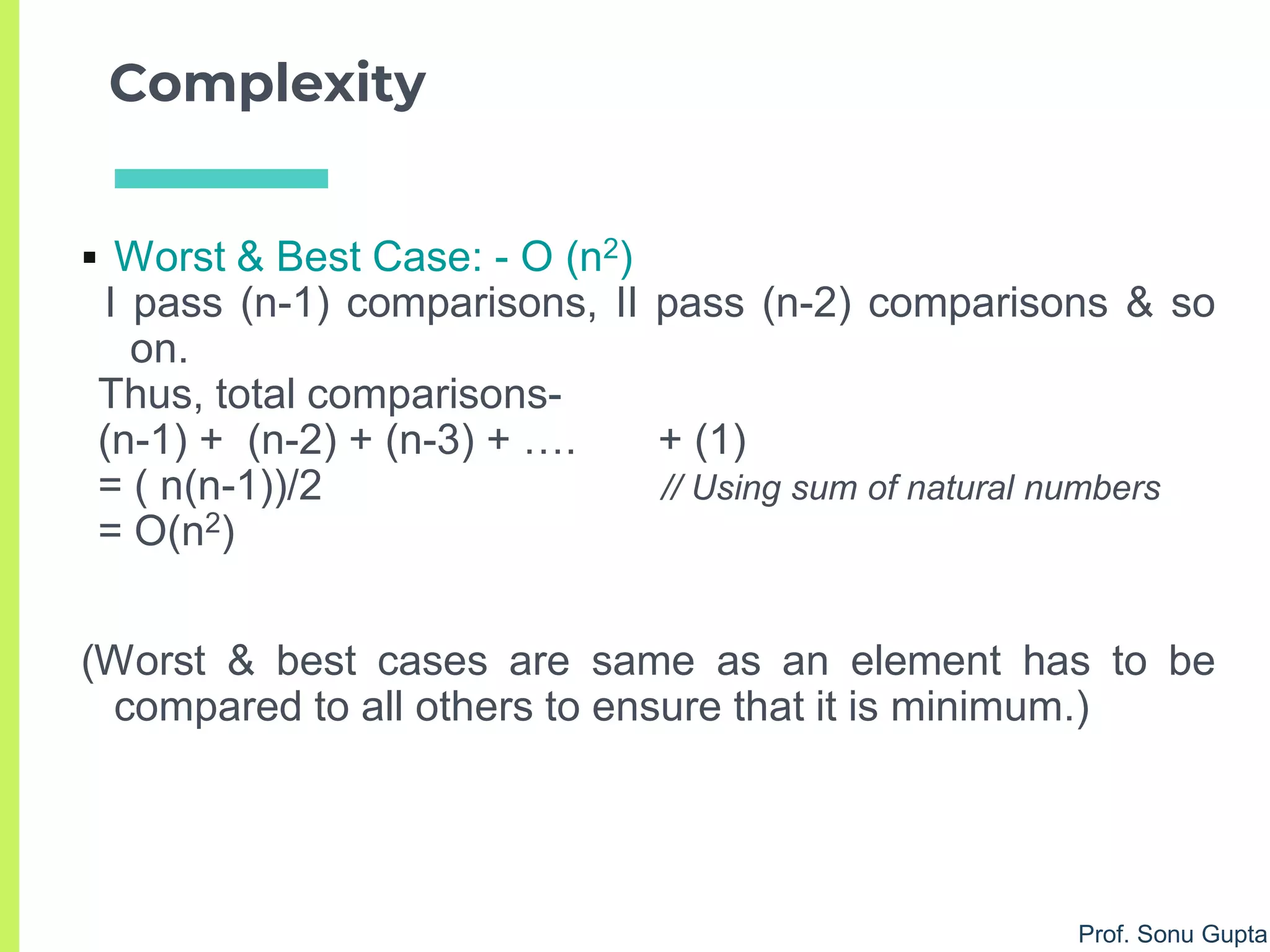
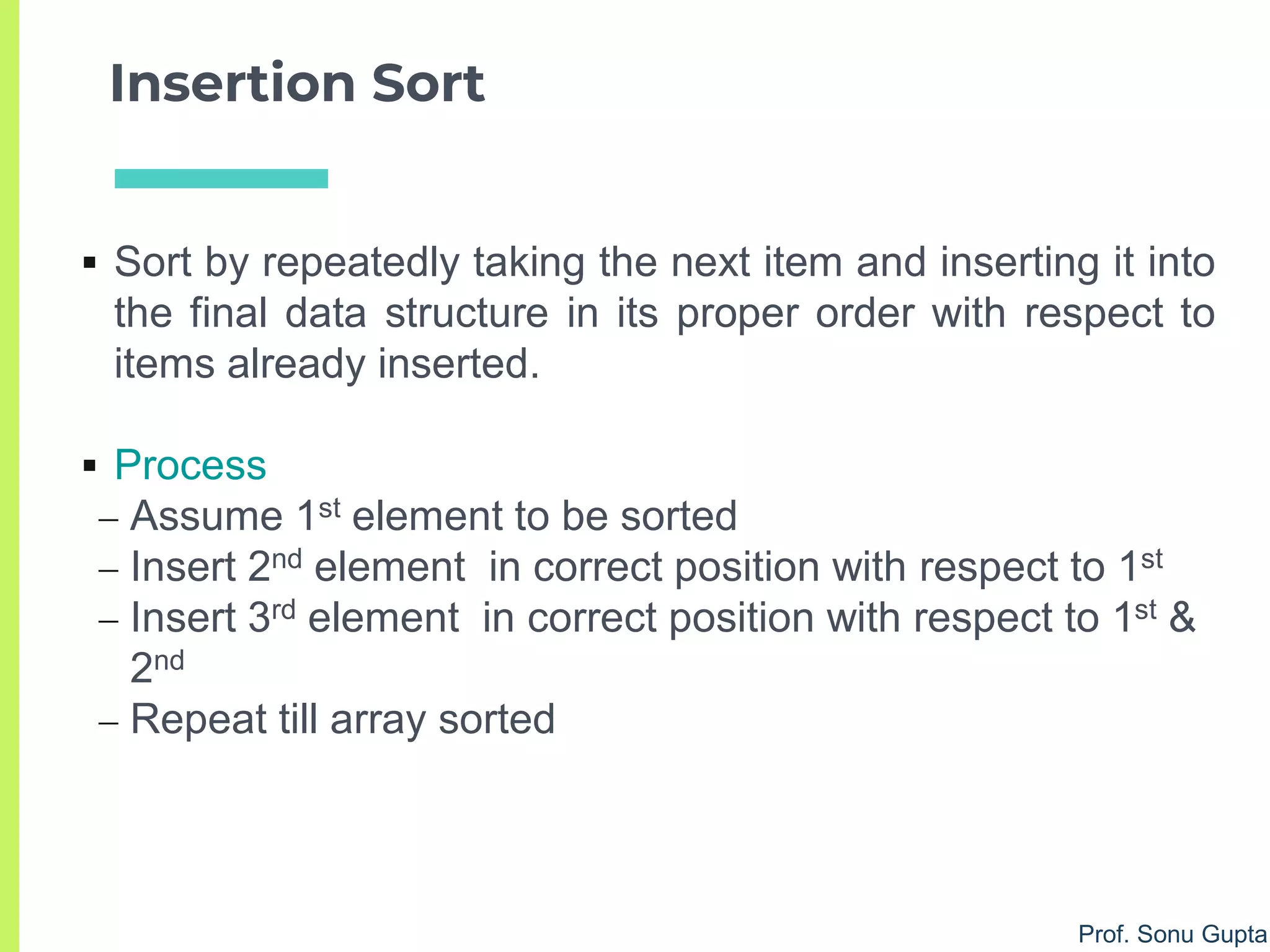
![Prof. Sonu Gupta
0
10
20
30
40
50
60
70
[1] [2] [3] [4] [5] [6]
0
10
20
30
40
50
60
70
[1] [2] [3] [4] [5] [6]
0
10
20
30
40
50
60
70
[1] [2] [3] [4] [5] [6]
Sorted side Unsorted side
0
10
20
30
40
50
60
70
[1] [2] [3] [4] [5] [6]
0
10
20
30
40
50
60
70
[1] [2] [3] [4] [5] [6]
Sorted side Unsorted side
0
10
20
30
40
50
60
70
[1] [2] [3] [4] [5] [6]
Sorted side Unsorted side](https://image.slidesharecdn.com/2sorting-190122084642/75/Sorting-algorithms-31-2048.jpg)
![Prof. Sonu Gupta
0
10
20
30
40
50
60
70
[1] [2] [3] [4] [5] [6]
0
10
20
30
40
50
60
70
[1] [2] [3] [4] [5] [6]
Sorted side Unsorted side
0
10
20
30
40
50
60
70
[1] [2] [3] [4] [5] [6]
0
10
20
30
40
50
60
70
[1] [2] [3] [4] [5] [6]
Sorted side Unsorted side
0
10
20
30
40
50
60
70
[1] [2] [3] [4] [5] [6]
0
10
20
30
40
50
60
70
[1] [2] [3] [4] [5] [6]
Sorted side Unsorted side
First pass gets over](https://image.slidesharecdn.com/2sorting-190122084642/75/Sorting-algorithms-32-2048.jpg)
![Prof. Sonu Gupta
Process Continues…….
0
10
20
30
40
50
60
70
[1] [2] [3] [4] [5] [6]
0
10
20
30
40
50
60
70
[1] [2] [3] [4] [5] [6]
Sorted side Unsorted side
0
10
20
30
40
50
60
70
[1] [2] [3] [4] [5] [6]
0
10
20
30
40
50
60
70
[1] [2] [3] [4] [5] [6]
Sorted side Unsorted side](https://image.slidesharecdn.com/2sorting-190122084642/75/Sorting-algorithms-33-2048.jpg)
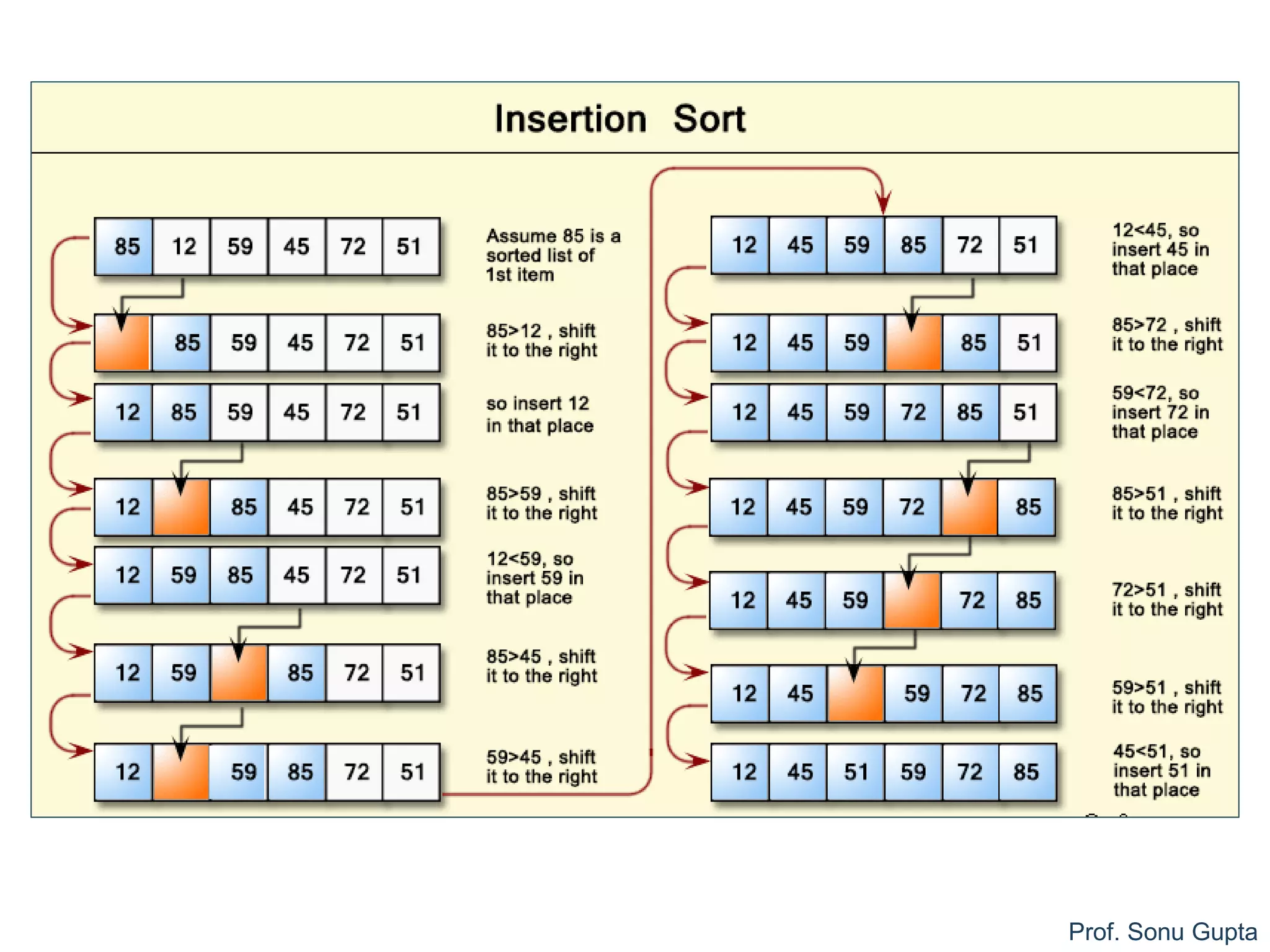
![Prof. Sonu Gupta
Insertion Sort
Algorithm insertion (a, length)
Pre: Unsorted list ‘a’ of length ‘n’.
Post: Sorted list a in ascending order of length n
1. for i = 1 to (n -1) do // n-1 passes
1. indata=a[i]
2. for j = (i-1) downto 0 do
1. if ( indata < a[j] )
1. a[j+1] = a[j] // shift elements
2. else
1. break
2. a[j+1] = indata // insert element at proper position](https://image.slidesharecdn.com/2sorting-190122084642/75/Sorting-algorithms-35-2048.jpg)
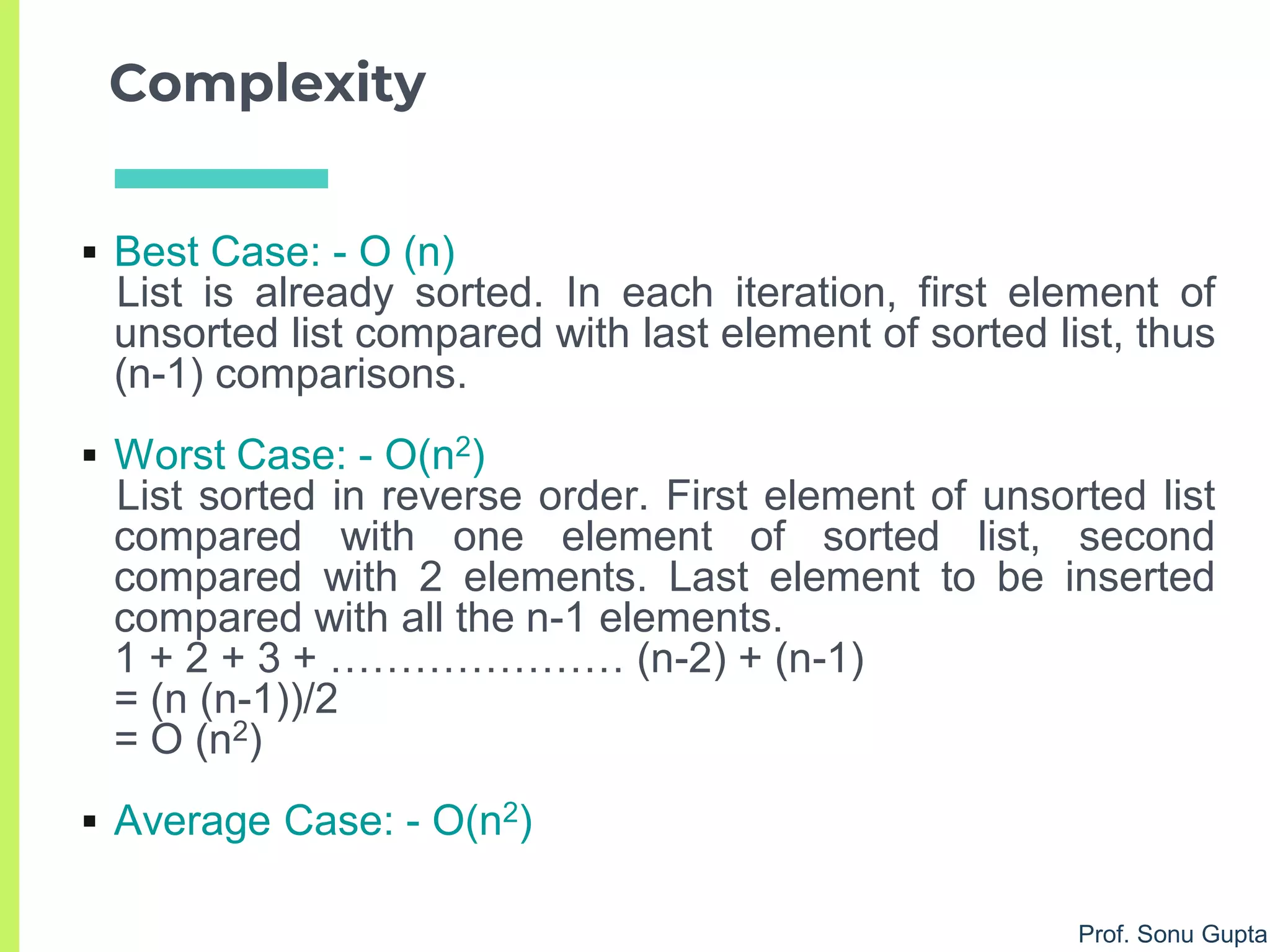

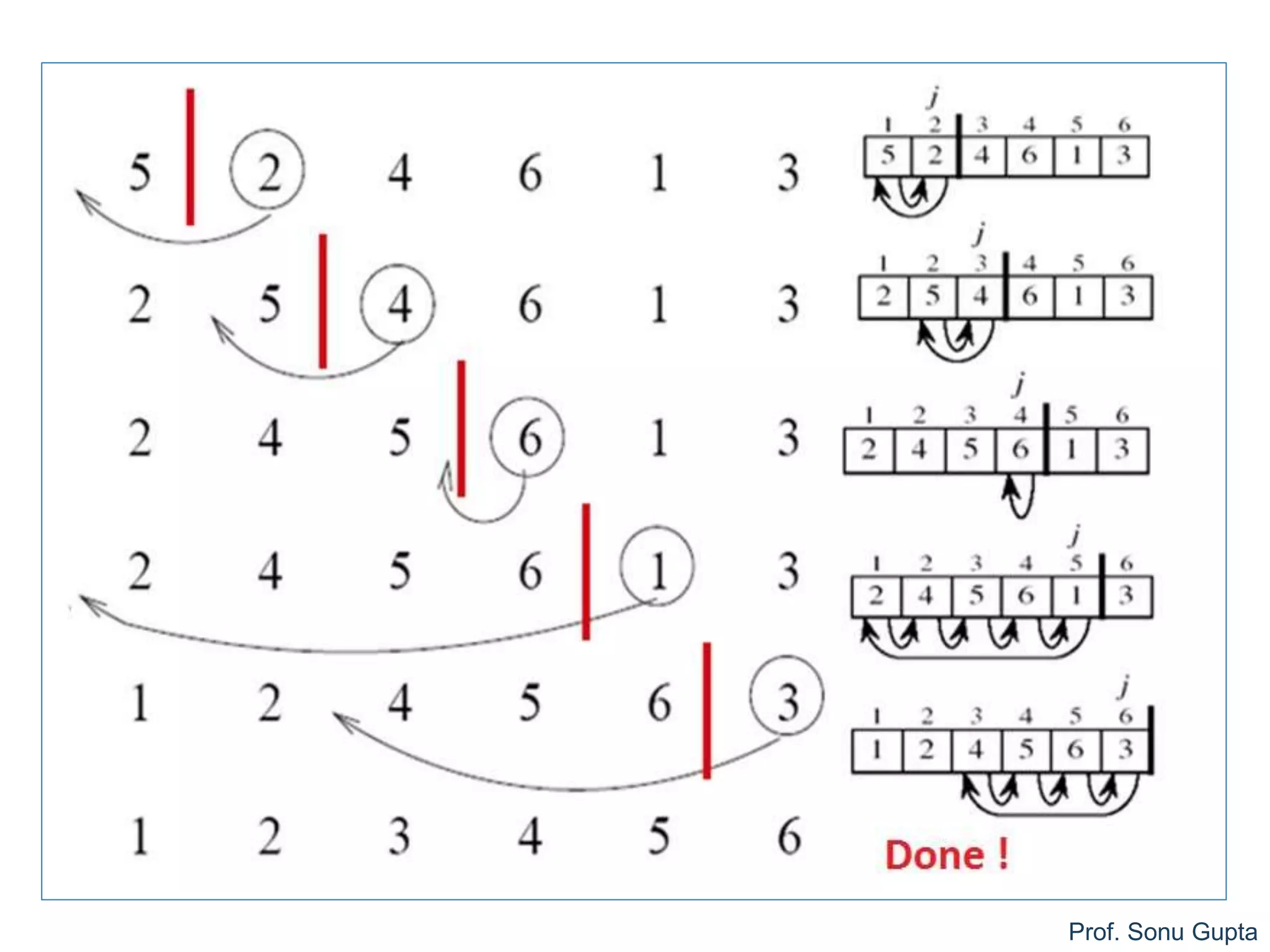
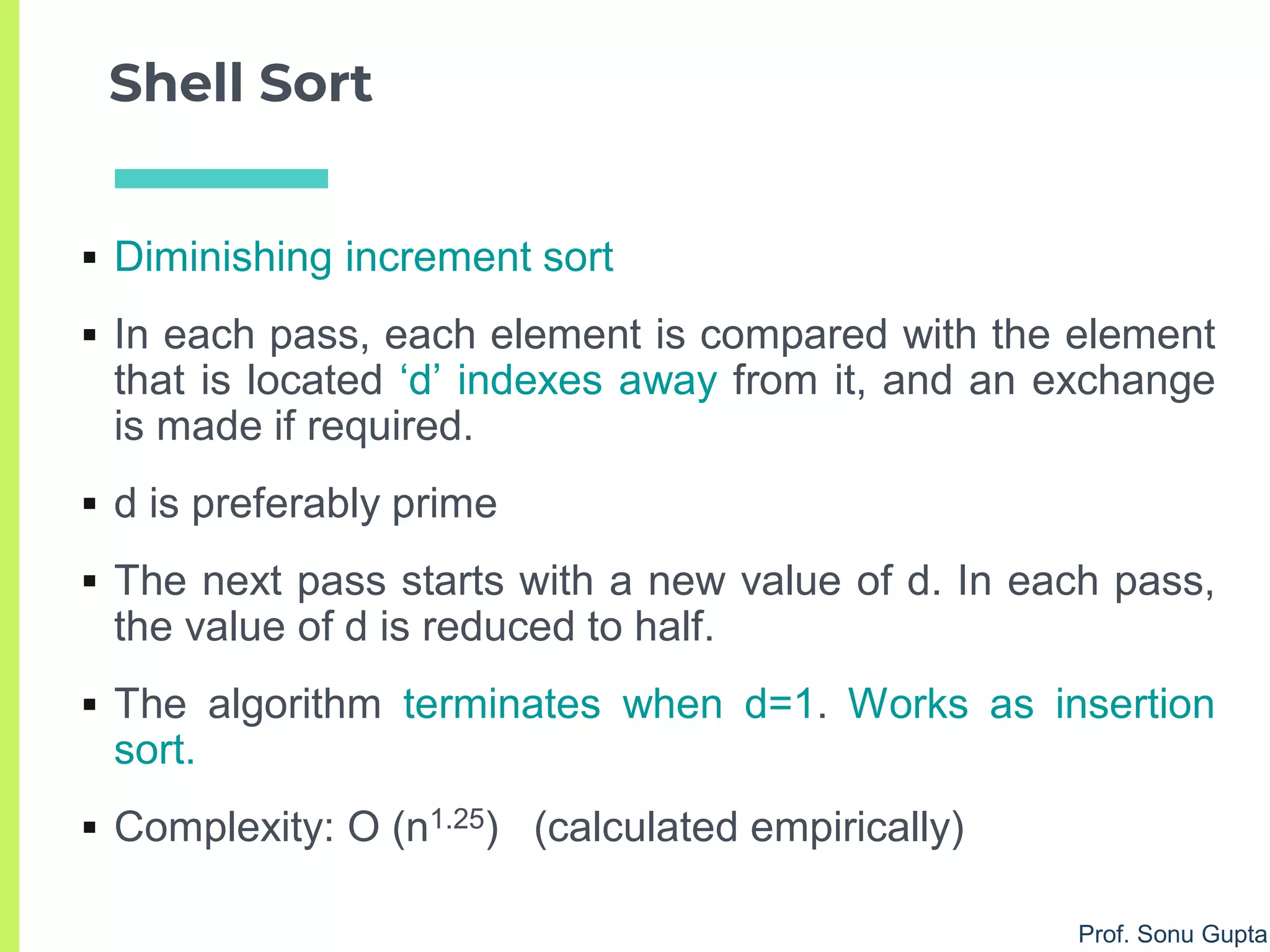
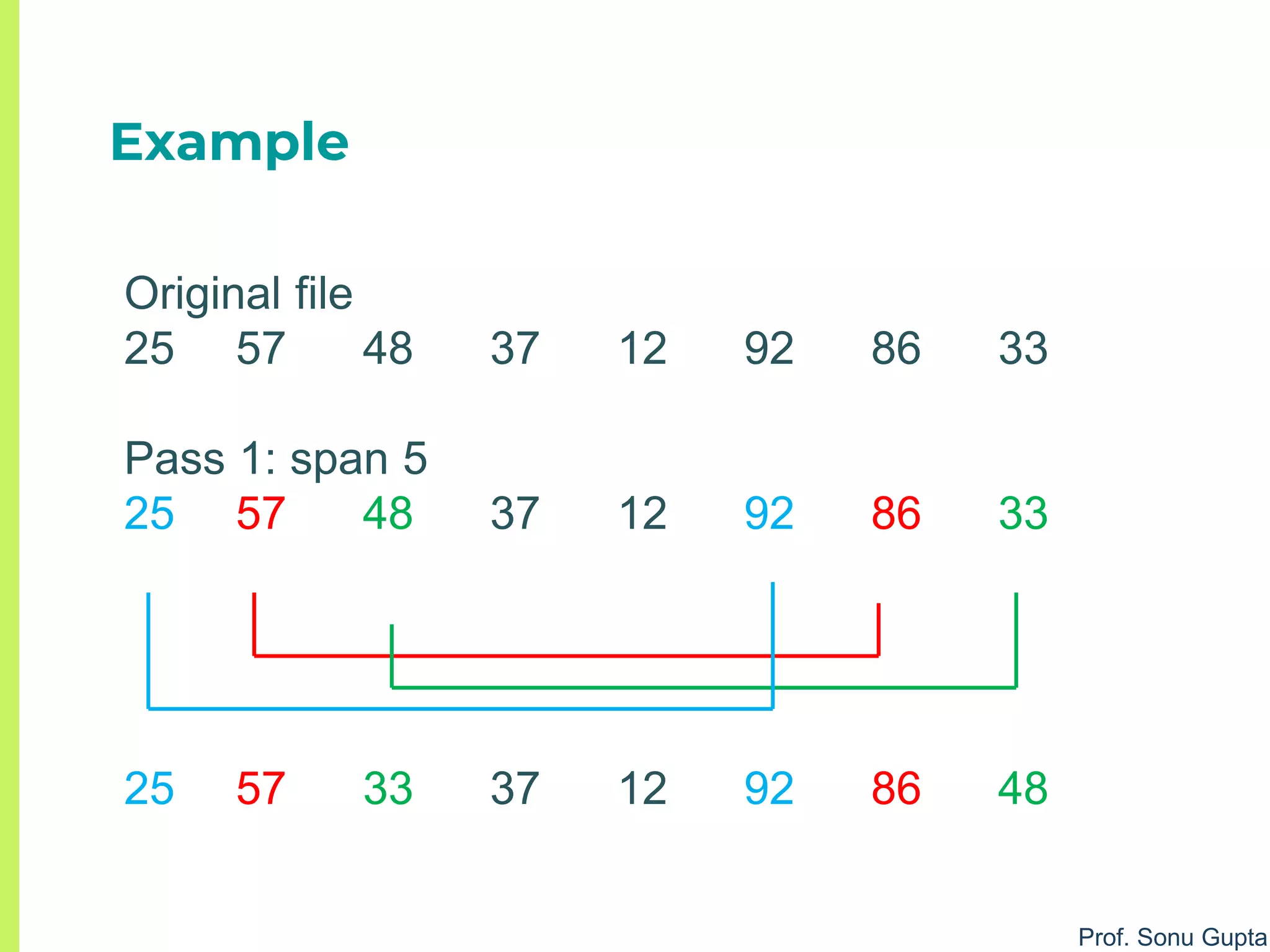
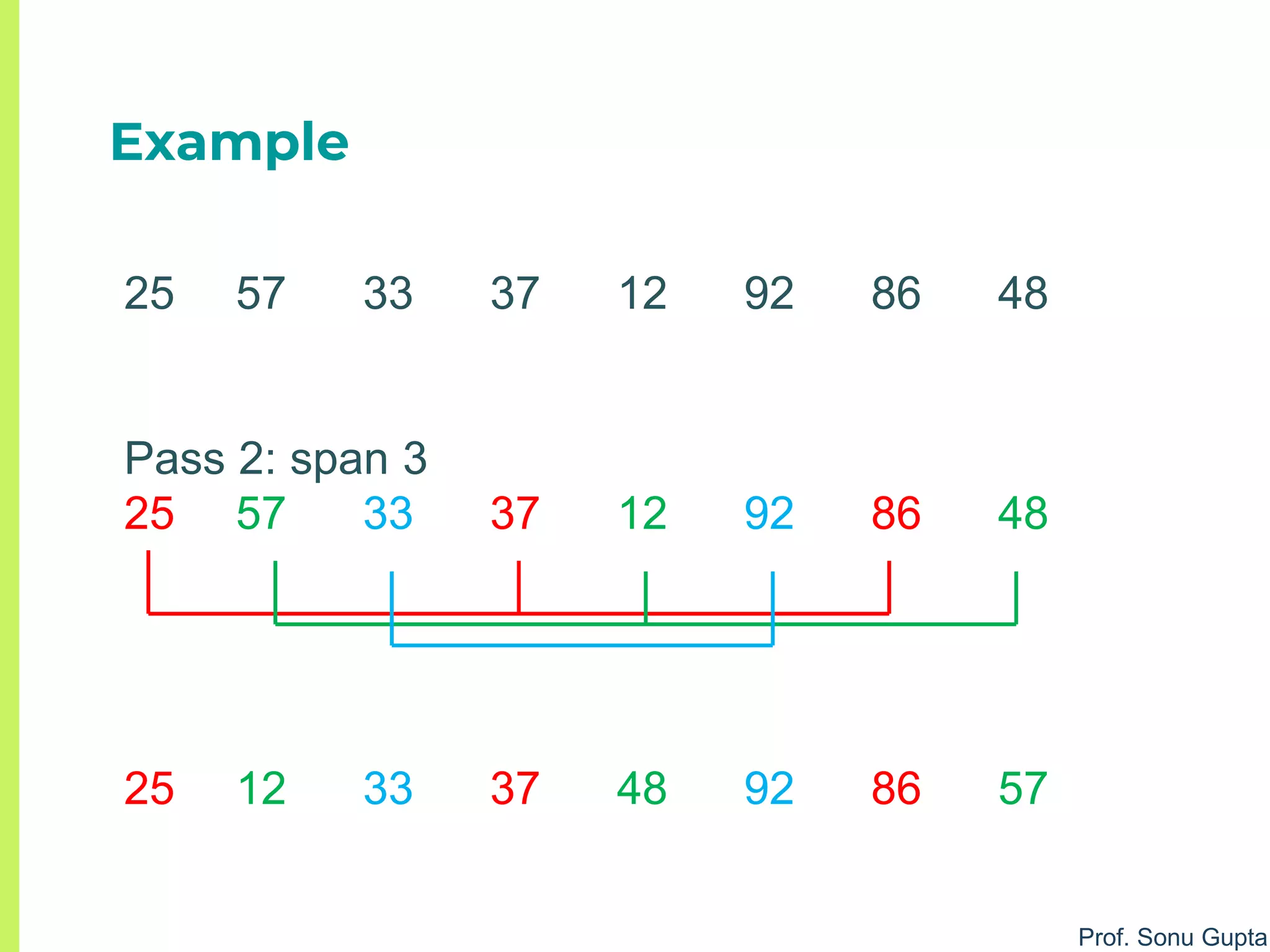
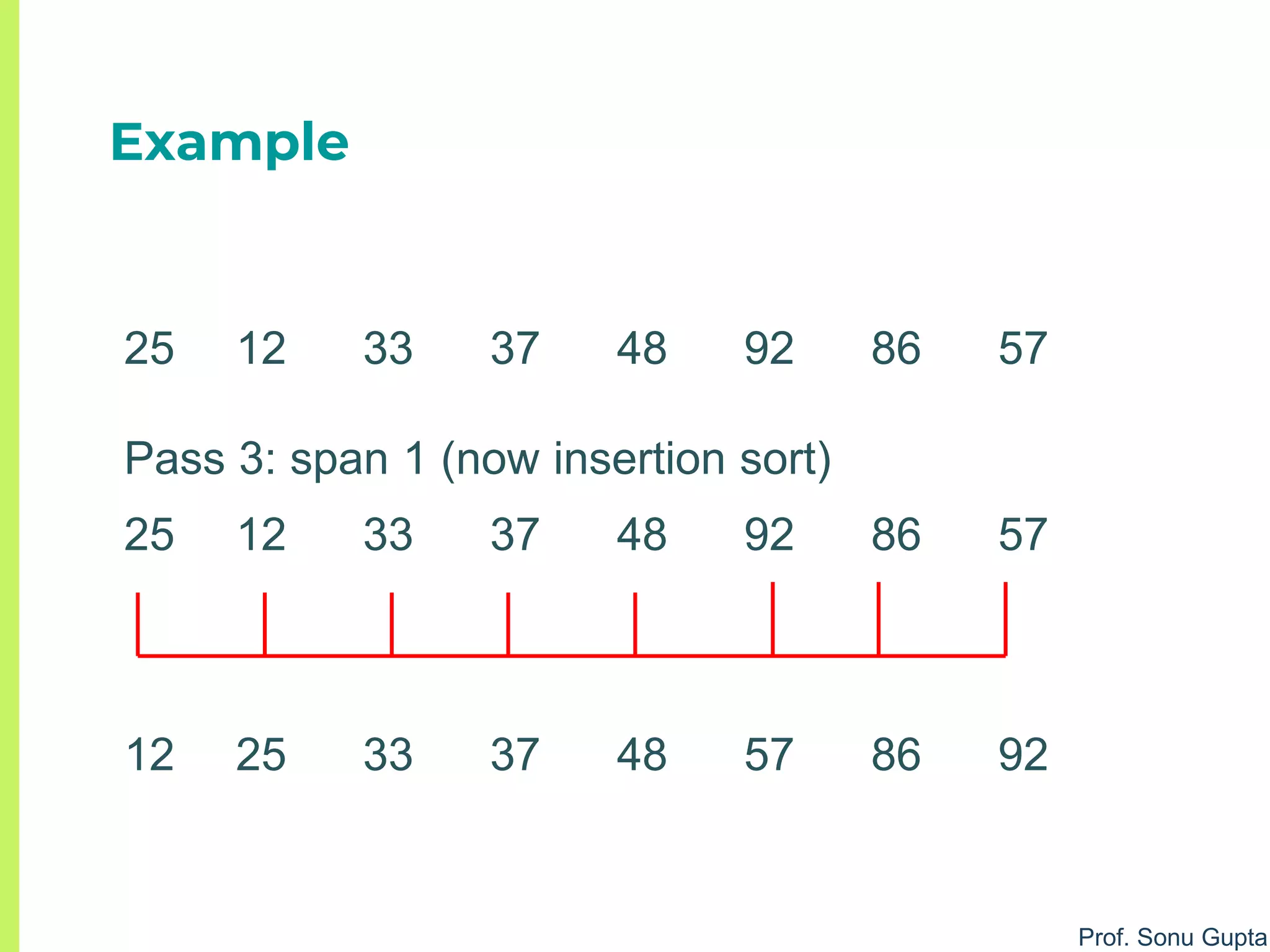
![Prof. Sonu Gupta
Shell Sort
Algorithm shell (a, n, inc, n_inc)
// unsorted array a, n – array size, inc – array of diminishing
increment values, n_inc - size of array increments
Pre: Unsorted list of length n.
Post: Sorted list in ascending order of length n
1. for increment = 0 to (n_inc - 1) do
1. span = inc[increment] //choose increment
2. for j = span to (n-1) do //pass
1. y = a[j]
2. for k = (j-span) downto 0 step span
1. if (y < a[k])
1. a[k + span]=a[k]
2. else
1. break
3. a[k + span] = y](https://image.slidesharecdn.com/2sorting-190122084642/75/Sorting-algorithms-43-2048.jpg)
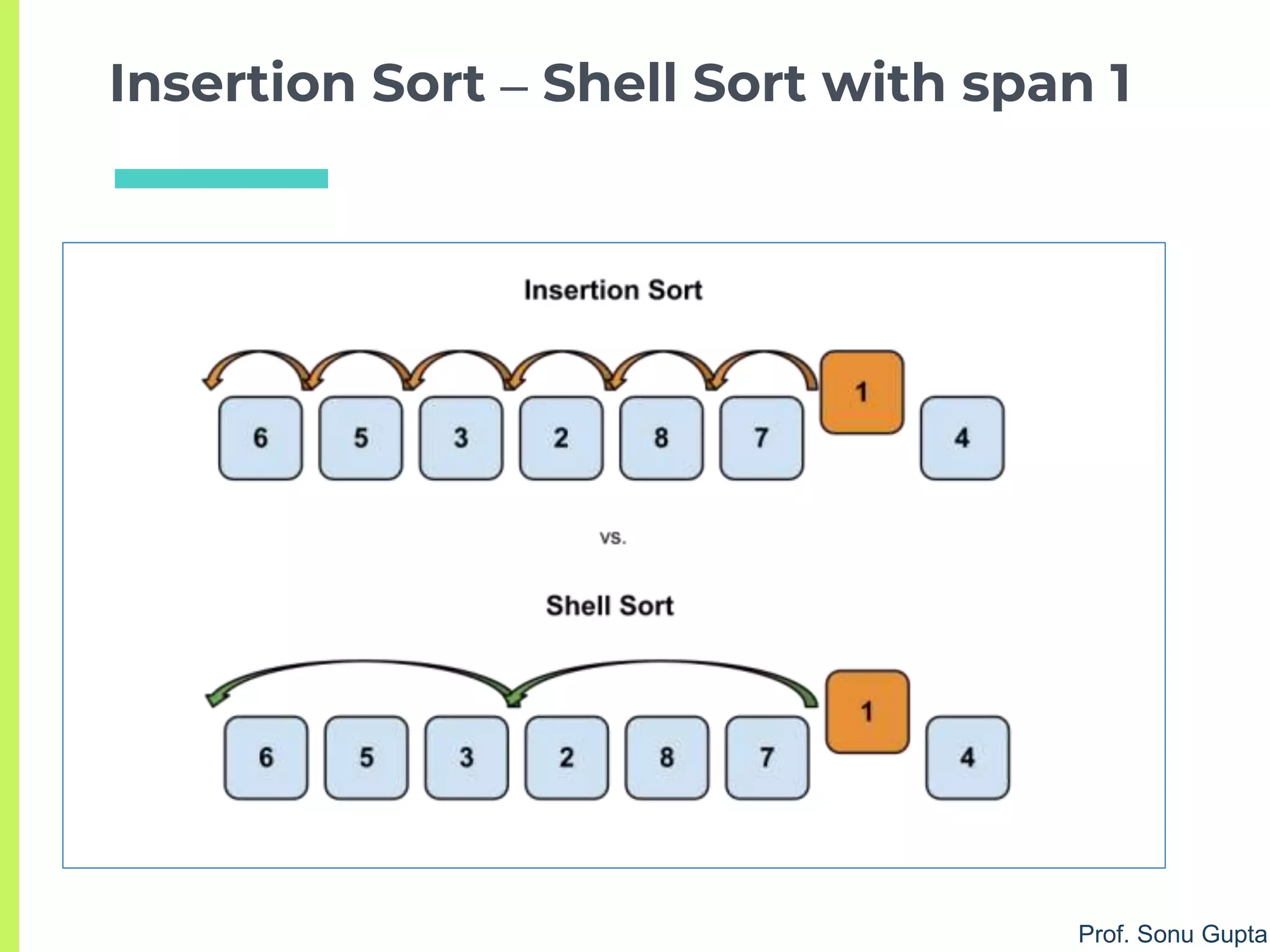
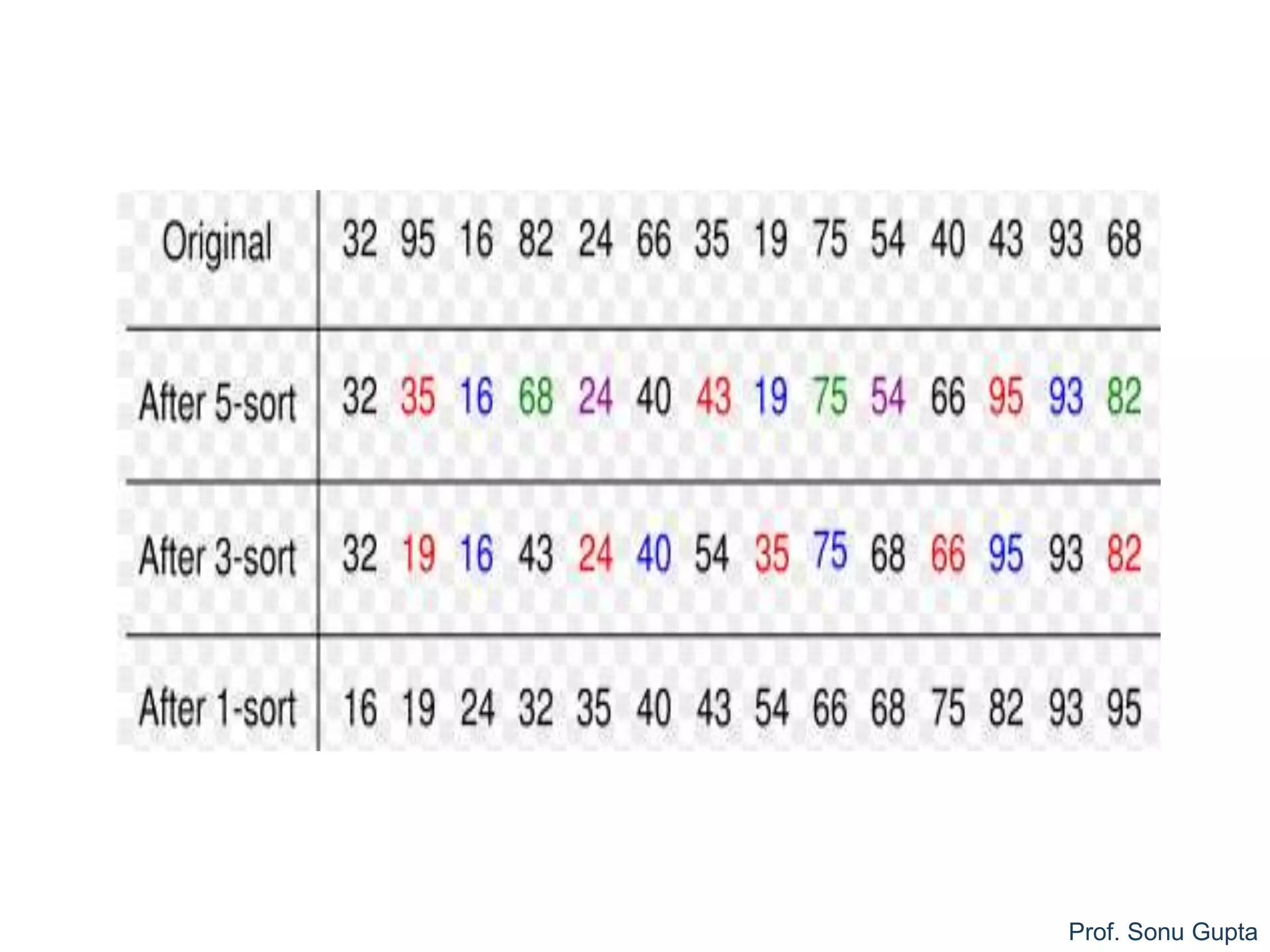
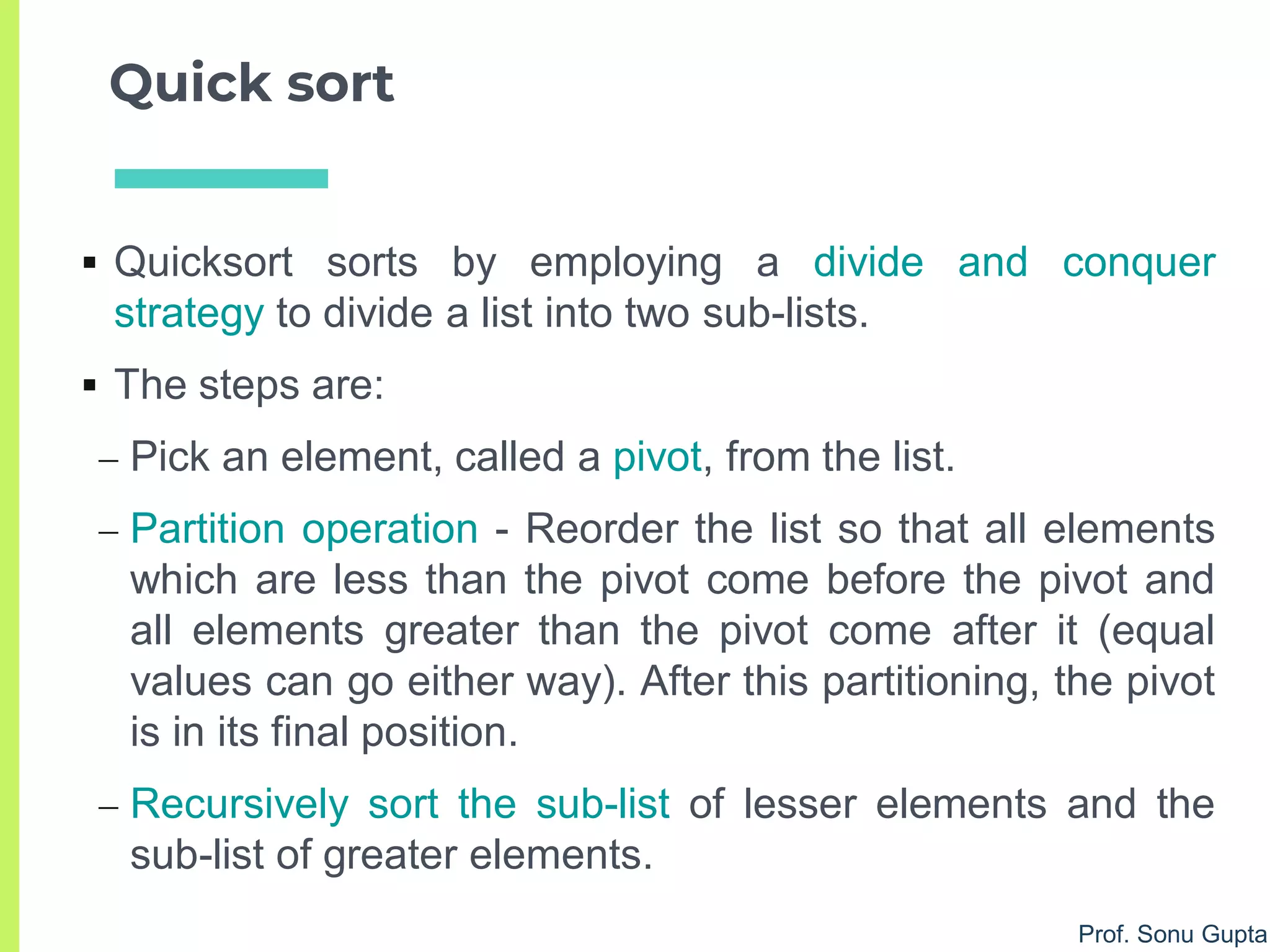
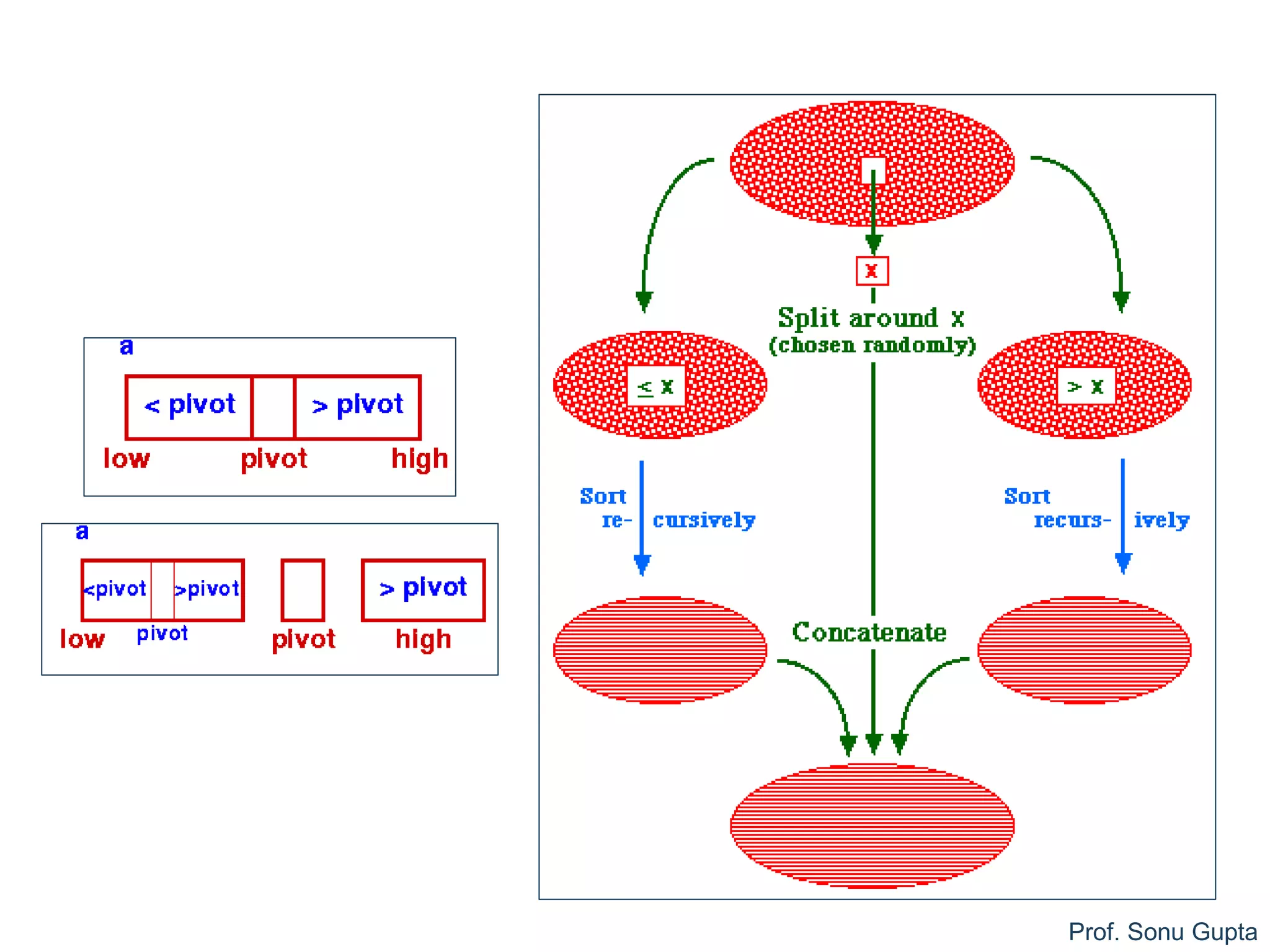
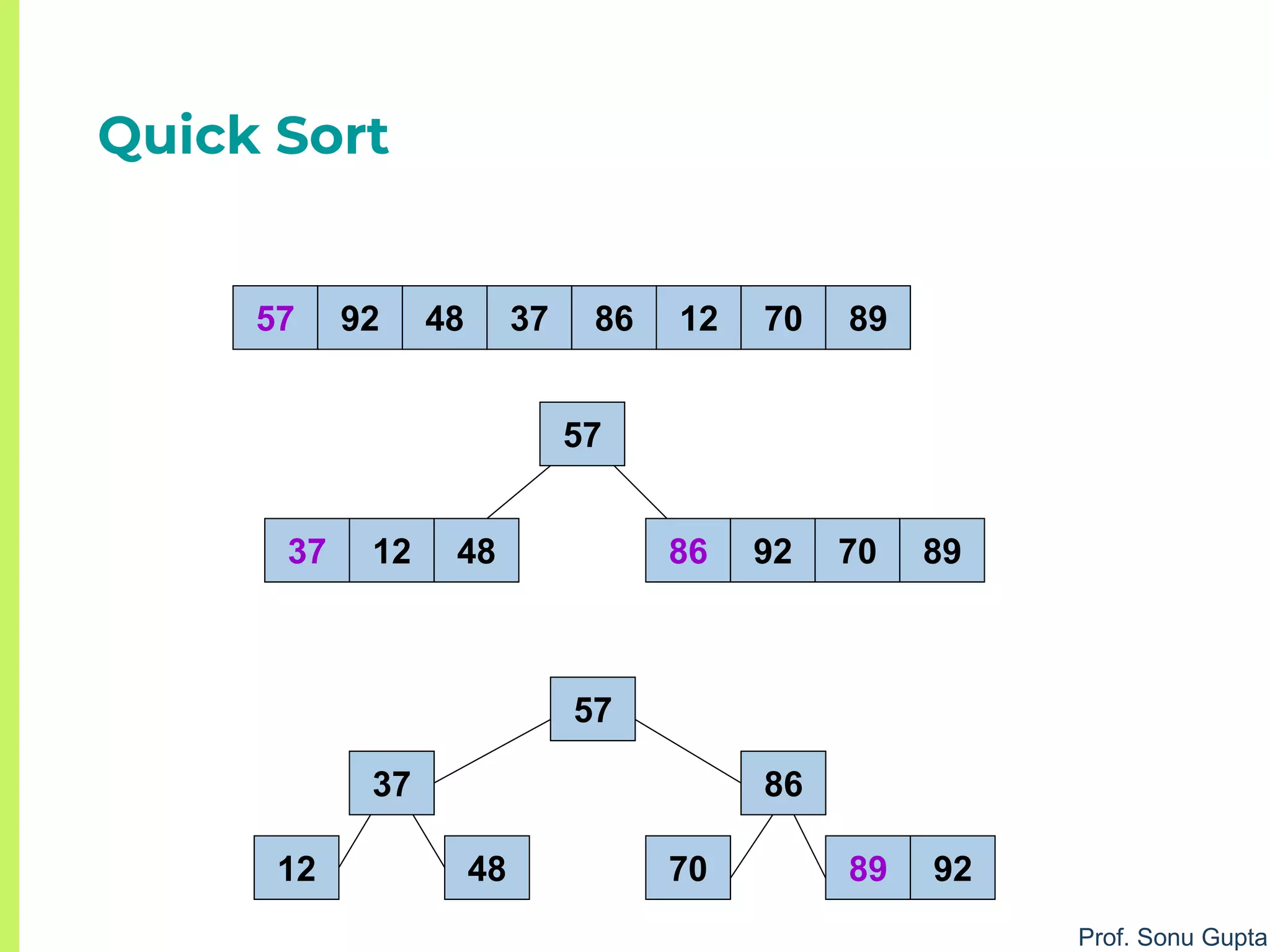
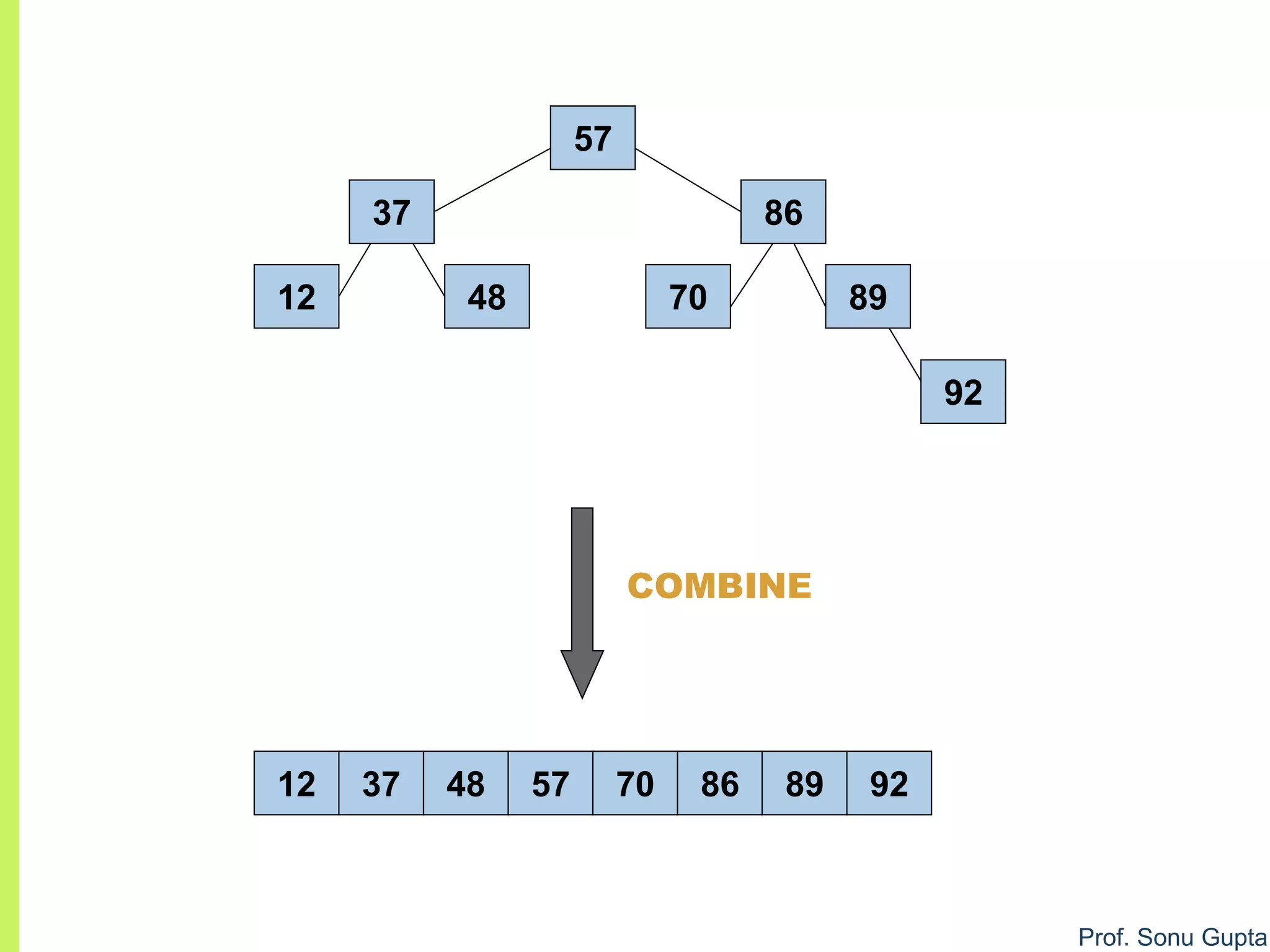
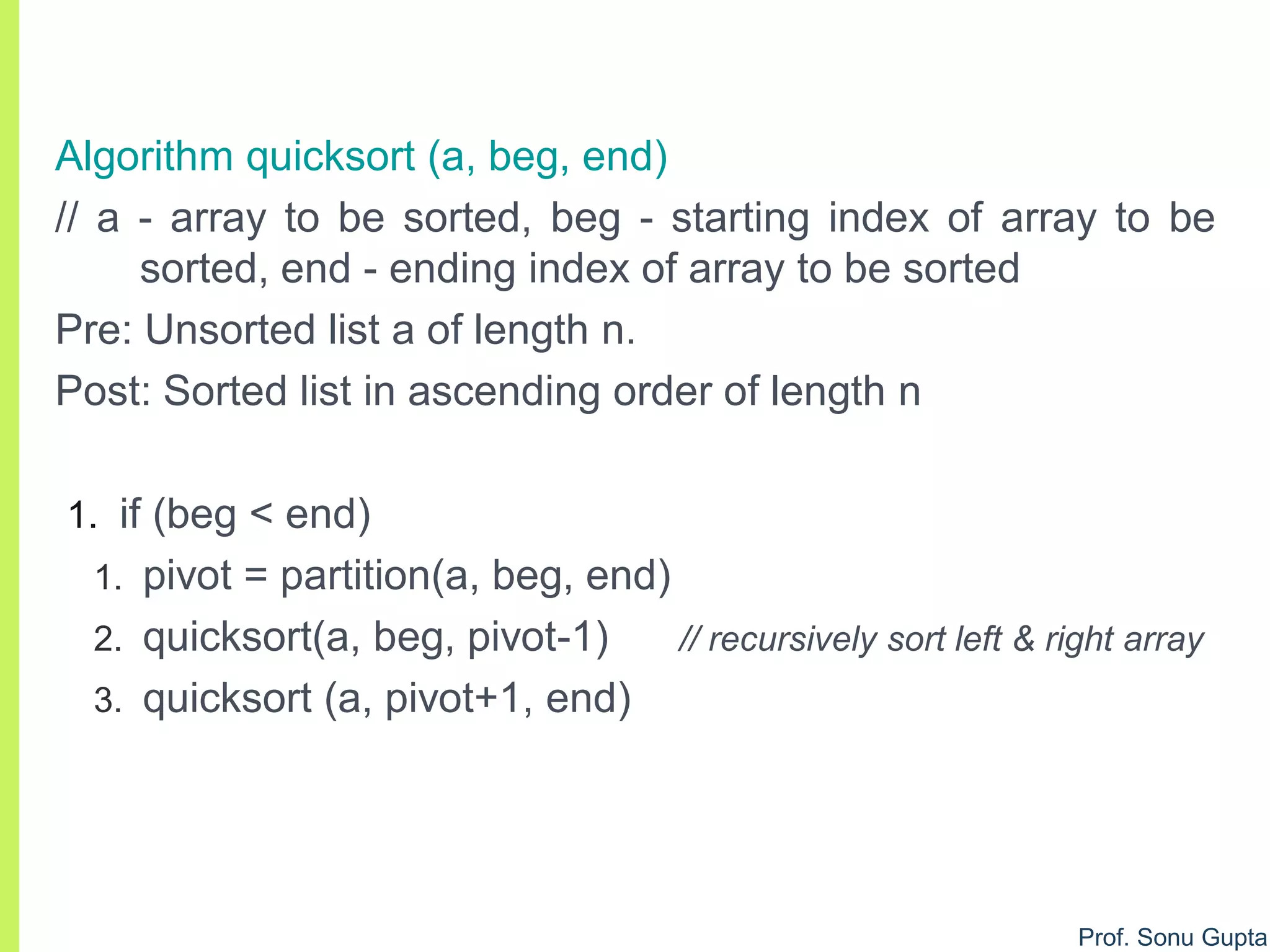
![Prof. Sonu Gupta
partition (a, beg, end)
// Places pivot element piv at its proper position; elements
before it are less than it & after it are greater than it
1. piv = a[beg]
2. up = end
3. down = beg
4. while (down < up)
1.while( (a[down] <= piv) & (down < up))
1.down=down + 1
2.while(a[up]>piv)
1.up=up-1
3.if (down<up)
1.swap ( a[down], a[up])
5. swap(a[beg],a[up])
6. return up](https://image.slidesharecdn.com/2sorting-190122084642/75/Sorting-algorithms-51-2048.jpg)
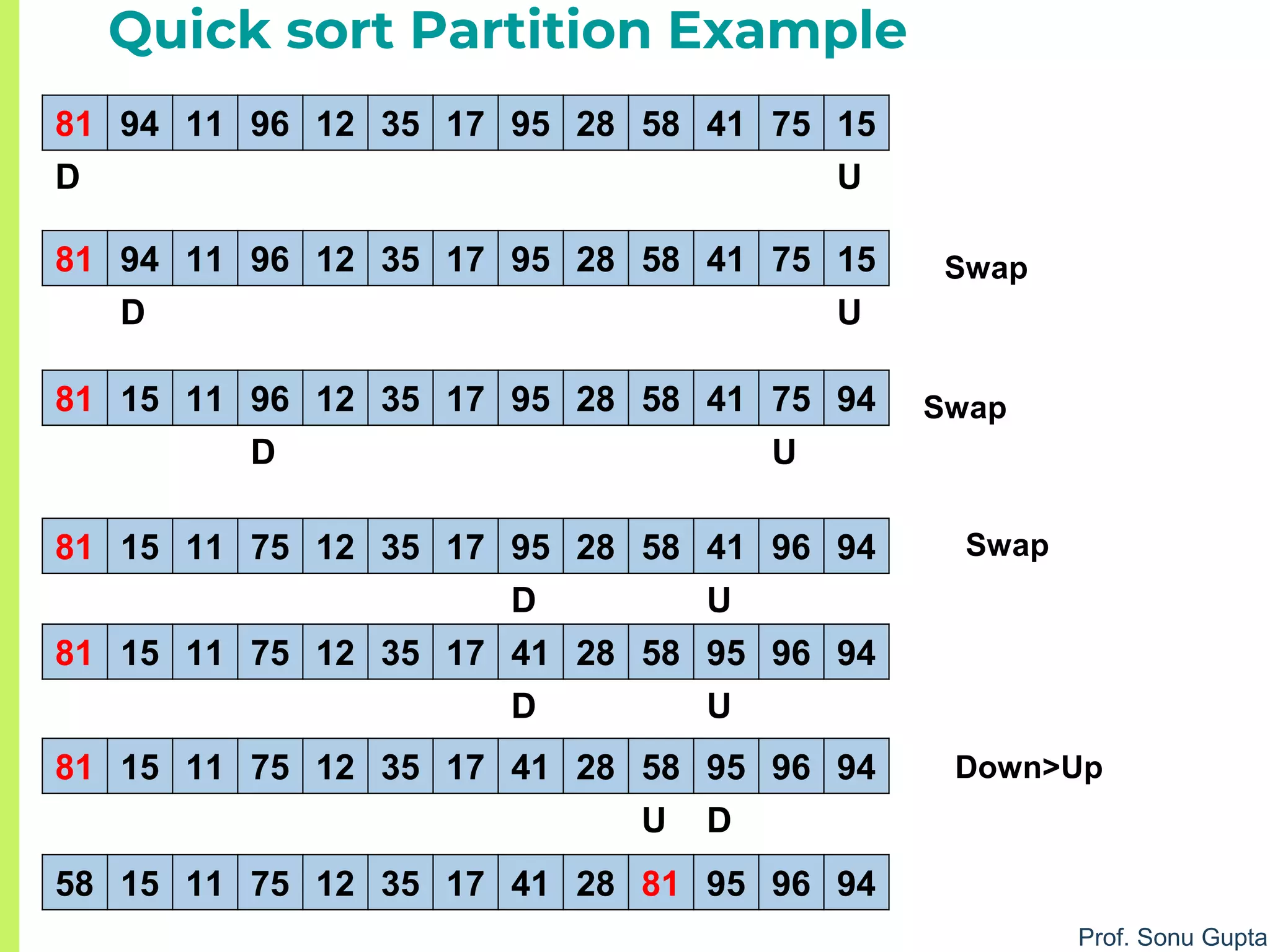
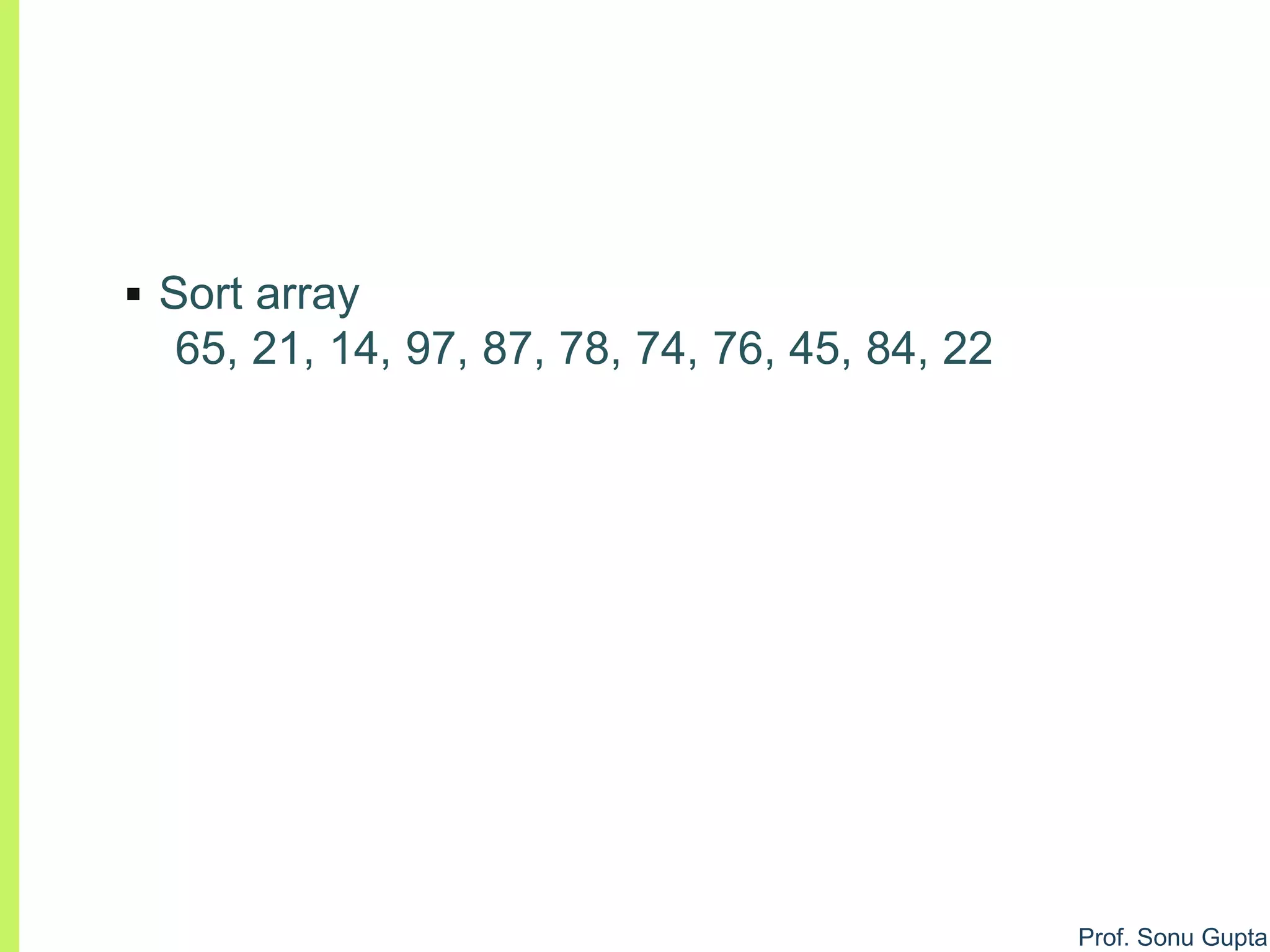
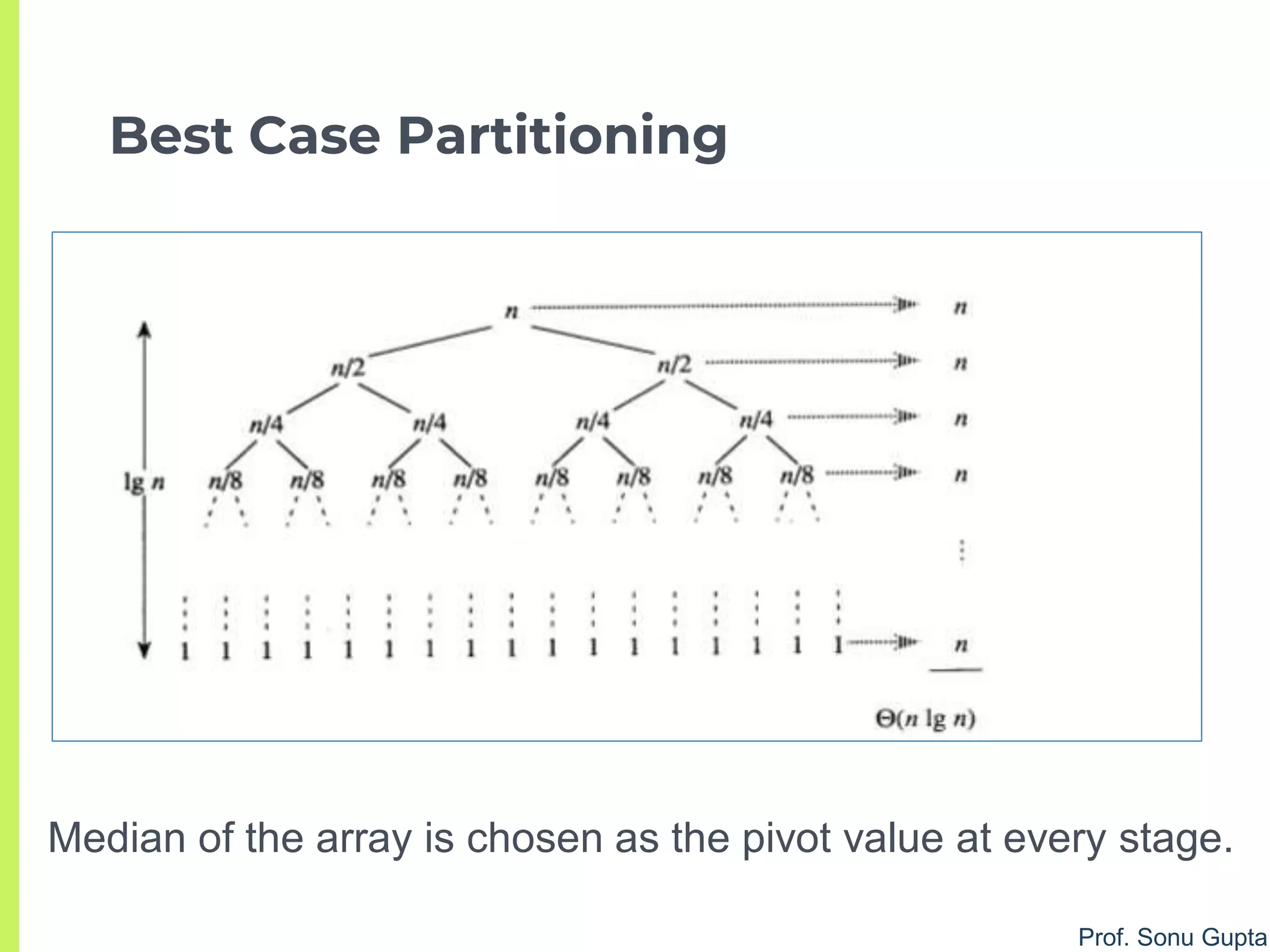
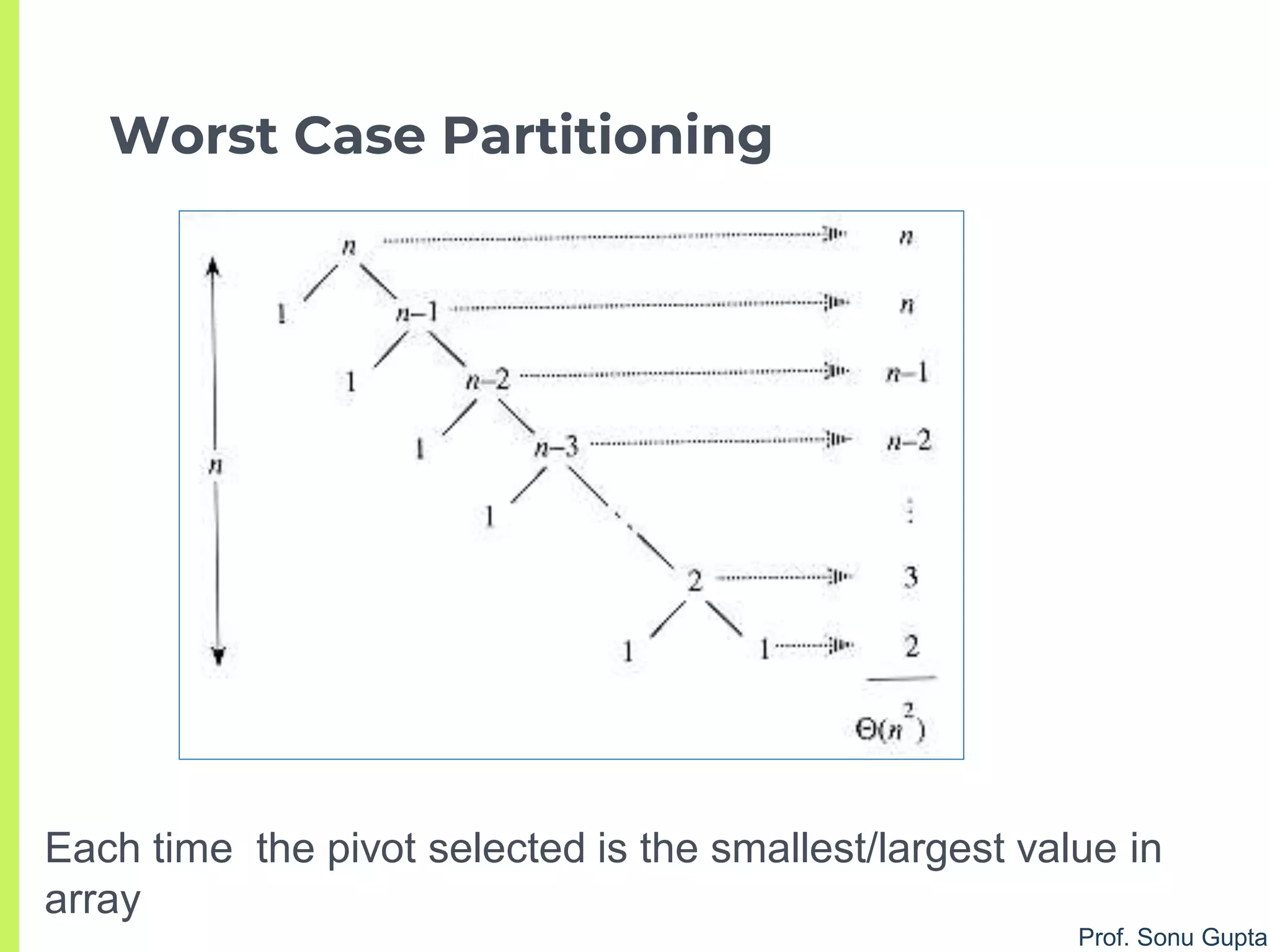
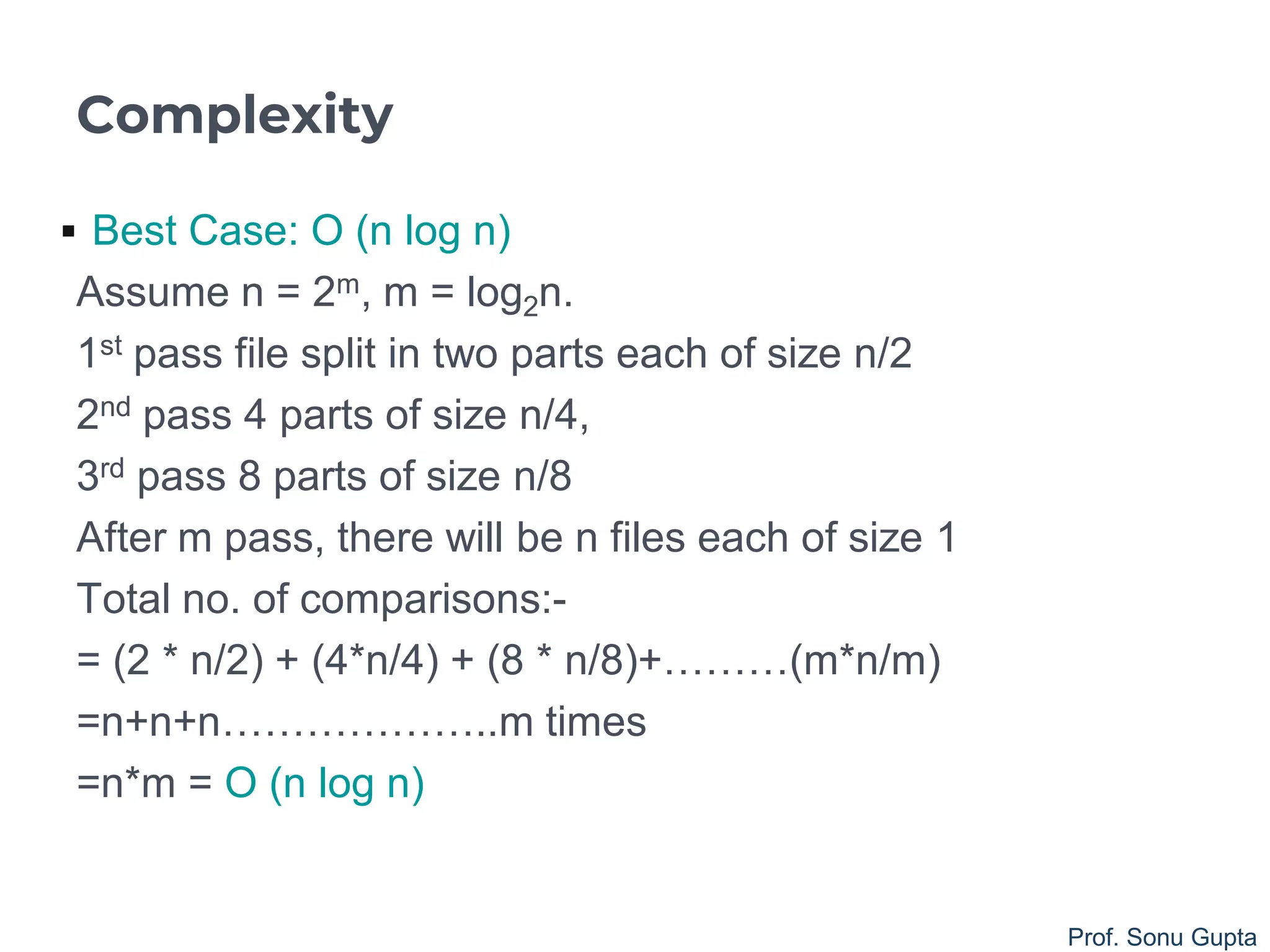
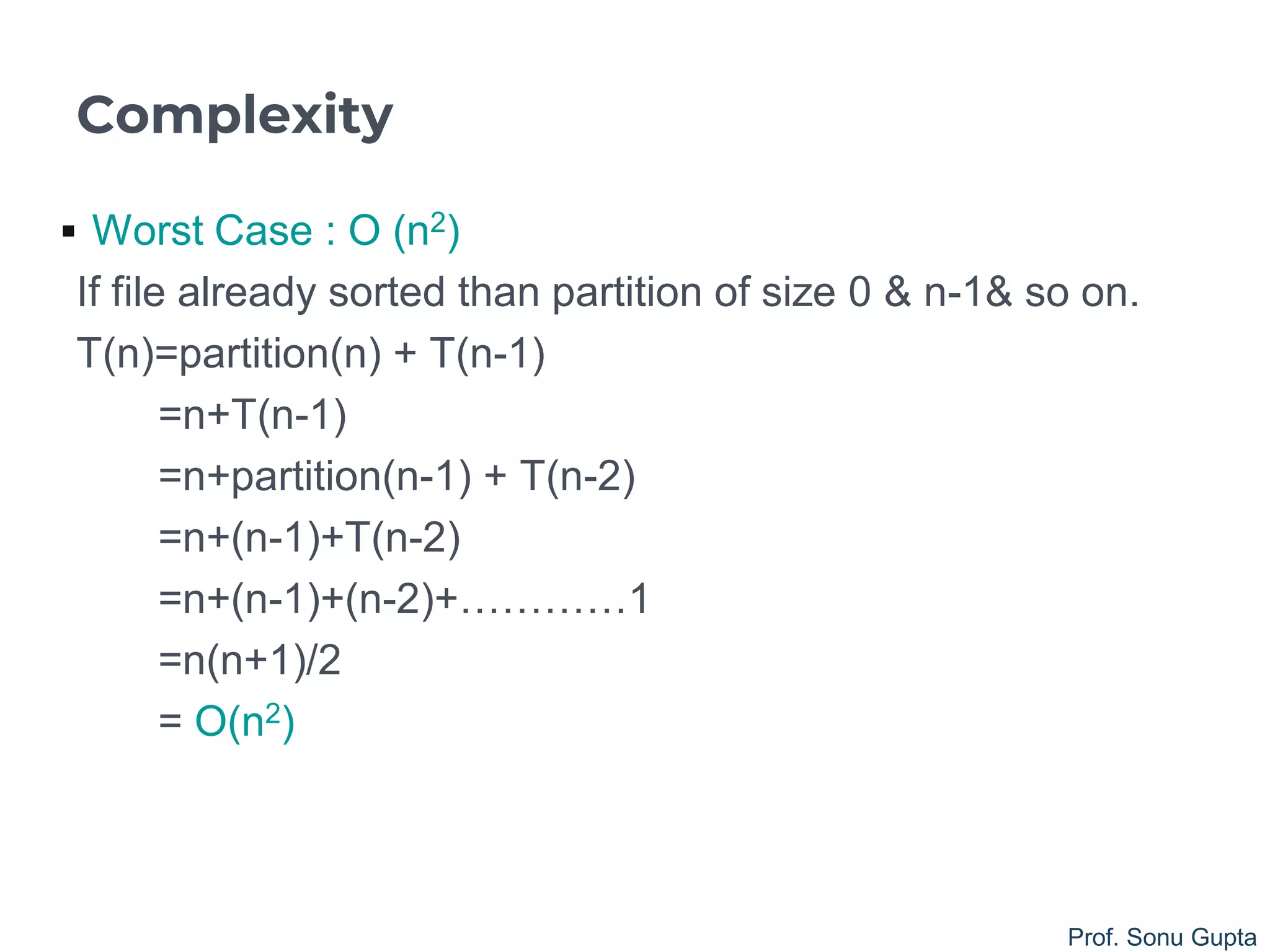
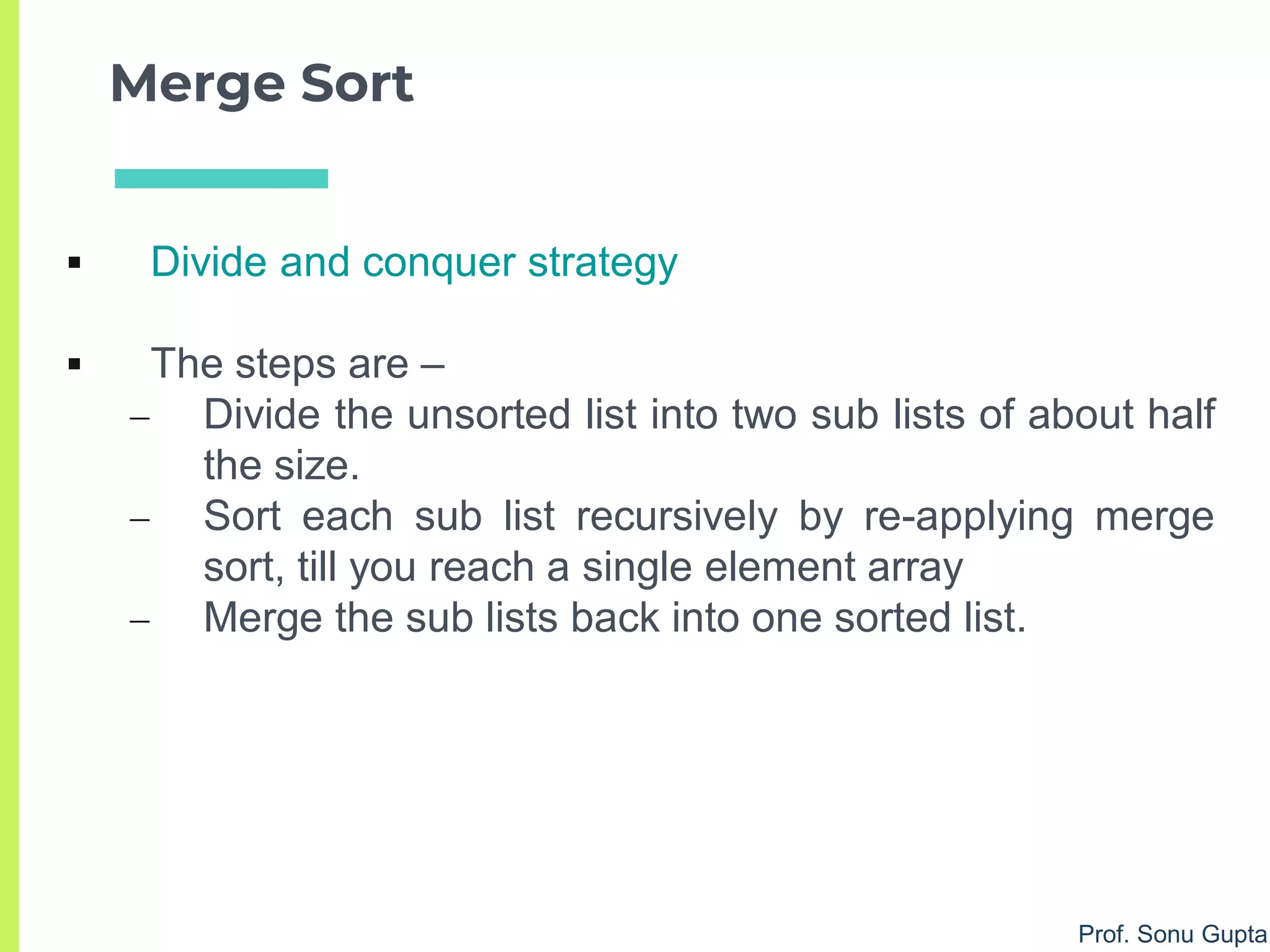
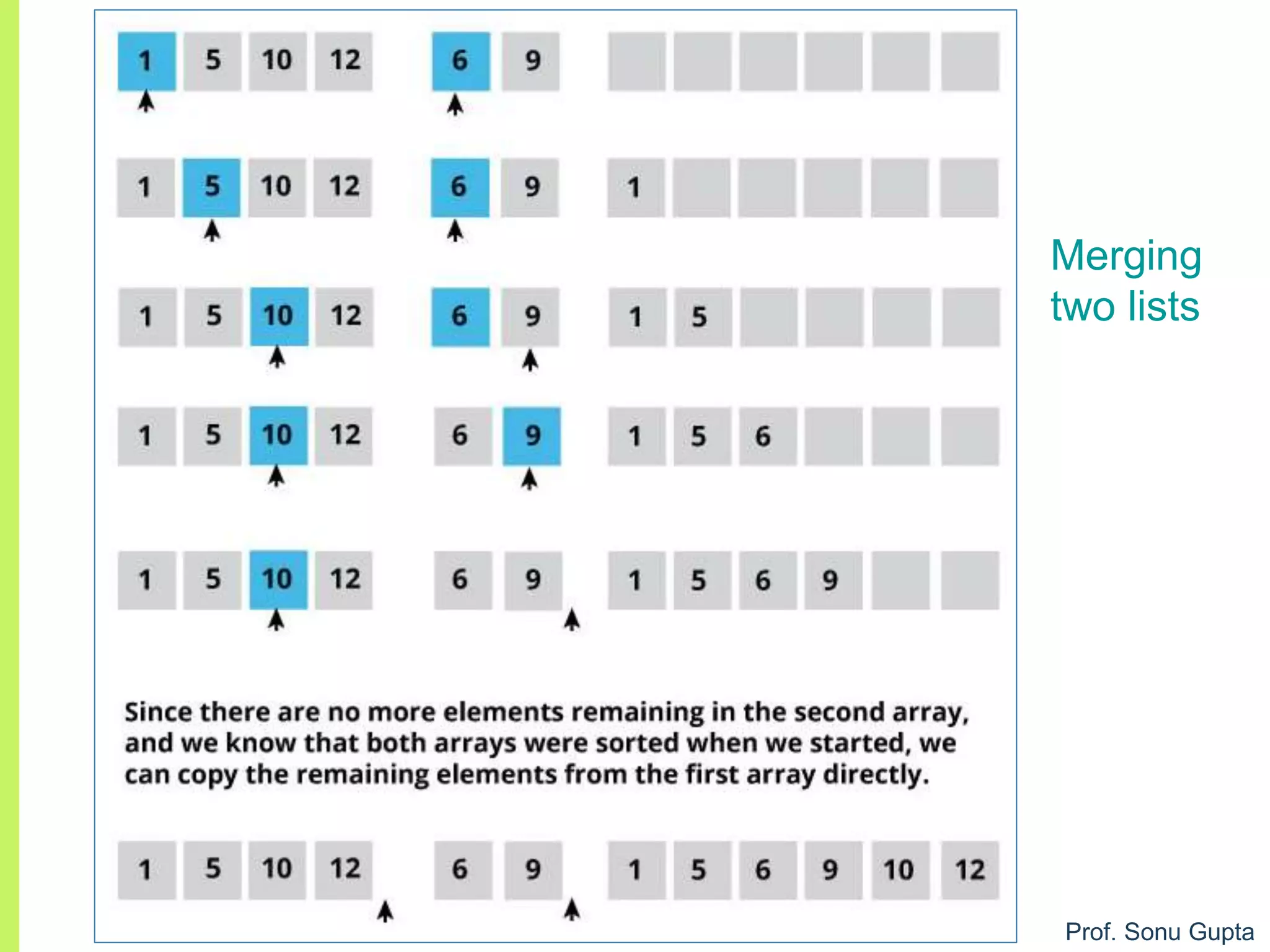
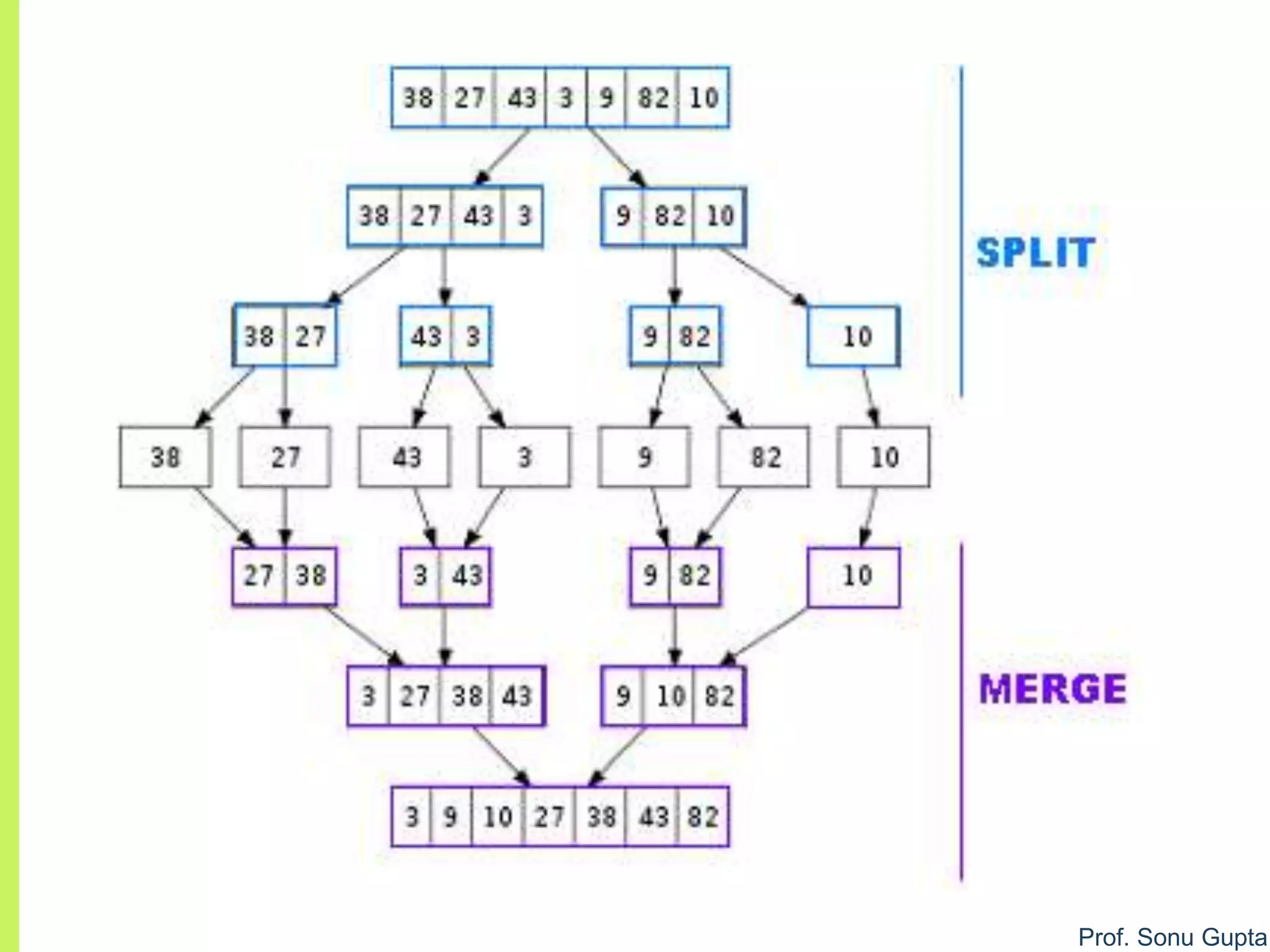
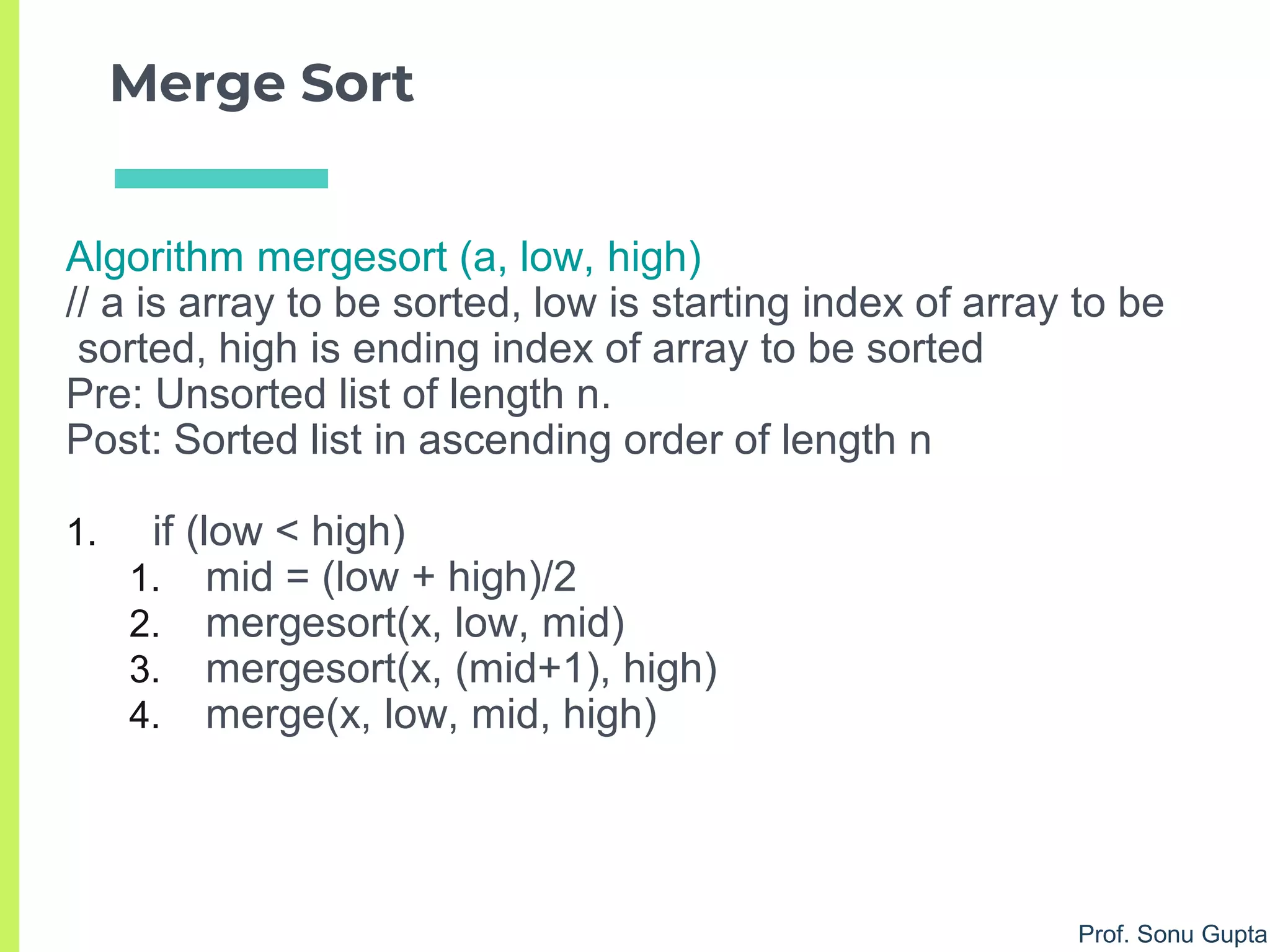
![Prof. Sonu Gupta
merge (a, low1, high1, high2)
1.i = low1; j = high1 + 1; k = 0
2.while (i<= high1) and (j<=high2) //Merge arrays
1. if (x[i] <=x[j])
1. aux[k] = x[i]
2. k=k+1; i=i+1
2. else
1. aux[k] = x[j]
2. k=k+1; j=j+1
3.while (i<= high1) // If jth list over, copy ith as it is
1. aux[k] = x[i]
2. k=k+1; i=i+1
4.while (j<= high2) // If ith list over, copy jth as it is
1. aux[k] = x[j]
2. k=k+1; j=j+1
5.k=0
6.for j = low1 to high2
1. a[j] = aux[k]
2. k = k+1](https://image.slidesharecdn.com/2sorting-190122084642/75/Sorting-algorithms-62-2048.jpg)
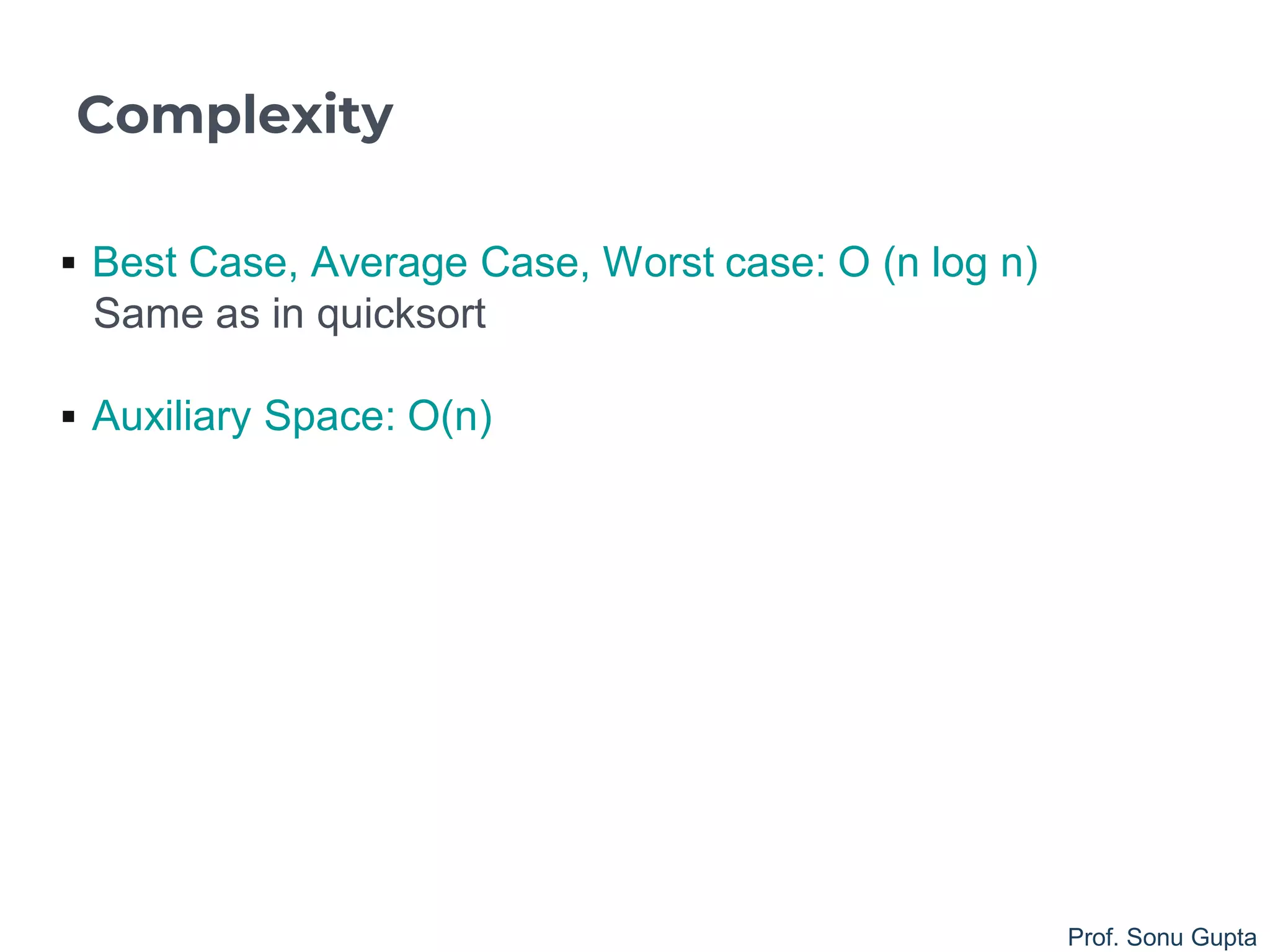
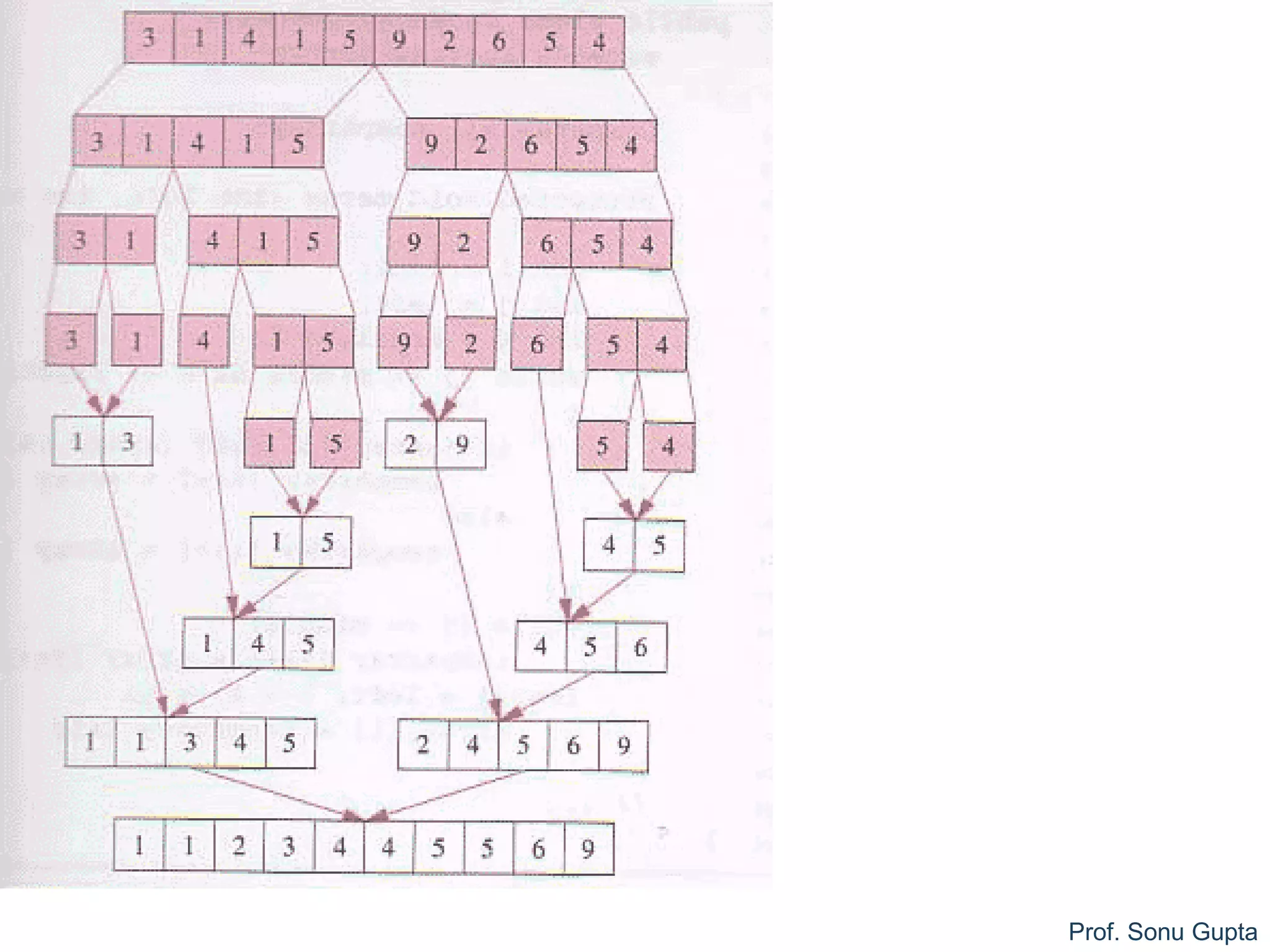
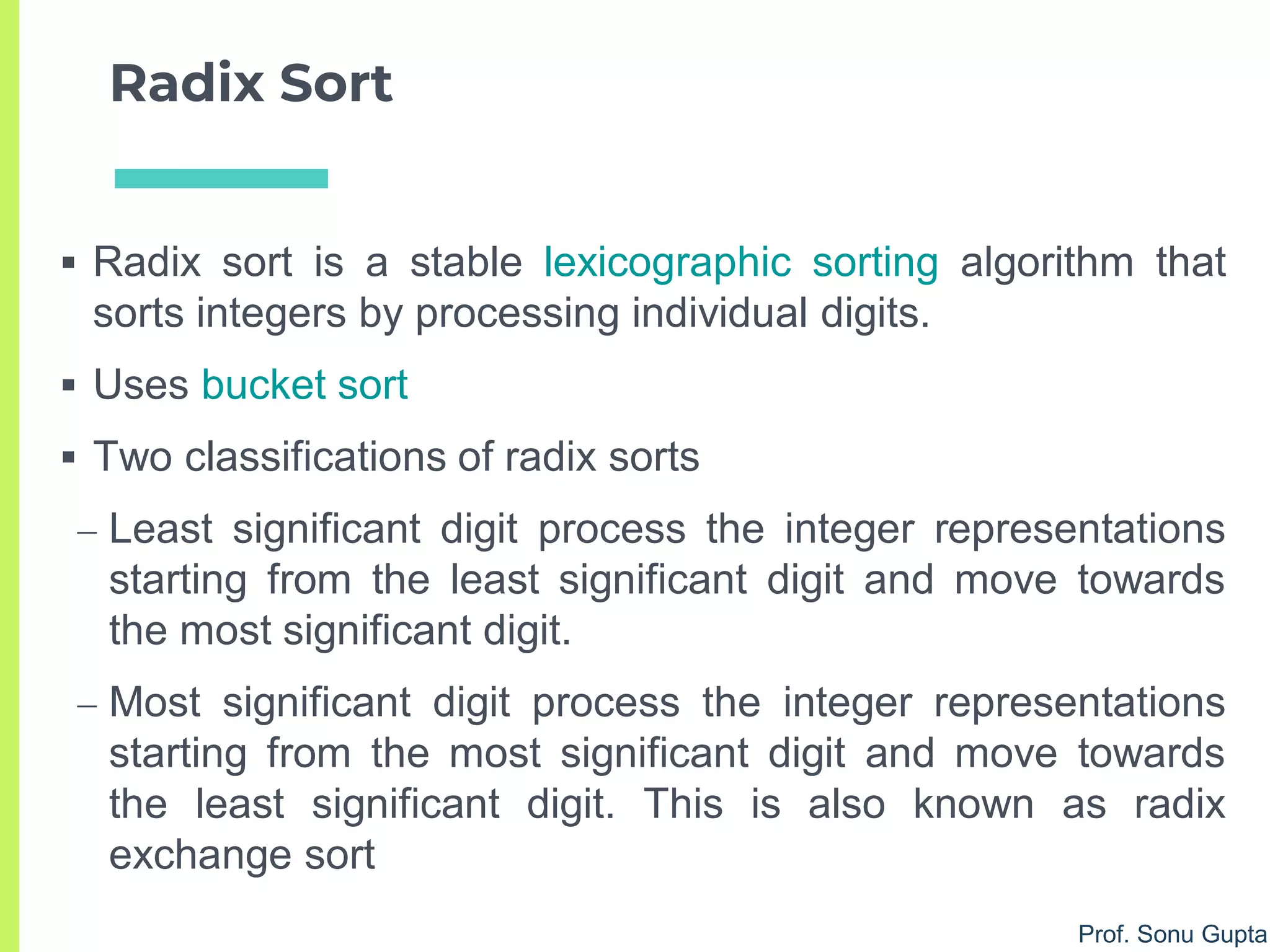
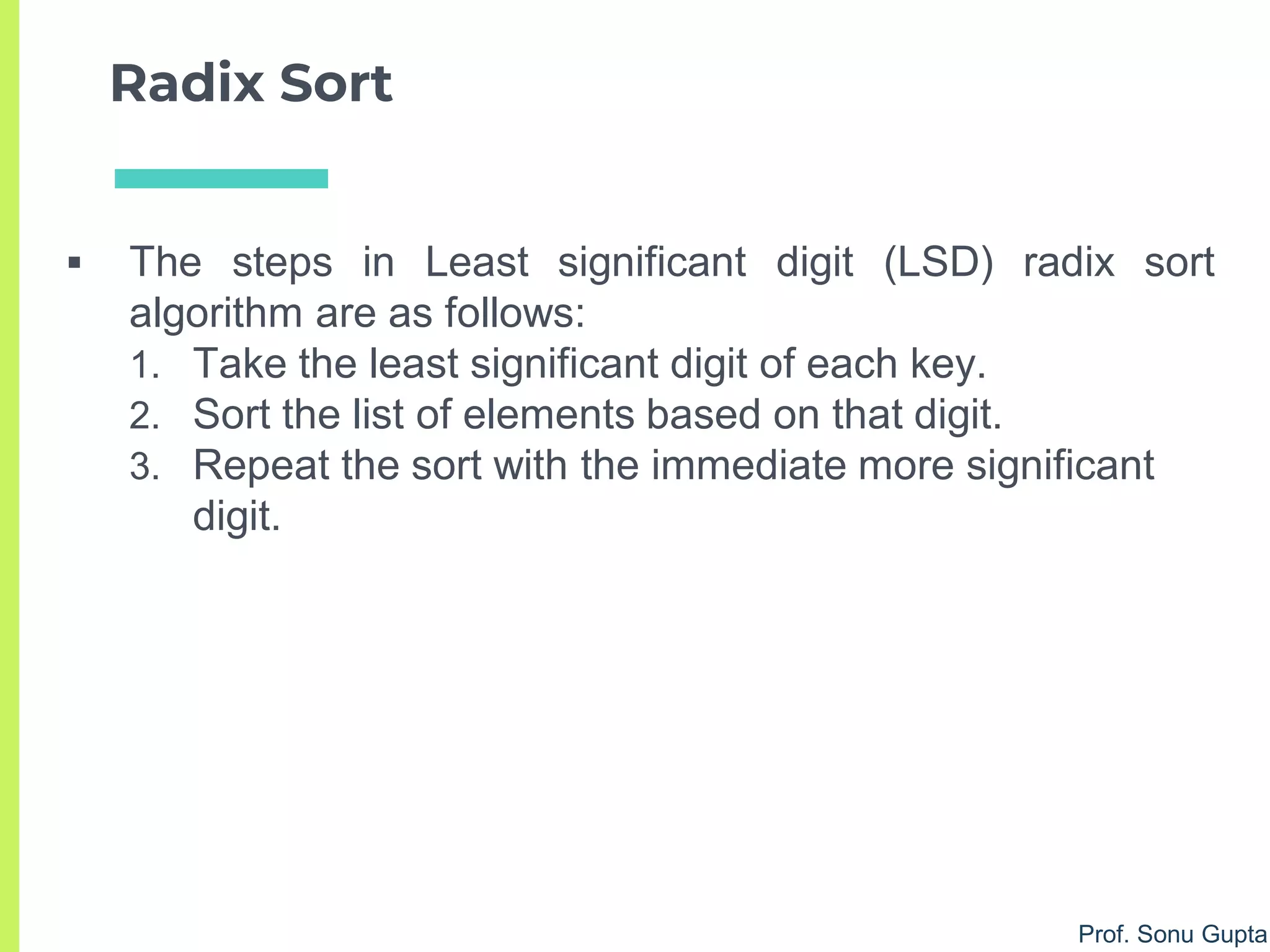
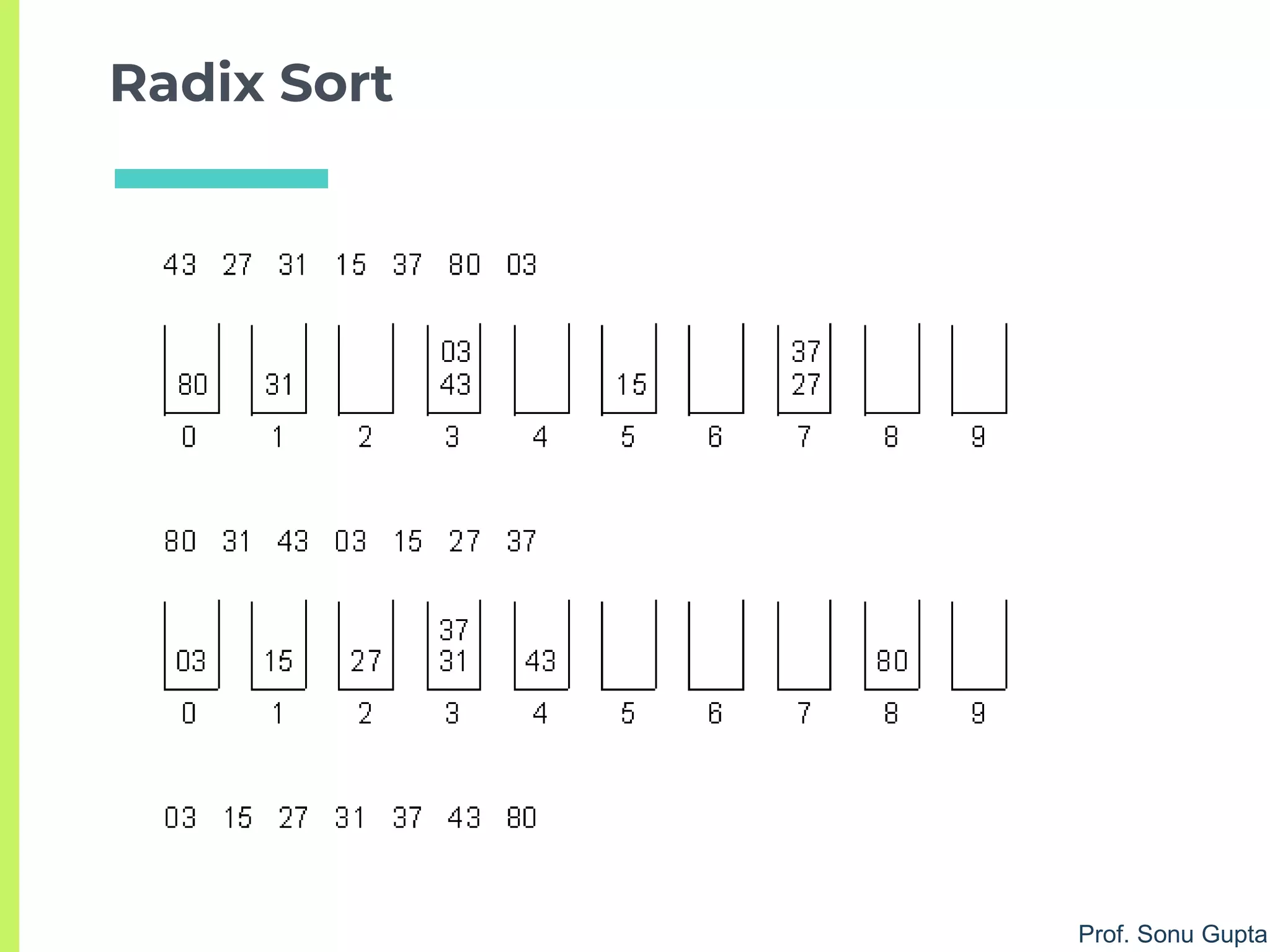
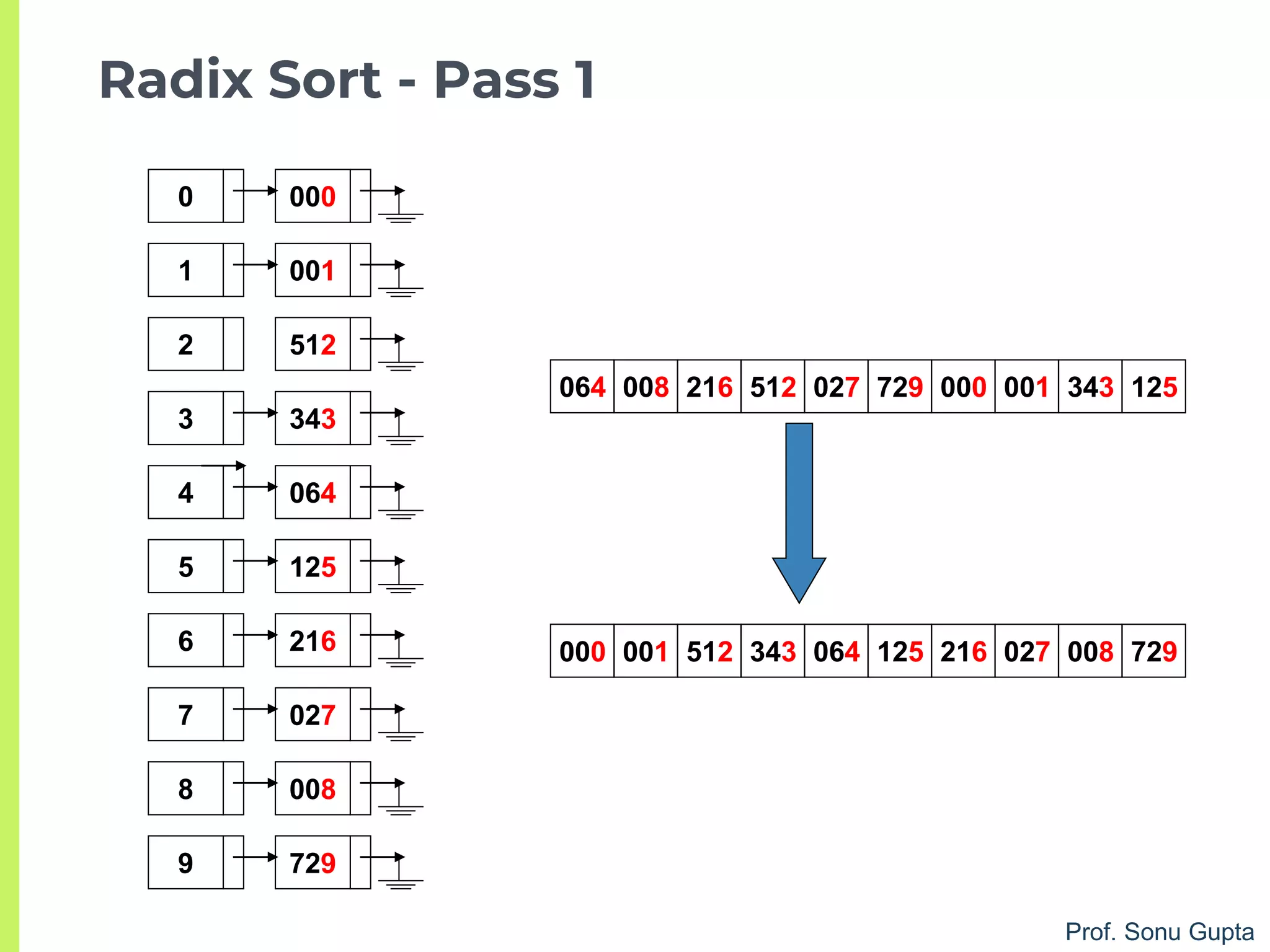
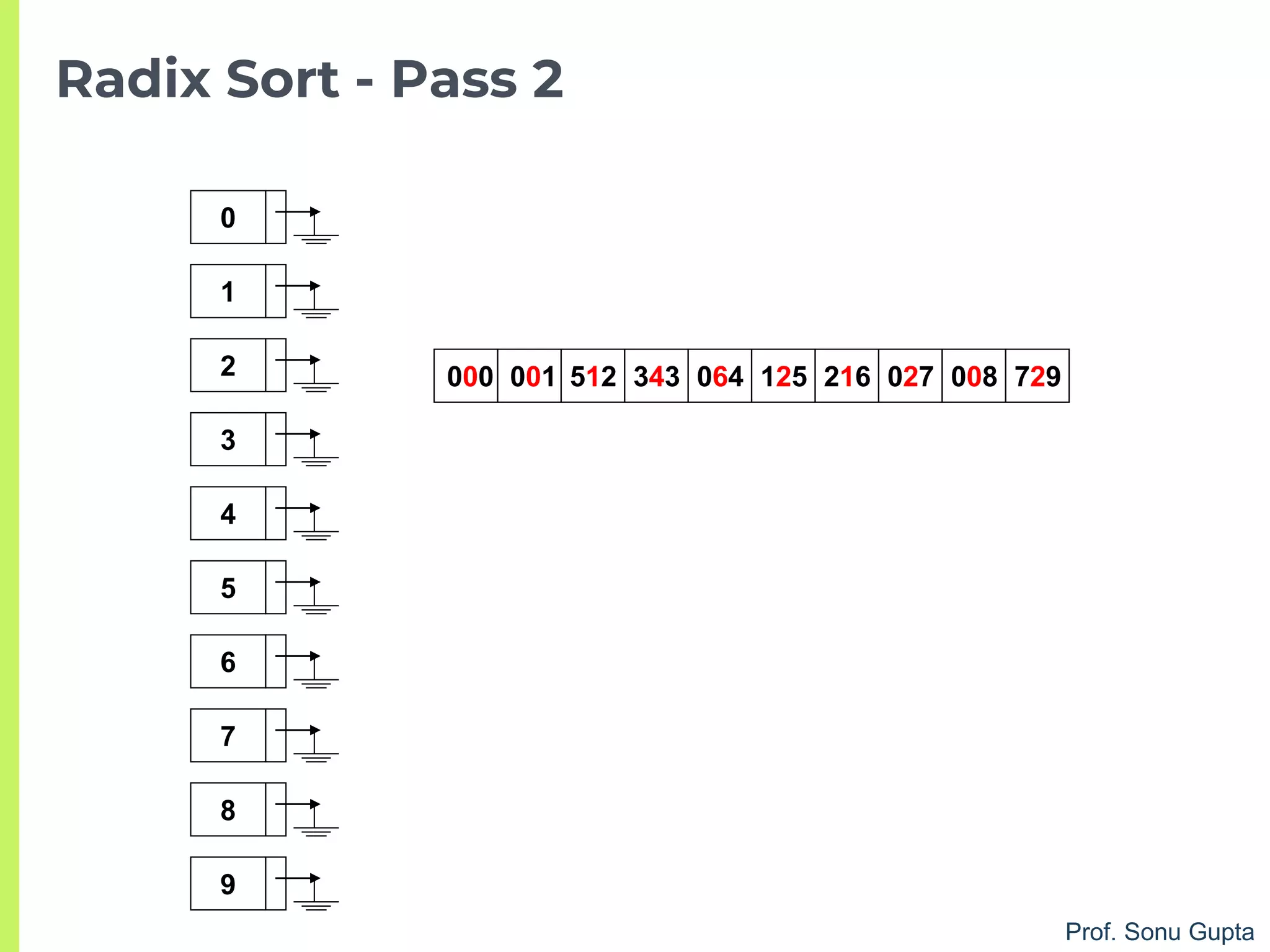
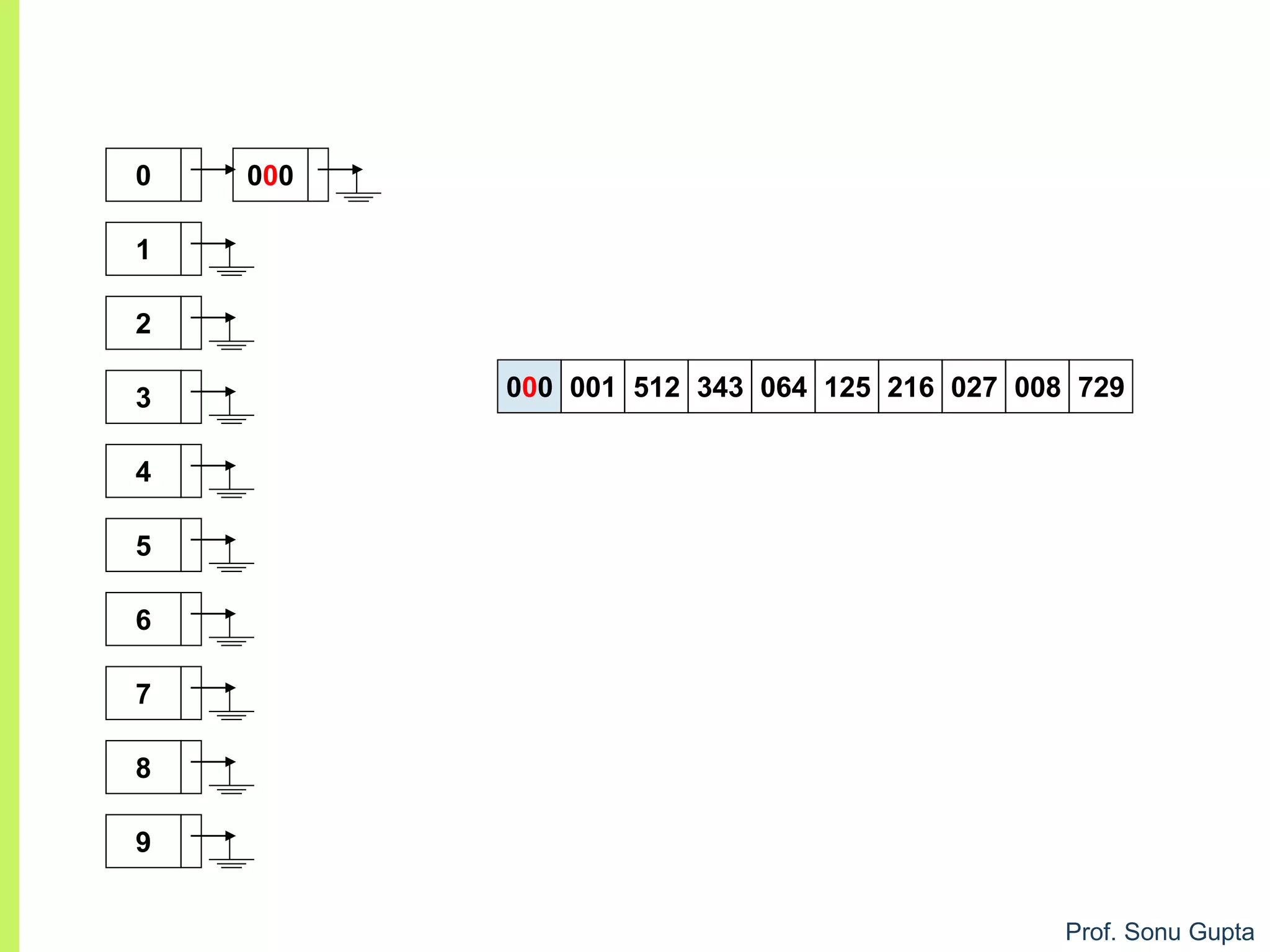
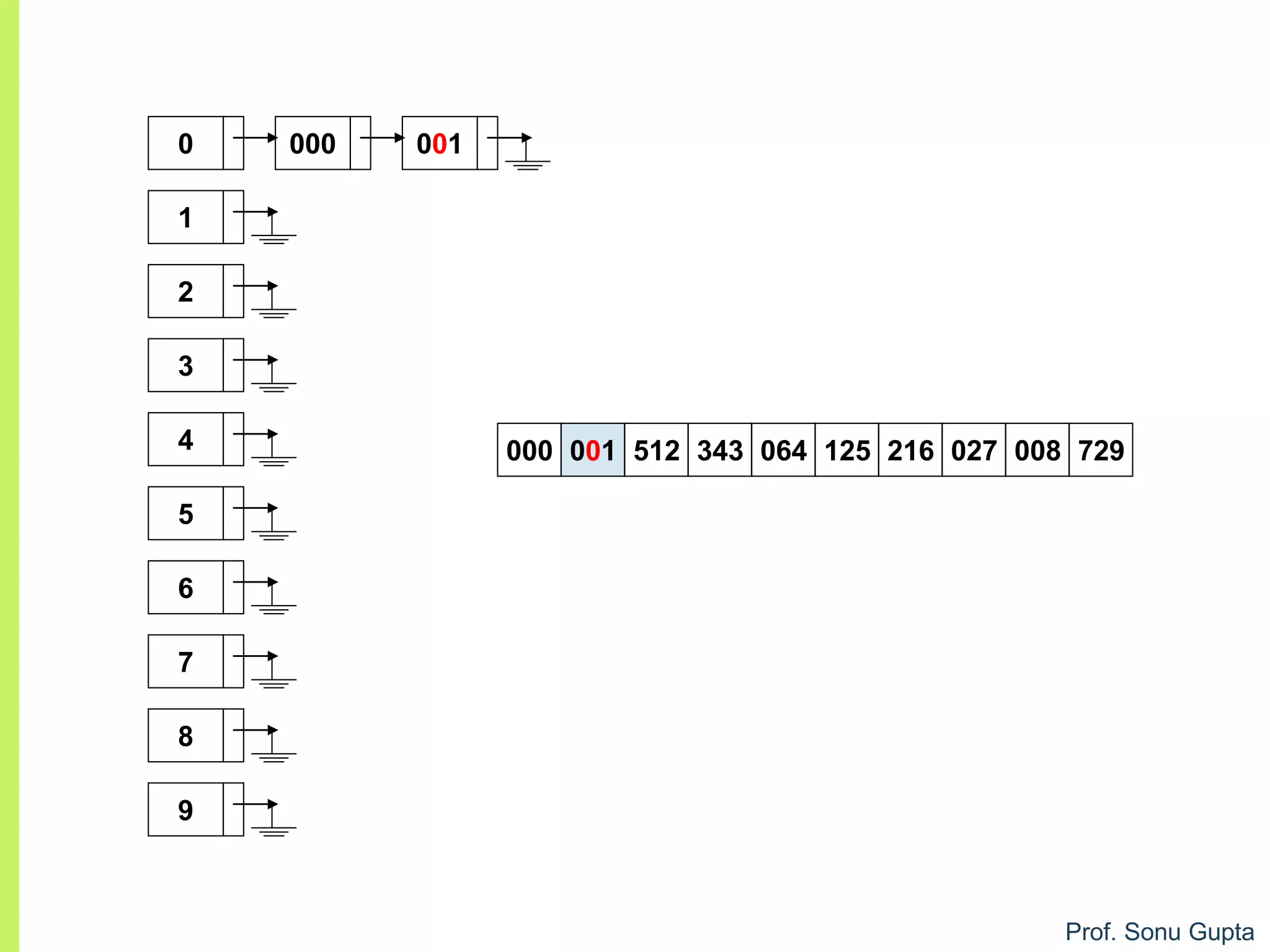
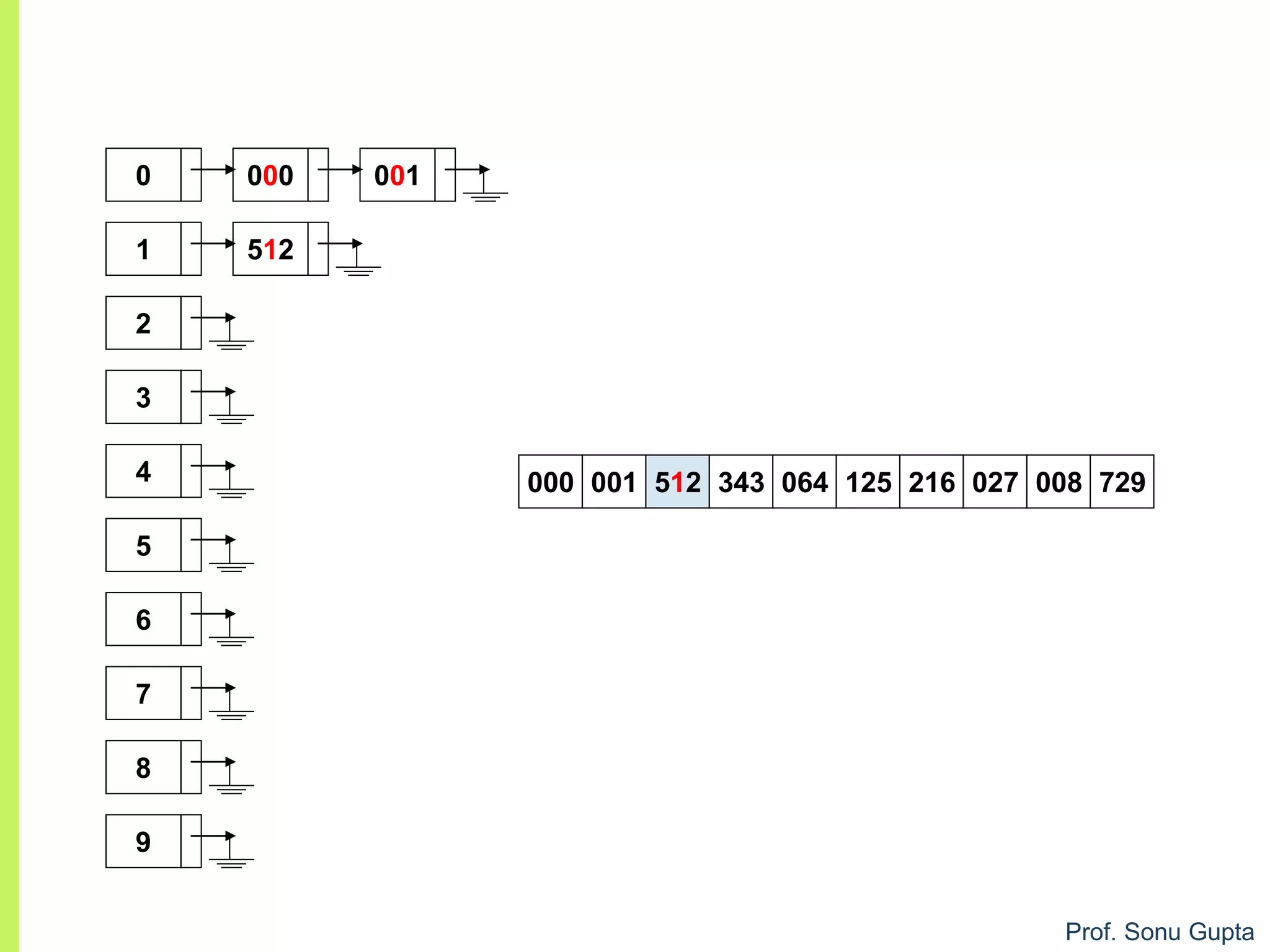
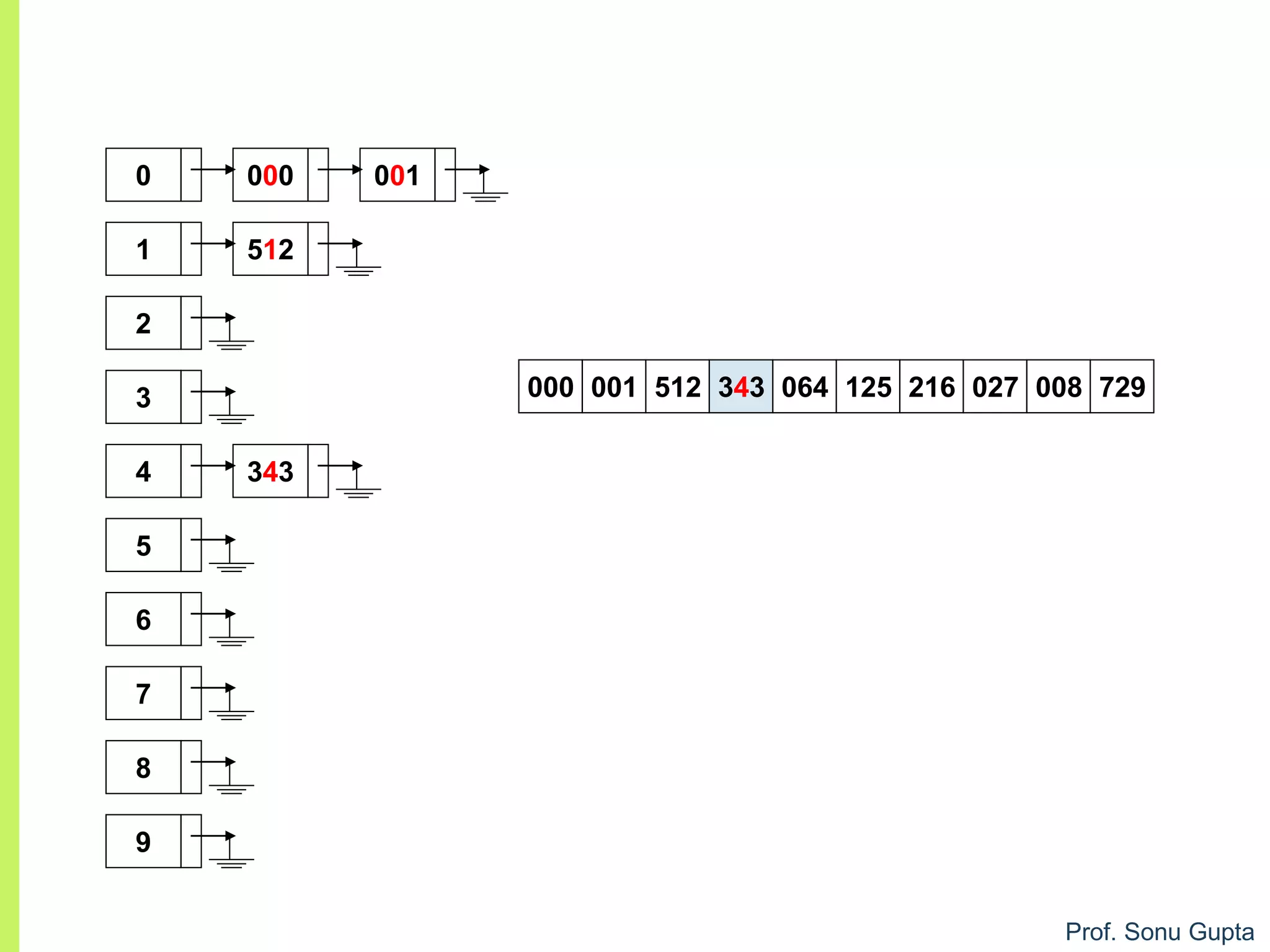
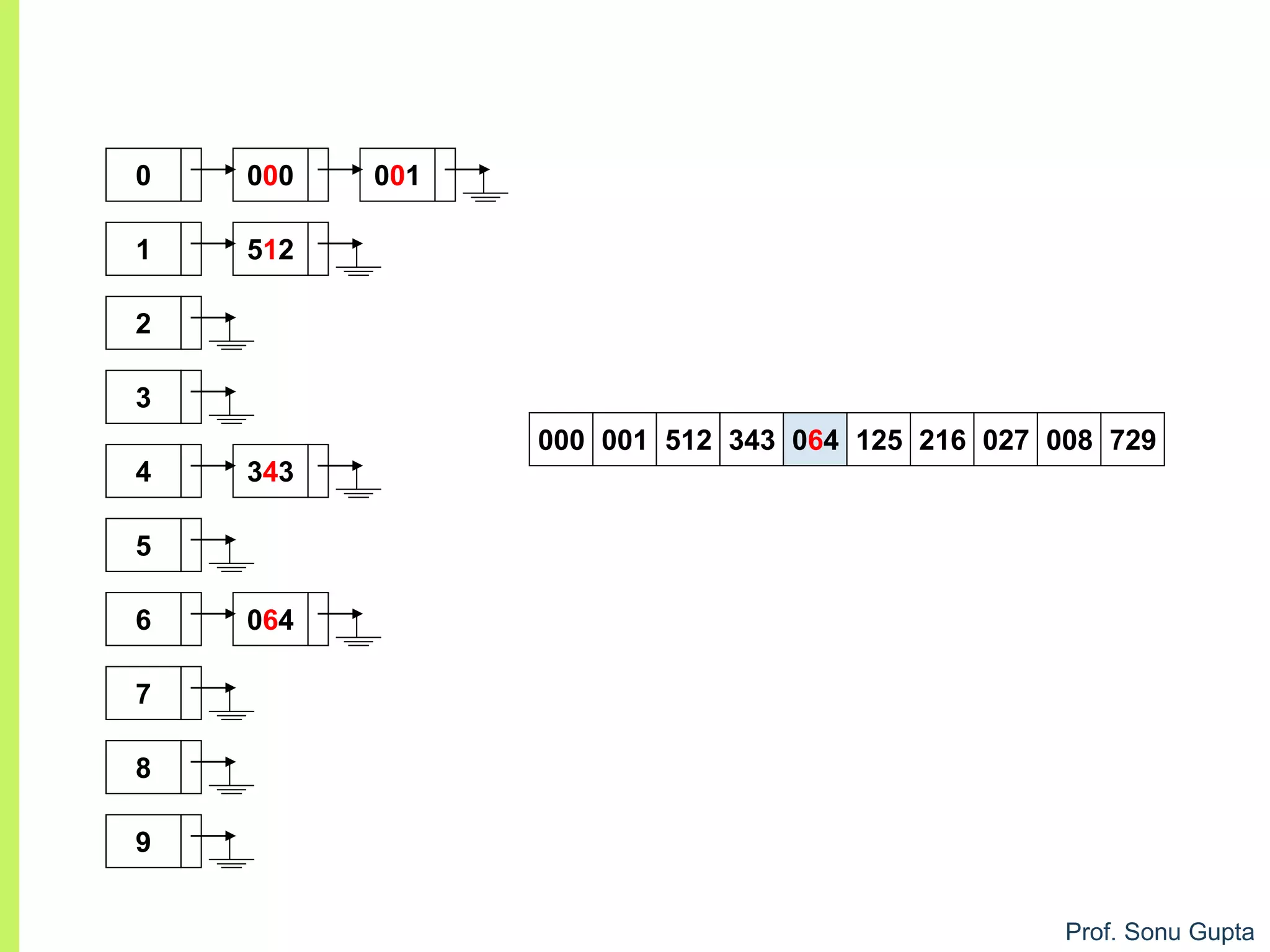
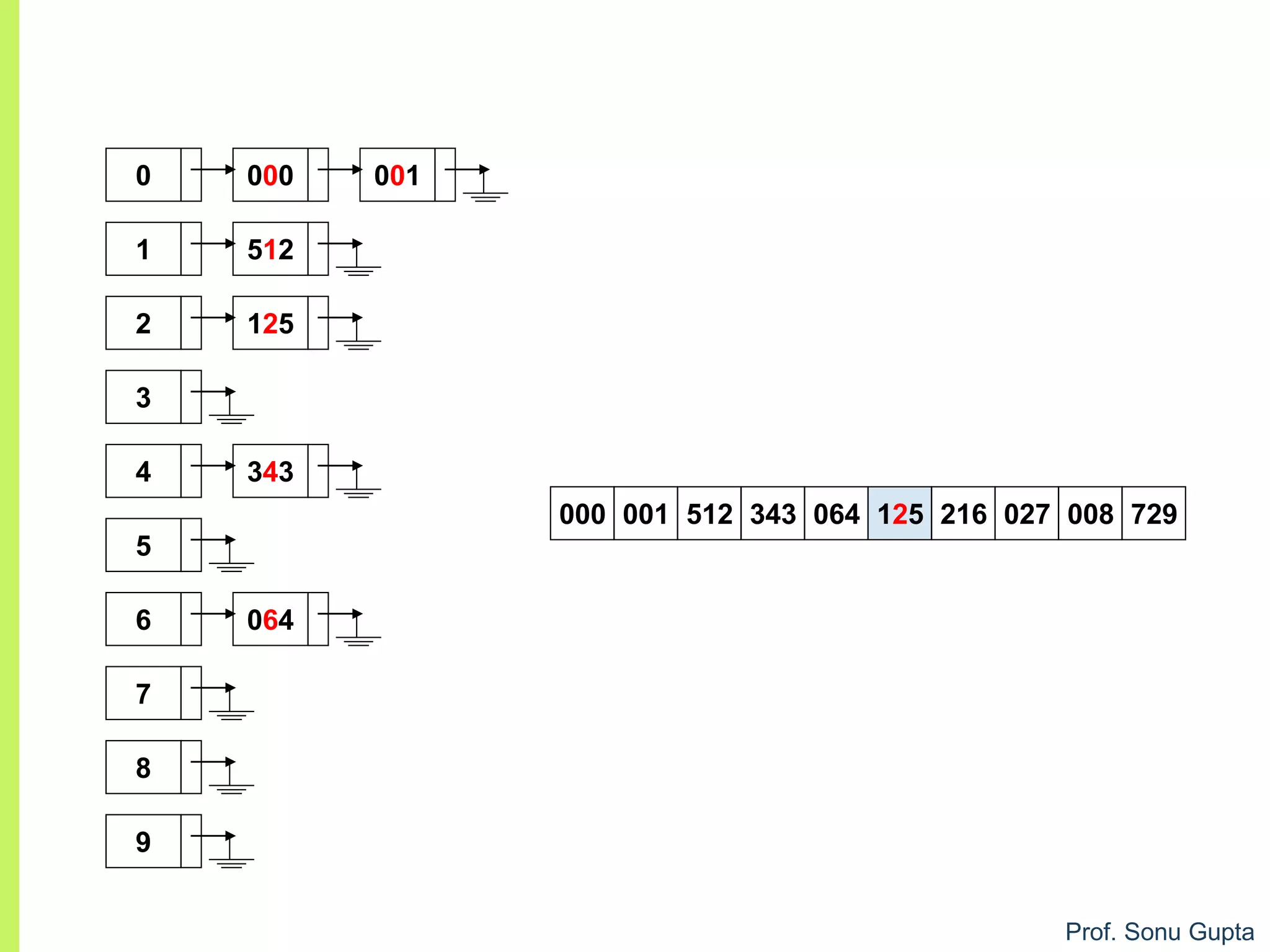
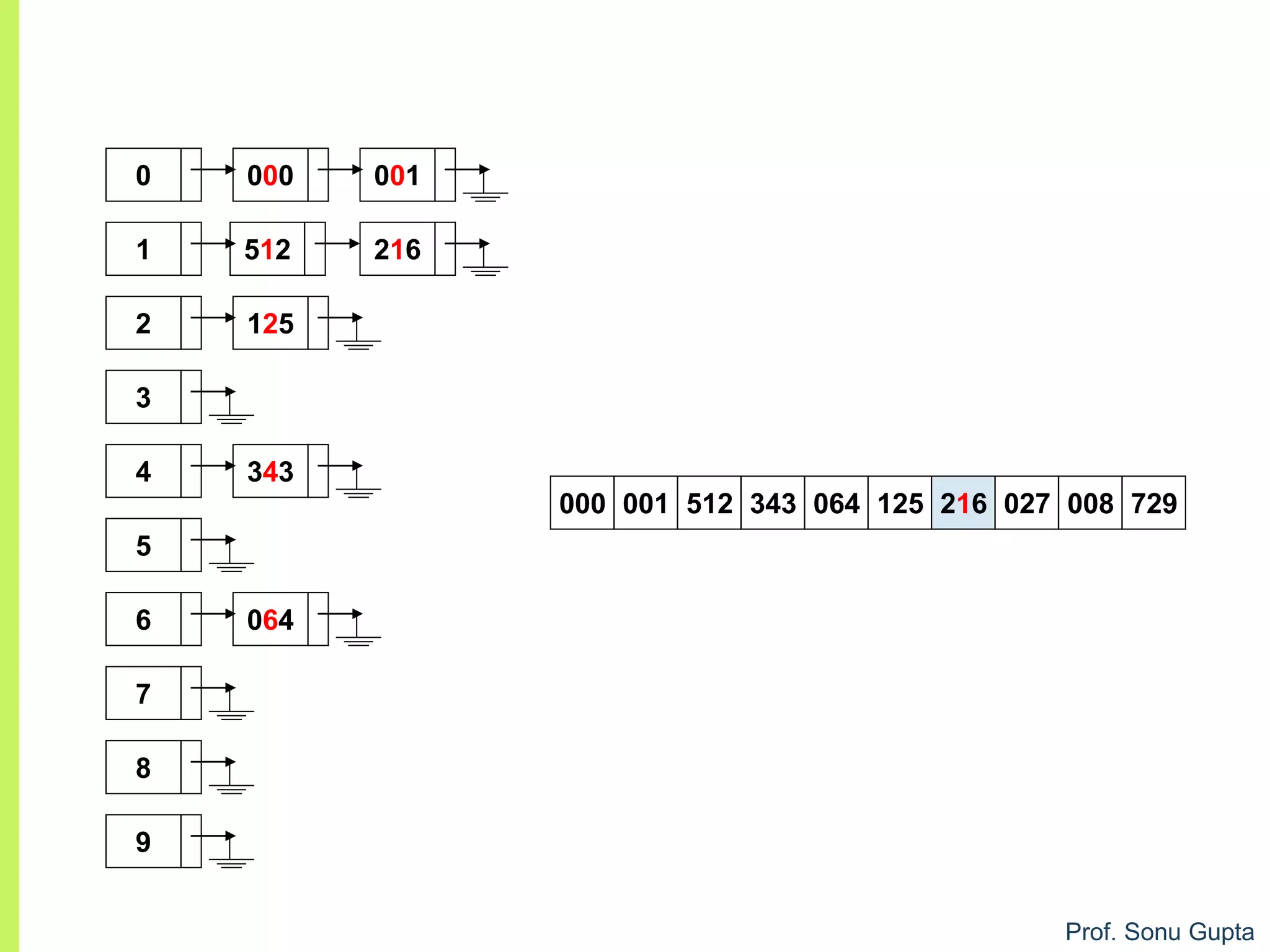
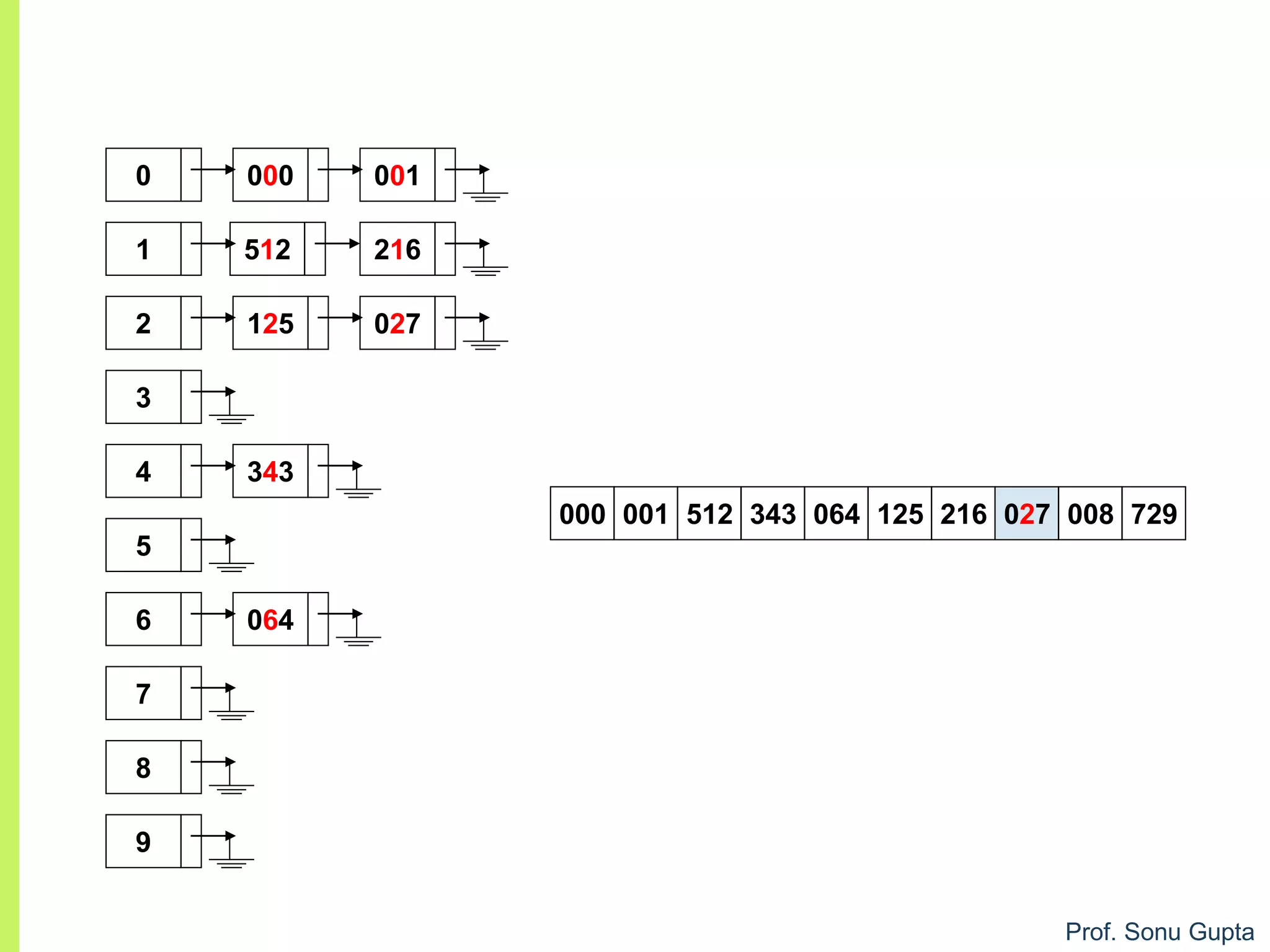
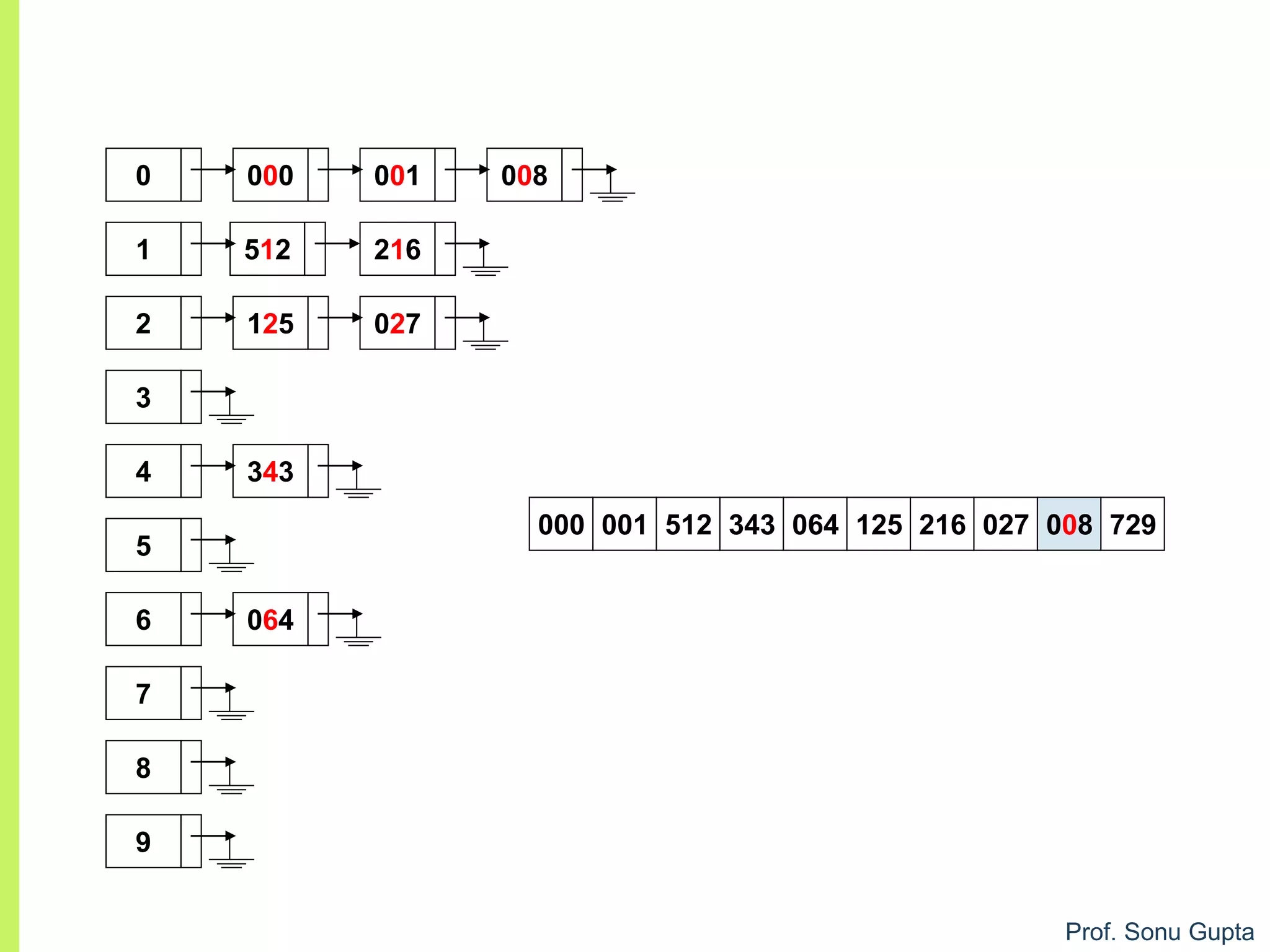
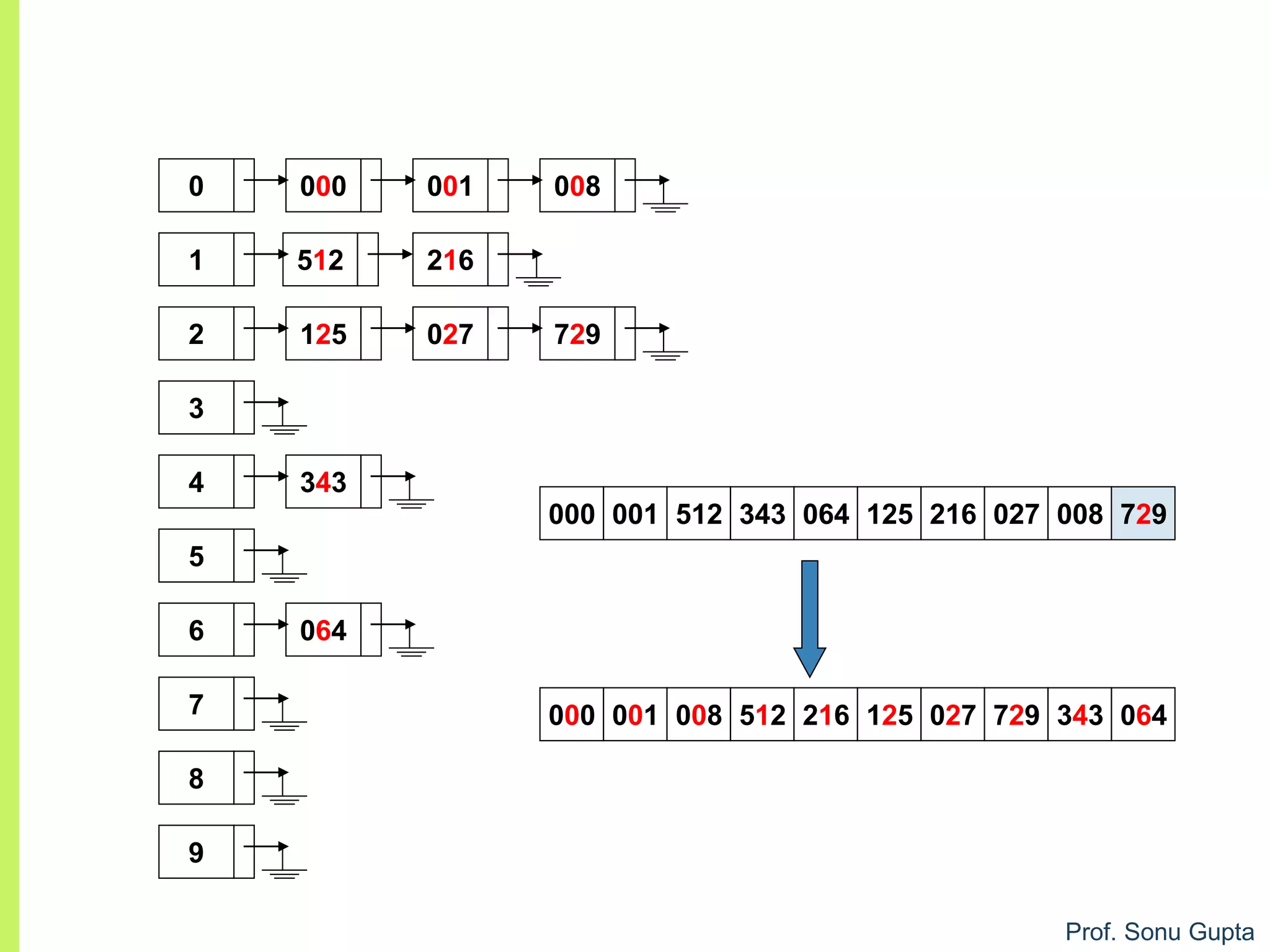
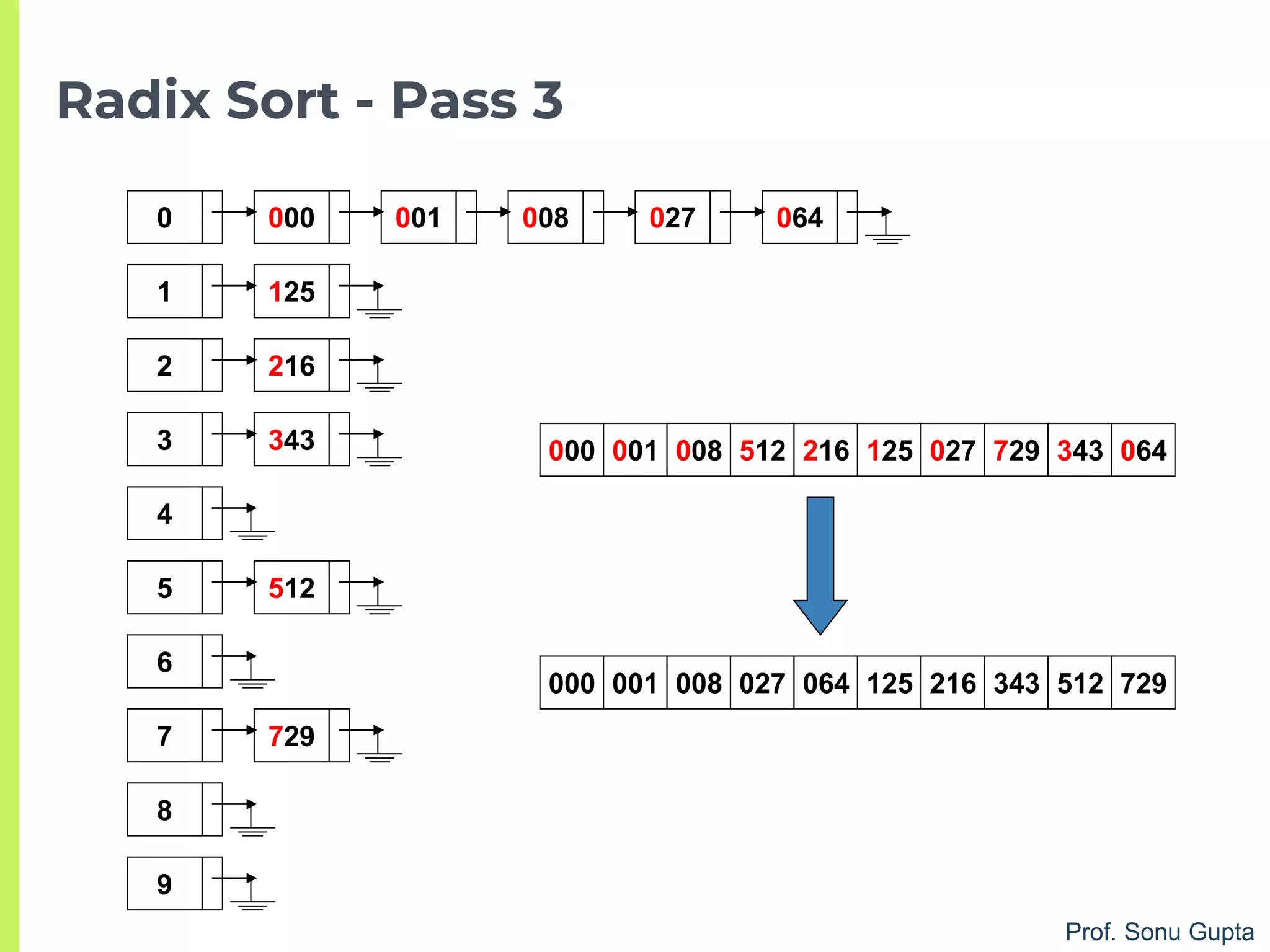
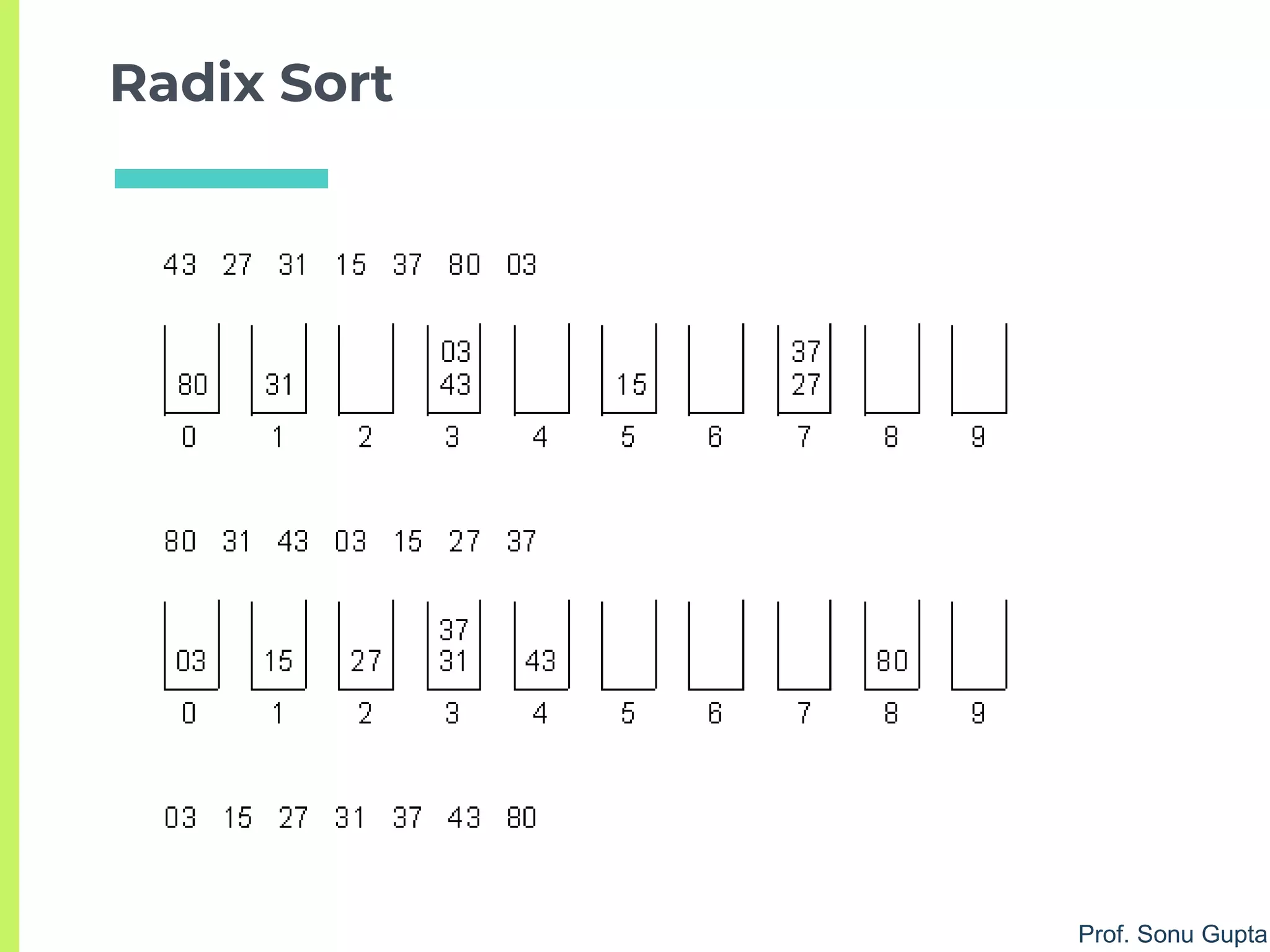
![Prof. Sonu Gupta
void arr :: sort(){
int bucket[10][10], buck_count[10];
int i,j,k,r,passes=0,divisor=1,largest,pass_no;
largest=a[0]; //Find the largest Number
for(i=1;i<n;i++)
if(a[i] > largest) largest=a[i];
while(largest > 0) //Find number of digits in largest number
{ passes++; largest = largest /10; }
for(pass_no=0; pass_no < passes; pass_no++)
{
for(k=0; k<10; k++) buck_count[k]=0; //Initialize bucket count
for(i=0;i<n;i++) //divide elements in bucket
{
r=(a[i]/divisor) % 10;
bucket[r][buck_count[r]]=a[i];
buck_count[r]++;
}
i=0; //collect elements from bucket
for(k=0; k<10; k++)
for(j=0; j<buck_count[k]; j++)
a[i++] = bucket[k][j];
divisor = divisor * 10;](https://image.slidesharecdn.com/2sorting-190122084642/75/Sorting-algorithms-82-2048.jpg)
![Prof. Sonu Gupta
0 1 2 3 4 5 6 7 8 9
0
1
2
3
4
5
6
7
8
9
bucket[10][10]
0 0
1 0
2 0
3 0
4 0
5 0
6 0
7 0
8 0
9 0
buck_count[10]
Largest = 80
Passes = 2
Initially](https://image.slidesharecdn.com/2sorting-190122084642/75/Sorting-algorithms-83-2048.jpg)
![Prof. Sonu Gupta
0 1 2 3 4 5 6 7 8 9
0 80
1 31
2
3 43 03
4
5 15
6
7 27 37
8
9
bucket[10][10]
0 1
1 1
2 0
3 2
4 0
5 1
6 0
7 2
8 0
9 0
buck_count[10]
After Pass 1
a[i] = [80, 31, 43, 03, 15, 27, 37]](https://image.slidesharecdn.com/2sorting-190122084642/75/Sorting-algorithms-84-2048.jpg)
![Prof. Sonu Gupta
0 1 2 3 4 5 6 7 8 9
0 03
1 15
2 27
3 31 37
4 43
5
6
7
8 80
9
bucket[10][10]
0 1
1 1
2 1
3 2
4 1
5
6
7
8 1
9
buck_count[10]
After Pass 2
a[i] = [03, 15, 27, 31, 37, 43, 80]
a[i] = [80, 31, 43, 03, 15, 27, 37]](https://image.slidesharecdn.com/2sorting-190122084642/75/Sorting-algorithms-85-2048.jpg)
